Across Country Artist Camp with John R Walker
ACROSS COUNTRY Artists’ Camp and Exhibitions
We acknowledge that we meet and paint on the land of the Ngadjuri peoples.
We pay our respects to their elders past, present and emerging.
ACROSS COUNTRY is a multi-faceted project including the following:
Burra and related works on paper exhibition by John R Walker in the main gallery, 18 May to 18 July 2021
Artists’ Camp at Pitcairn Station South Australia from 24 to 28 May 2021
Exhibition of works produced during the Artists’ Camp in the Bence Room, 3 June to 18 July 2021
Daily Blog…an unfolding, episodic account of the camp
SUNDAY 23 May – Arrival at Pitcairn Station
Collective noun of the day: an aspiration of artists
The artists’ convoy of cars arrived at 2.30pm. We could see the dust trail for miles. Once settled into their quarters, John took them on an orientation walk: up the track past the water tank on the hill behind the shearers quarters and further up a series of low ridges to where they could see a 360 degree view, locating the homestead, shearers quarters, Porcupine Well and the ridge which marked the eastern boundary of the property. We then walked down to Porcupine Well and along Manunda Creek bed to near the Woolshed. John showed them the Chinese book he had painted on this spot the day before to give them a sense of how to approach the use of the books and seeing the landscape over time.
Camp artists include Cait Wait, Lisa Smedley, Jake Novick, Alison Laycock, Penny Campton, Denise Officer, Kerry Youde and Julie Lloyd with artist/mentor John R Walker. We were also joined by cooks, Justine Thomson and Graeme Endean, assistants Jess and Taylah Brewster and wordsmith Anne Sanders.
Dinner at 7pm was welcome. Many of the artists had driven long distances to get to Pitcairn Station and the anticipation increased their hunger. Menu: delicious and generous roast chicken with coconut rice, sweet potato and green beans, followed by baked quince in custard. Denise briefed everyone on the ‘do’s and dont’s’ of the facilities and water usage in this very dry marginal country. Its had to believe that this country supported large sheep runs and the no-one seemed to take any notice of Goyder and his line.
The artists were briefed on the first day’s (tomorrow) camp down at Dinny O’Brien’s Camp, with the plan that they would leave Pitcairn at 8.30am, with Anne and John leading the car convoy. John emphasised the point that the artists were here to enjoy the process and experimentation, and not to worry too much about the future outcomes.
There’d been a low pressure weather change coming for a few days now. It was evident as the artists sat around the campfire after dinner. The moon – about 3/4 to full – was veiled in a misty halo. No stars tonight. Callitris (native pine) logs thrown on the campfire emitted a familiar, resinous scent, mixed with red wine and lots of talk and laughter. Anticipation mixed with some trepidation – what to expect, what was this country like?
Quotes:
Julie Lloyd: “As we drove in over the first range of hills, you could see the expanse. It was mind blowing. I would have liked to have hit the brakes and taken photos but I had six cars up my bumper. That was my first ‘wow’ moment.”
Lisa Smedley: “I was so excited to be back in this wonderful country. The sky, the desert, stations, horses and stones. It’s fantastic.”
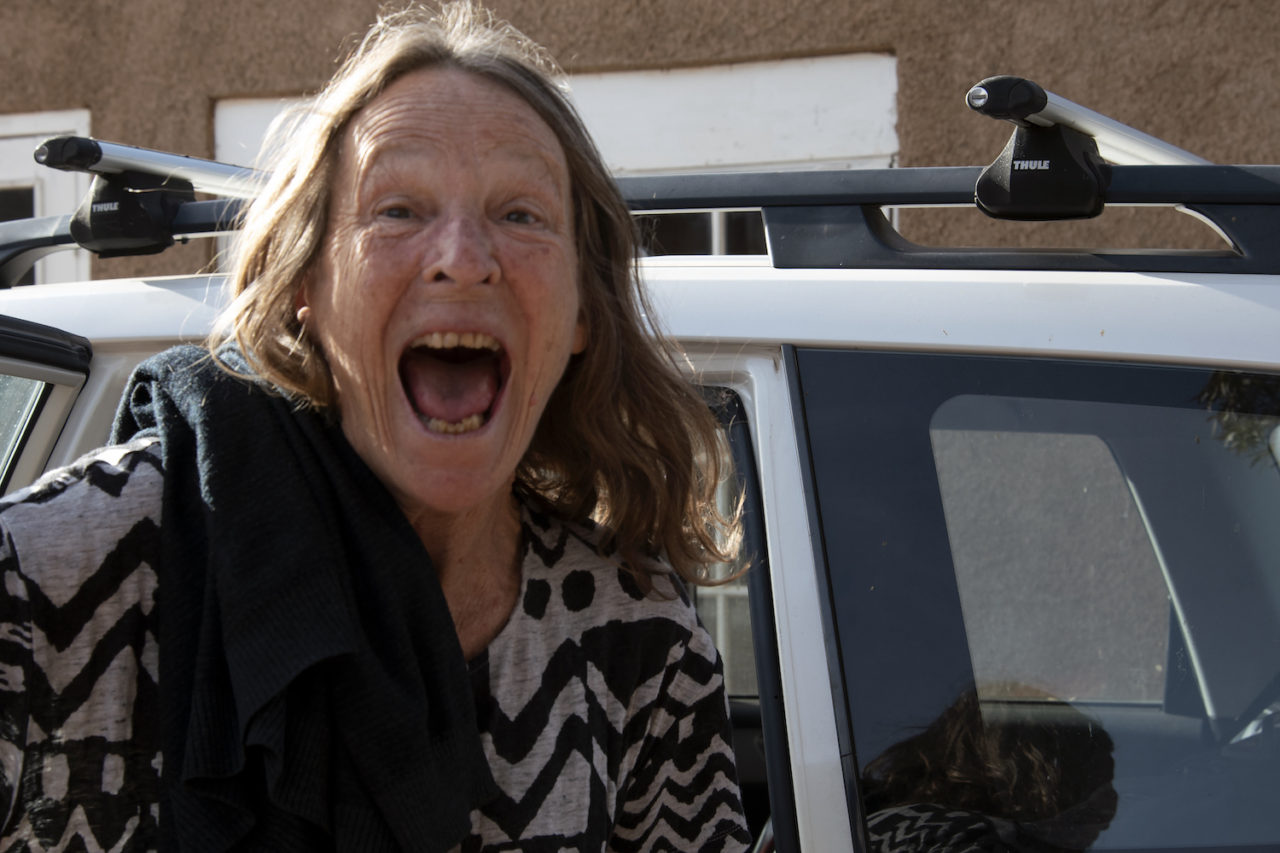
Penny
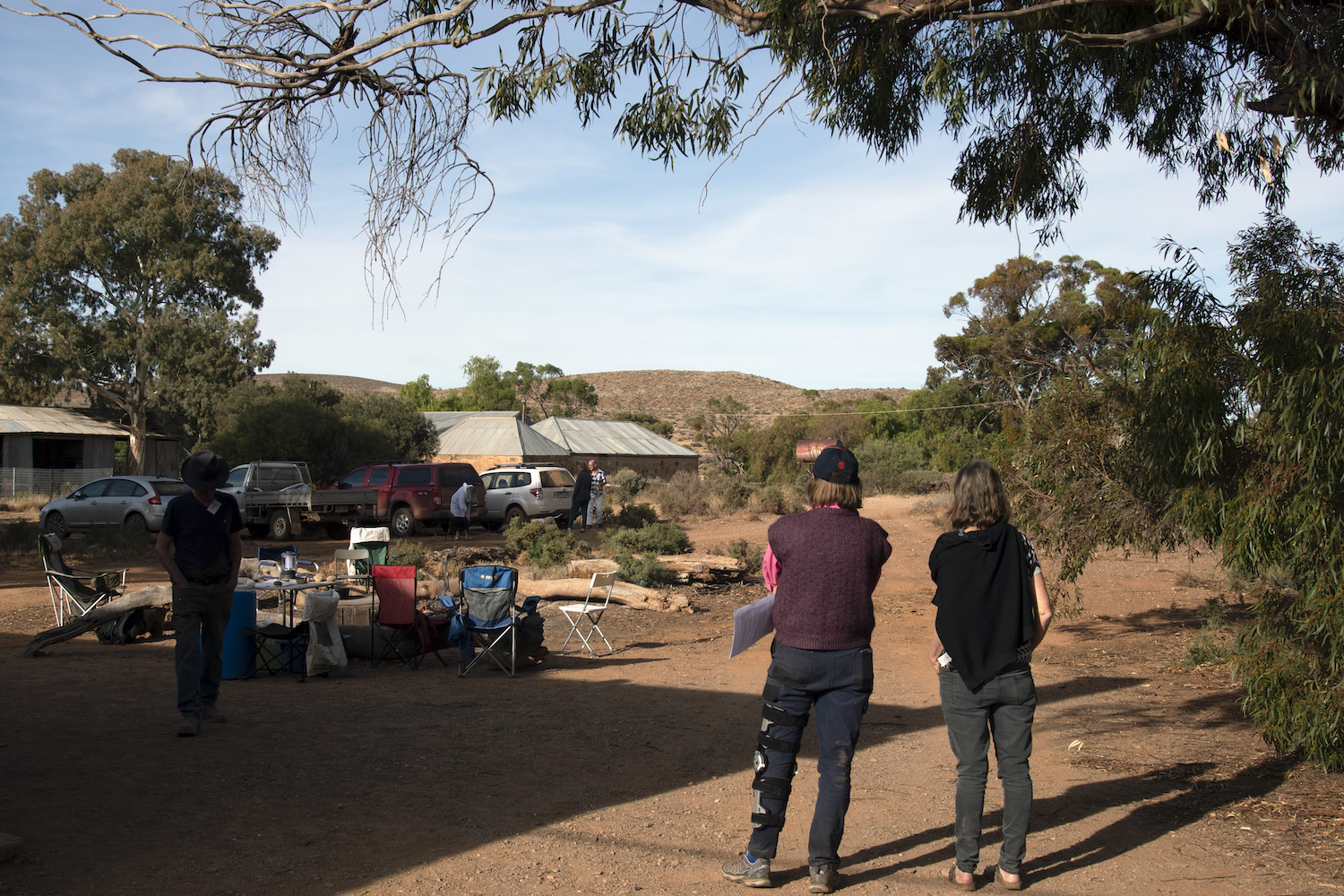
Cars
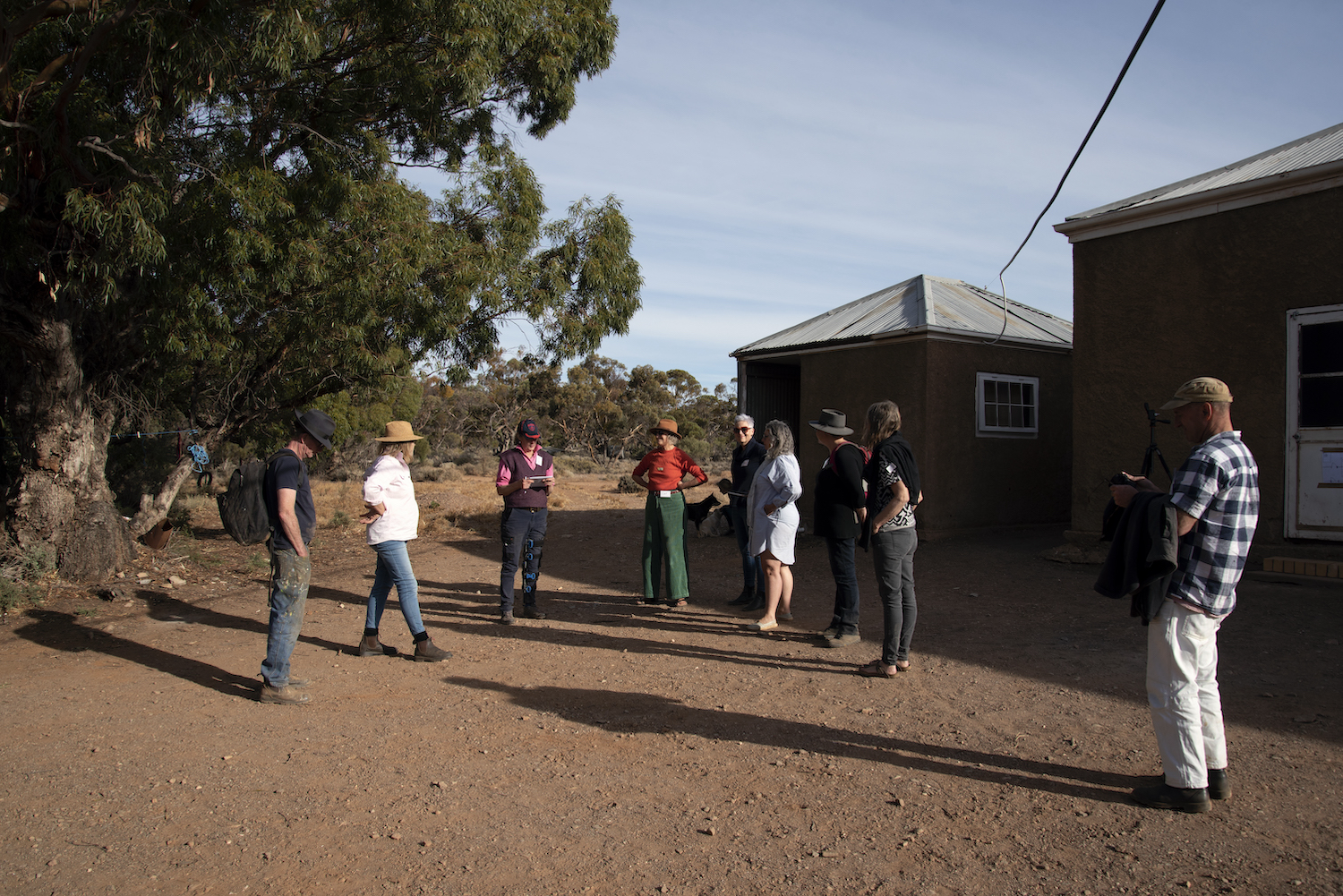
assembling
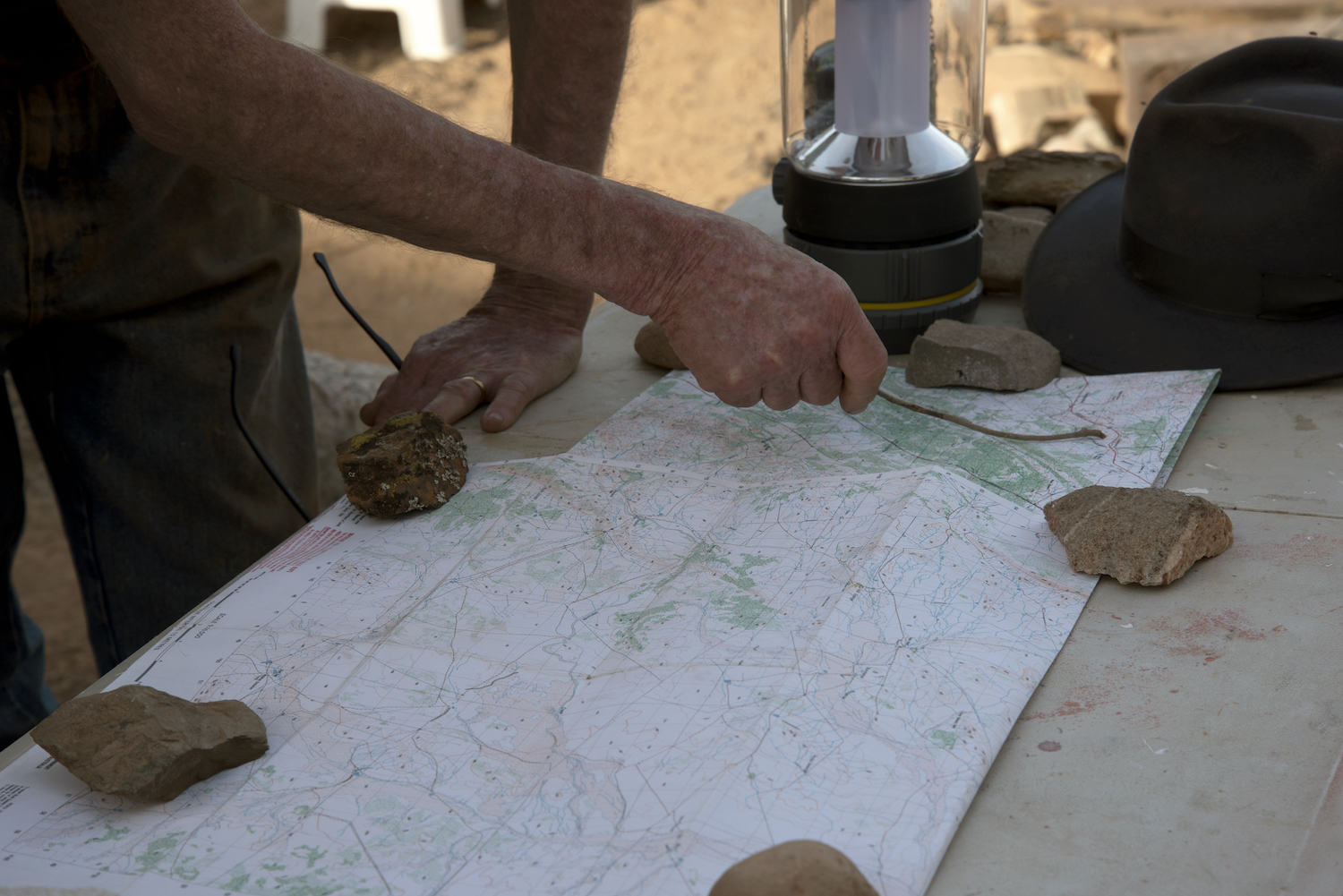
looking at map
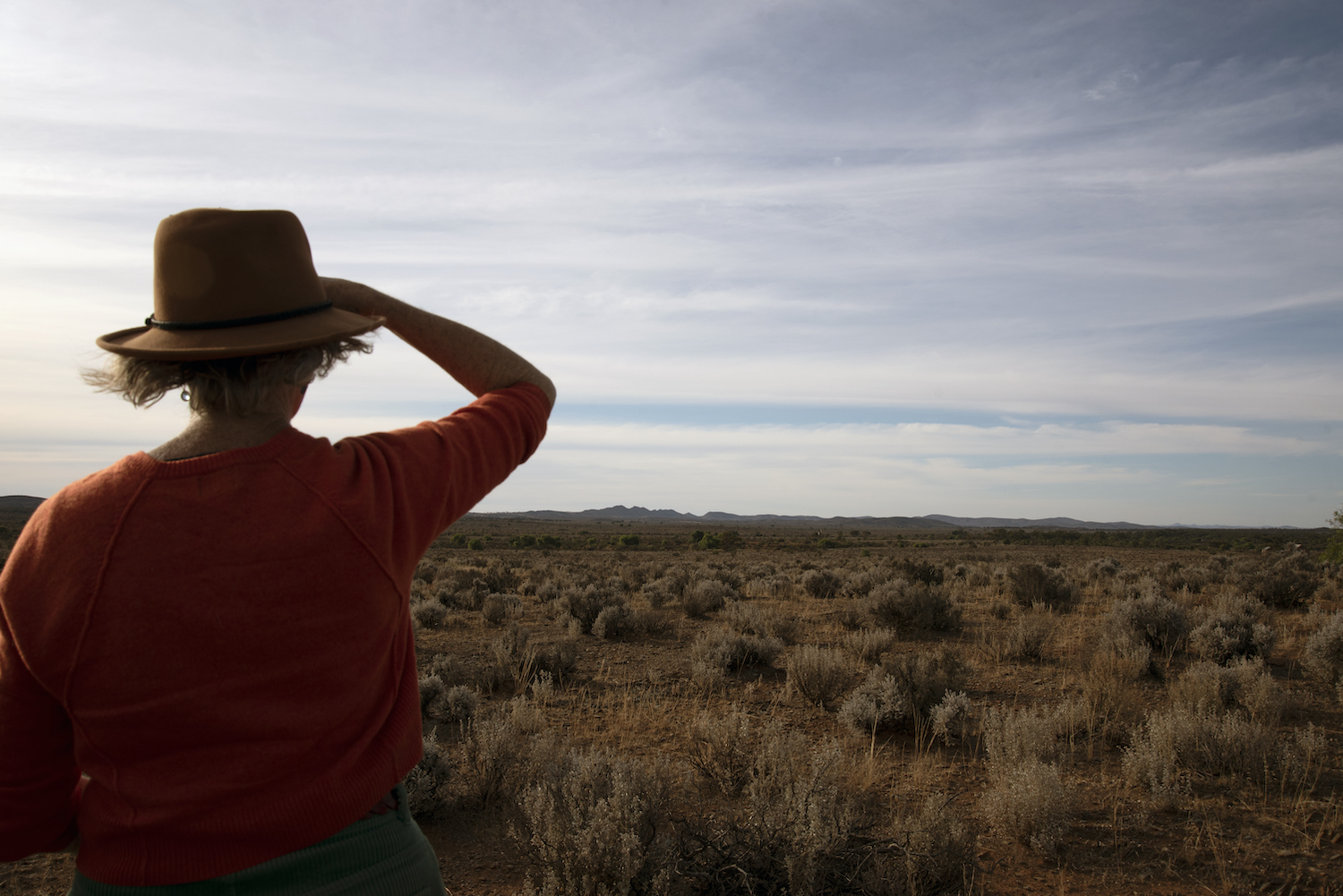
Cait looking out over range
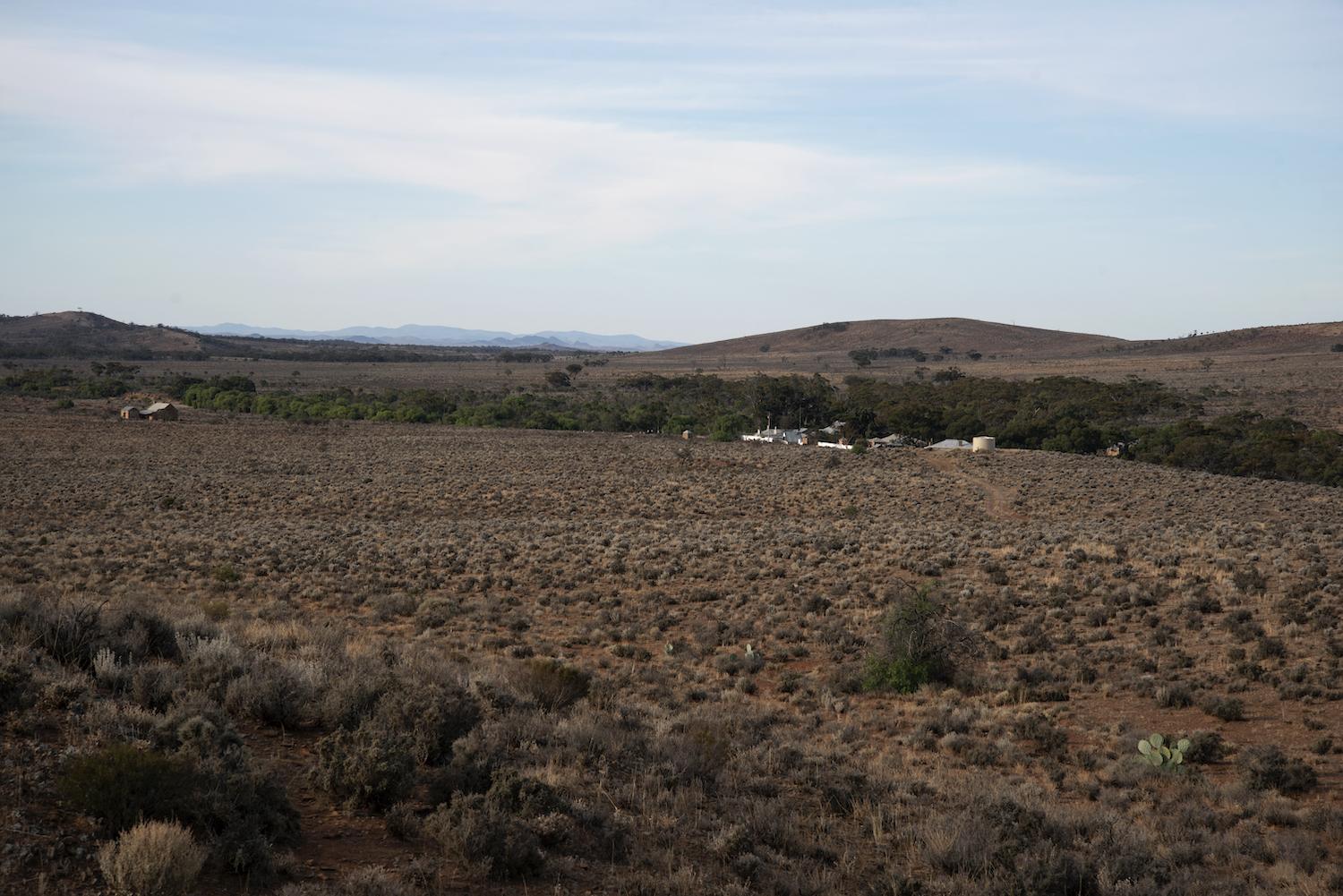
view down to homestead complex
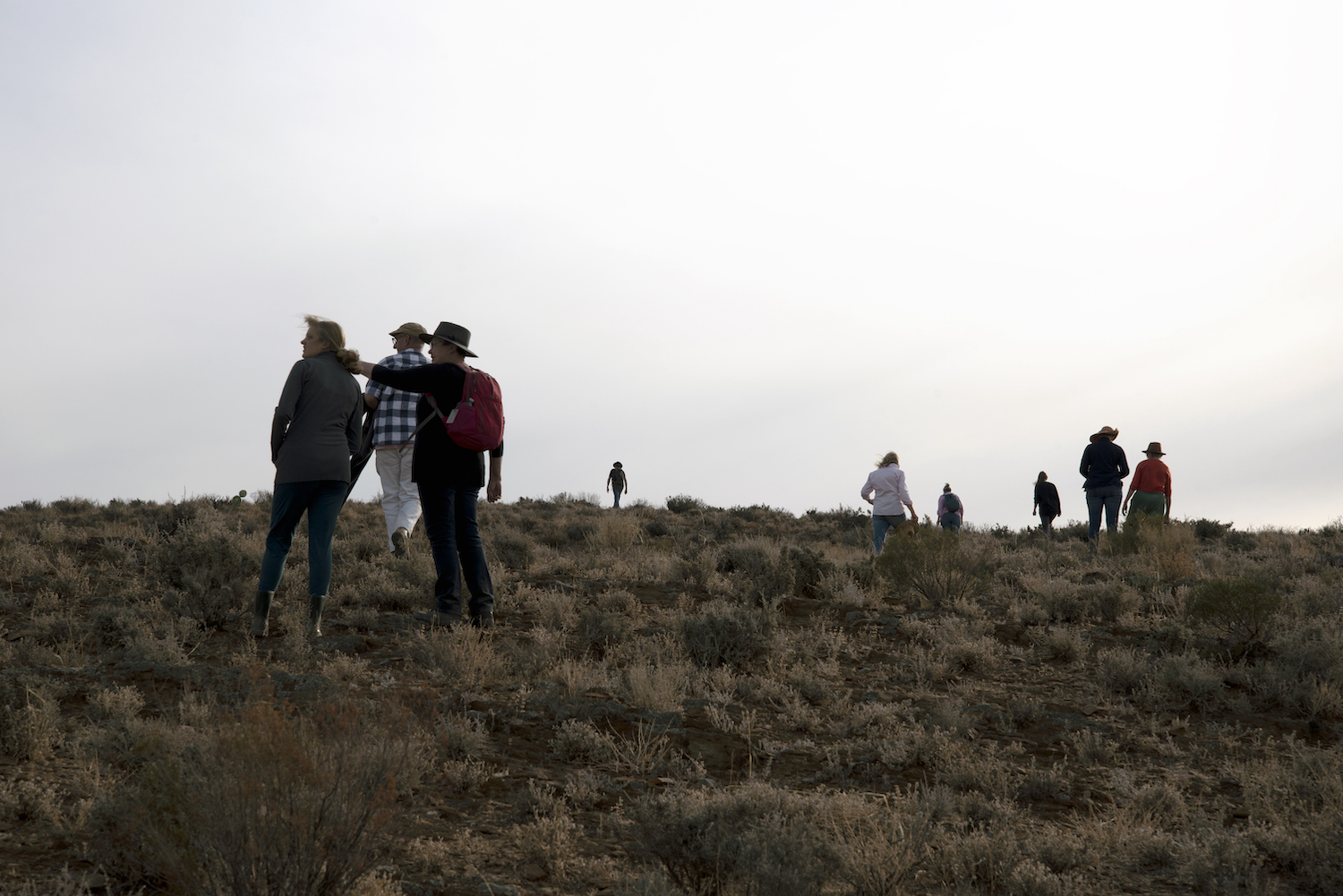
walking up the ridge
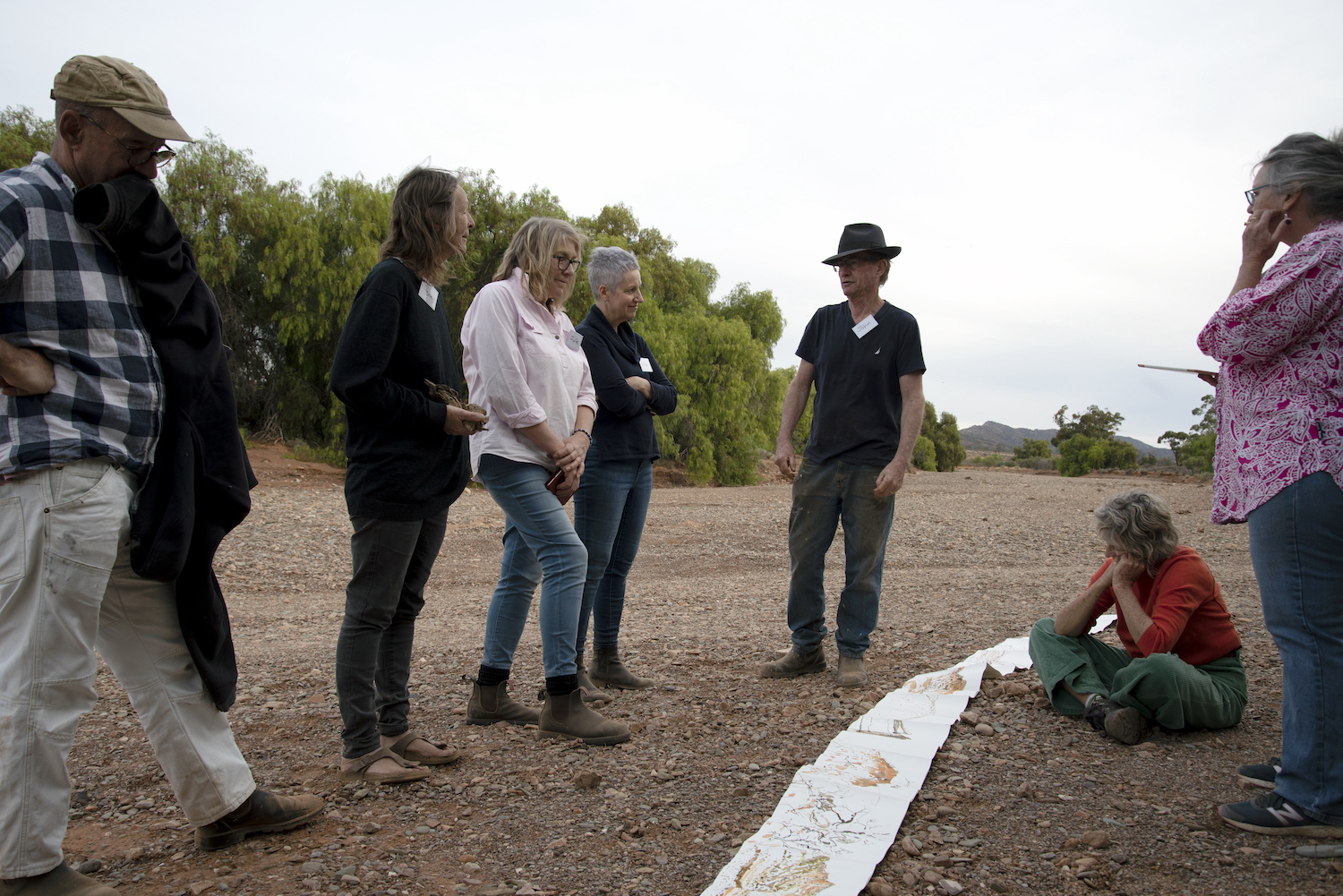
John R Walker with his Chinese artist book in Manunda Creek bed
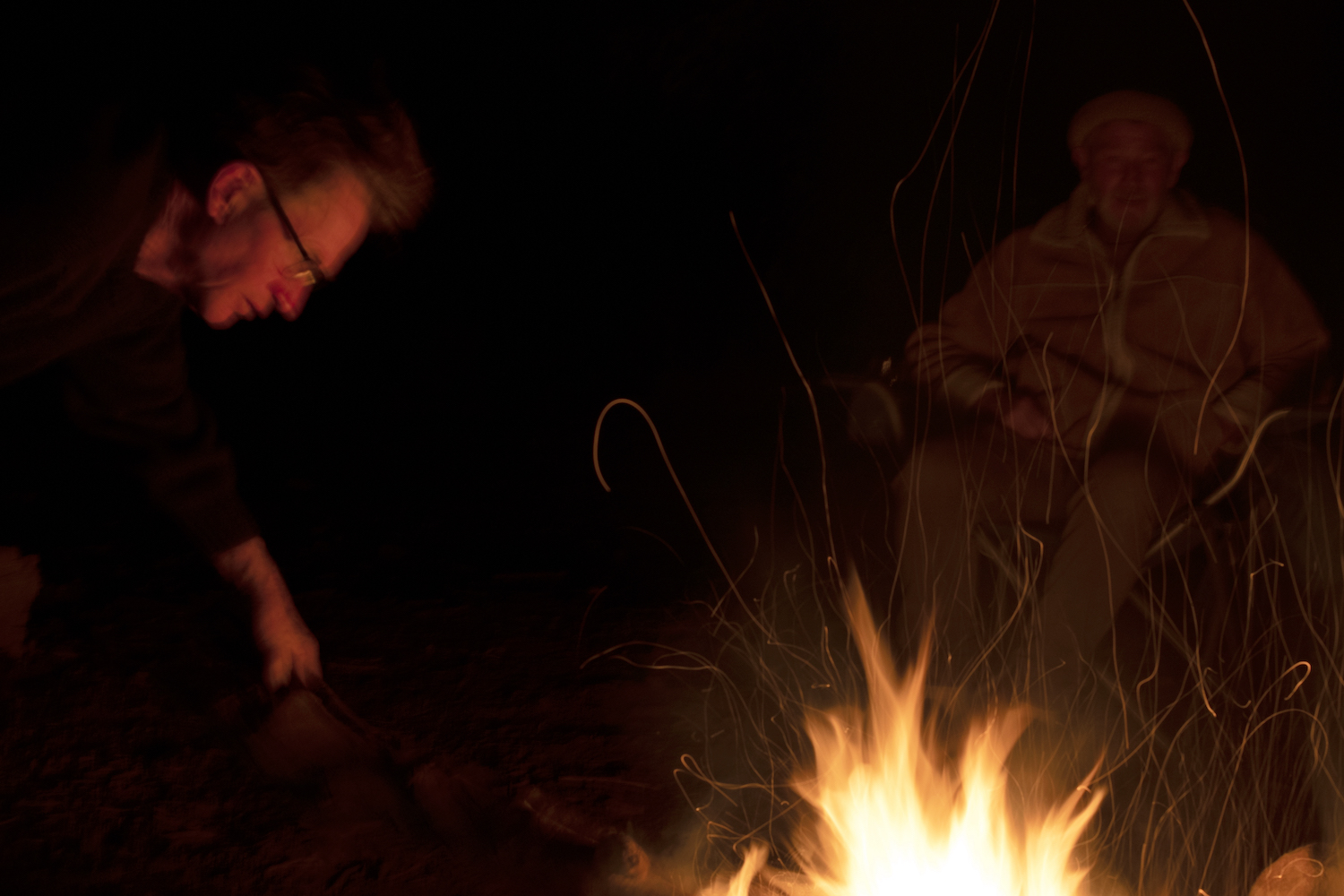
John R Walker in campfire
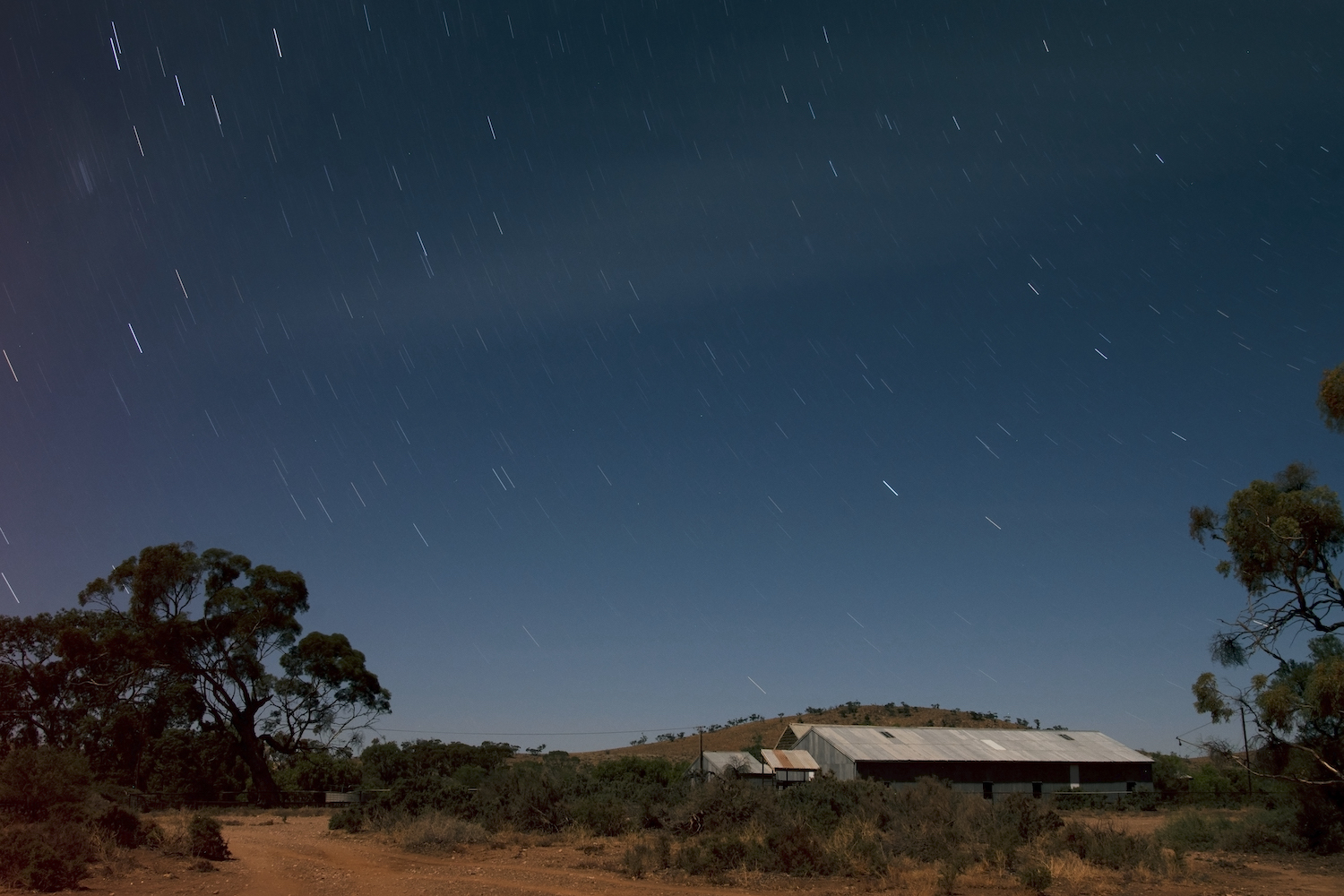
Woolshed in starlight
Day 1 MONDAY 24 May – site: Dinny O’Brien’s Camp and creek bed
Collective noun of the day: an odyssey of artists
Day dawns cooler, the anticipated weather has arrived, though no rain. First light and then the rosy-fingered dawn colours the sky, birds stir quietly at first and then the chorus rises. The smoke from last night’s fire drifts slowly upward until the hot coals are fed some sticks and it burst into life, ready for the morning gathering. There is a high thin cloud cover.
Everyone rose early, showered, breakfasted and were ready by the appointed time. Anne and John drove out early with Julie Lloyd in her ute, taking the artists’ chairs and packs, including Denise’s fold-out table for her to work on. Yellow ribbon was tied to the tree indicating where to turn and meet us. The convoy stopped at the large petroglyph rocks on the way in. The age of the petroglyphs is unknown, but there are clear indications that it is a kind of map of country. There are repeated double circles. On looking up we noticed two very distinct Cone knolls (or ridges) just over the creek which may have been referenced in the petroglyphs.
Arriving at the wash-away – a camp now used by goat hunters and wood cutters but named originally for a failed hermit though reasonably successful vernacular poet and songwriter Dinny 0’Brien – we found Dinny’s remnant, rusty metal bed frame. The artists walked down to the creek bed, chose their sites and set up their materials. A full and intense day of working, broken by excellent morning and afternoon teas and lunch provided by our chefs, Justine and Graeme on site. Artist/mentor John, checked in with the artists regularly while also working on his own material. Kerry Youde spent a lot of time photographing the site, artists’ working and the surrounding ridges, providing excellent documentation. Some artists tried using the Chinese books for the first time.
We decamped to our quarters by 4.30pm. Ross returned and gave a short introduction to the history of Dinny’s camp, followed by a full show and tell of works by all the artists. All agreed it was a great beginning to the camp, and a productive day for all.
Quotes:
John: “Don’t be afraid to push the chroma and hue up… the quality of light around here has a hum.”
Jake: “It’s been good. I’ve enjoyed jumping in the deep end and doing it”.
Lisa: “It was all very scary for me…so I went and had a look at a paddy melon, always go for the botanics… Colour is what drives me.”
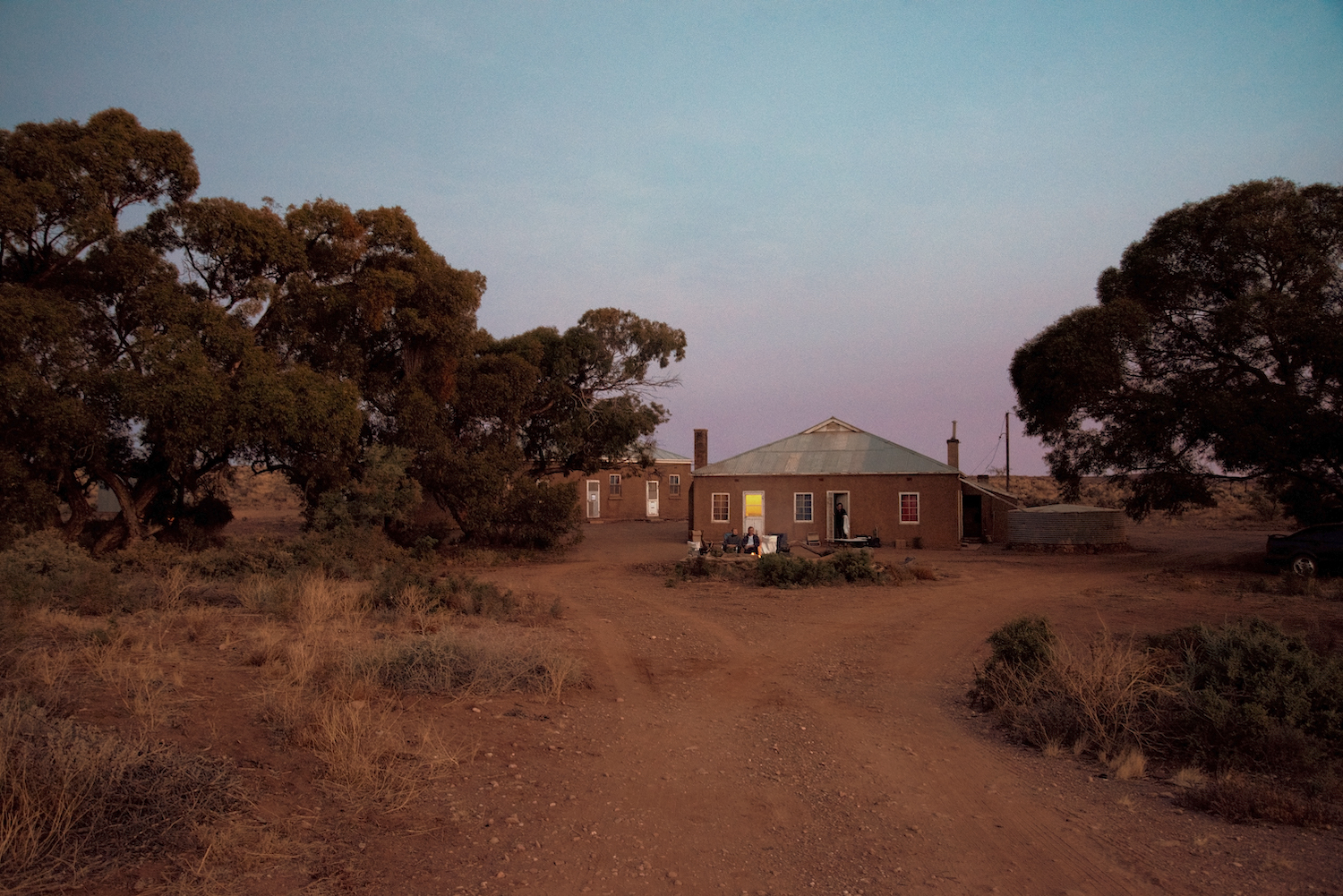
Early morning outside Shearer’s quarters, first morning, coffee by camp fire
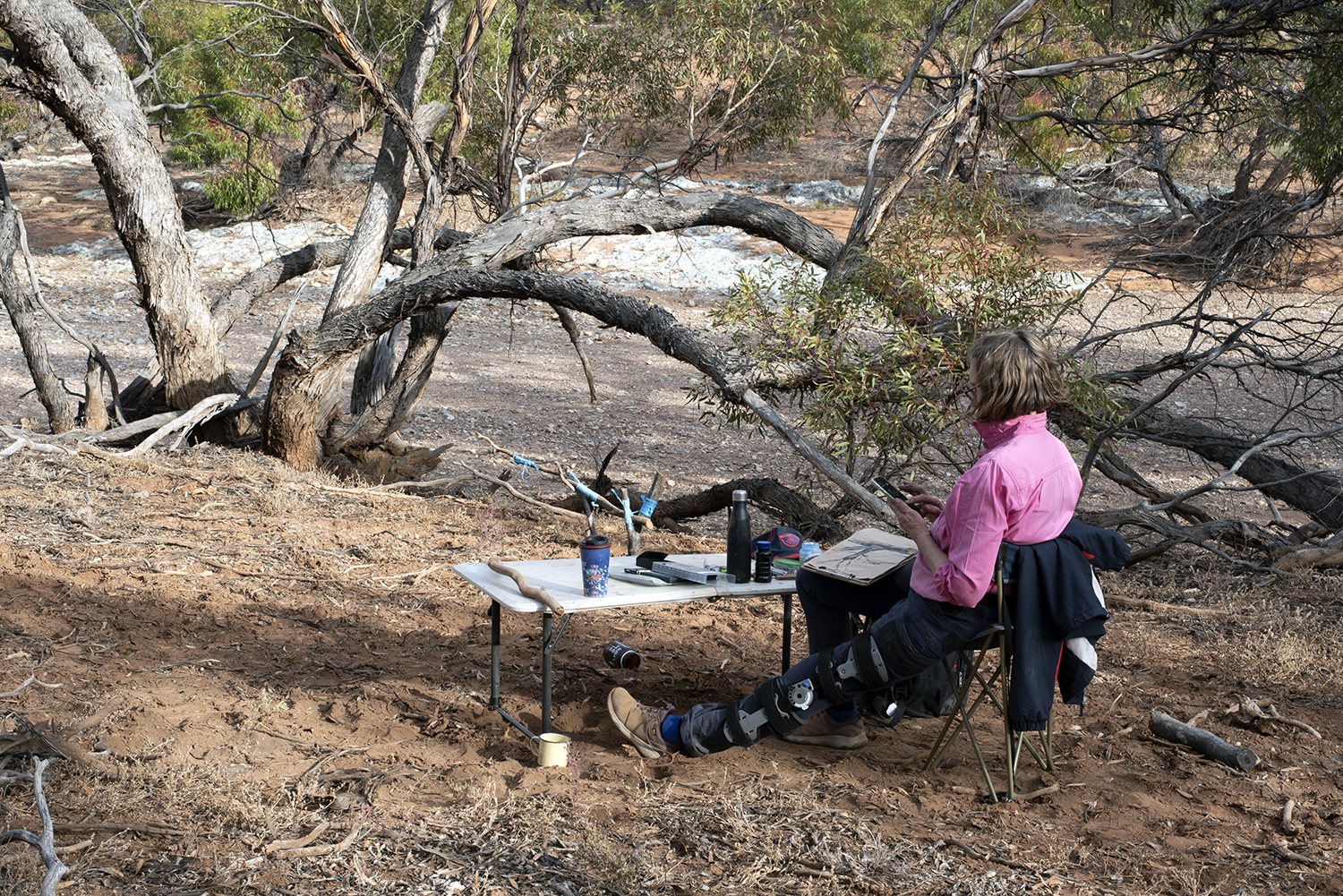
Denise
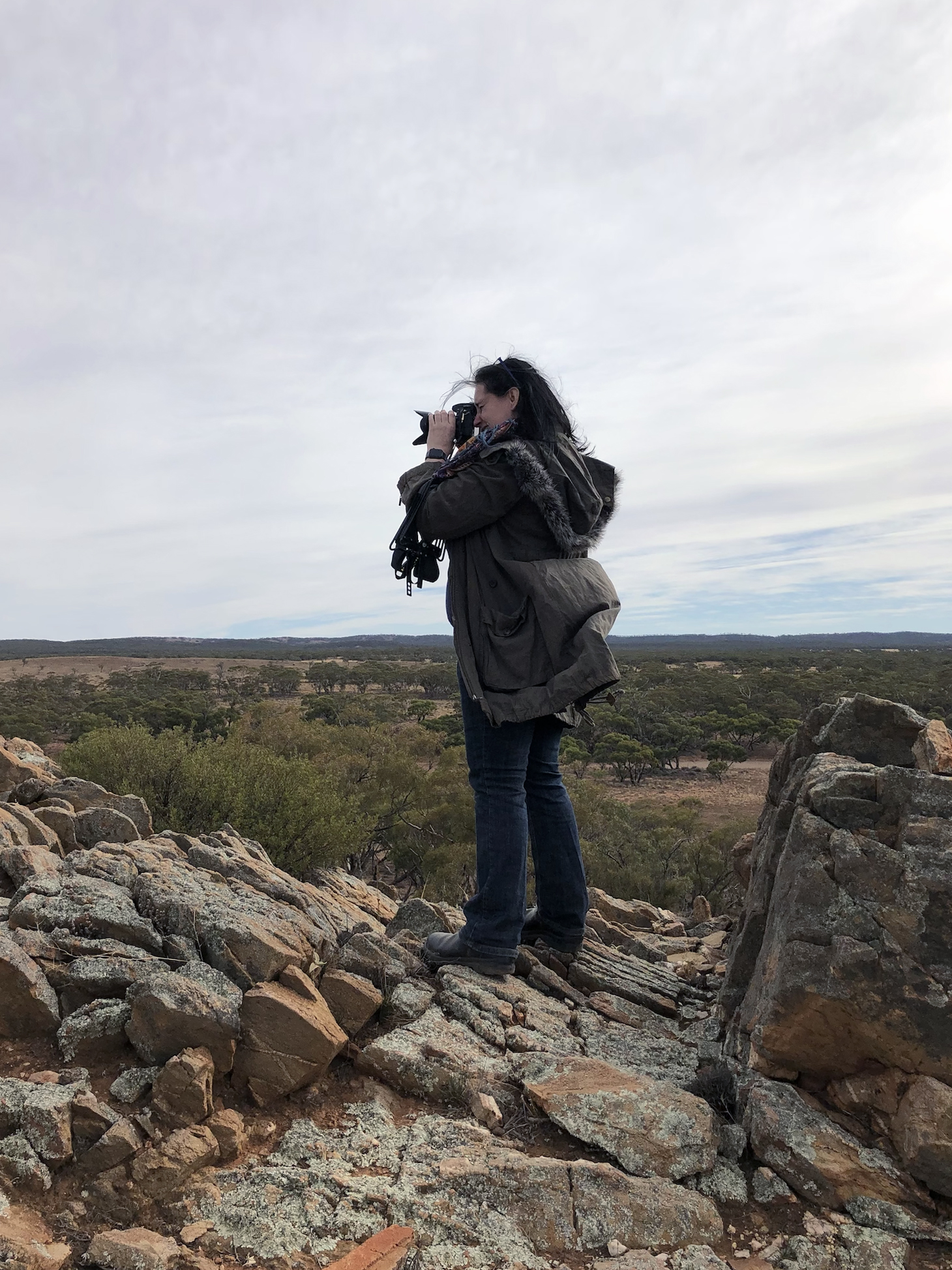
Kerry – photograph Anne Sanders
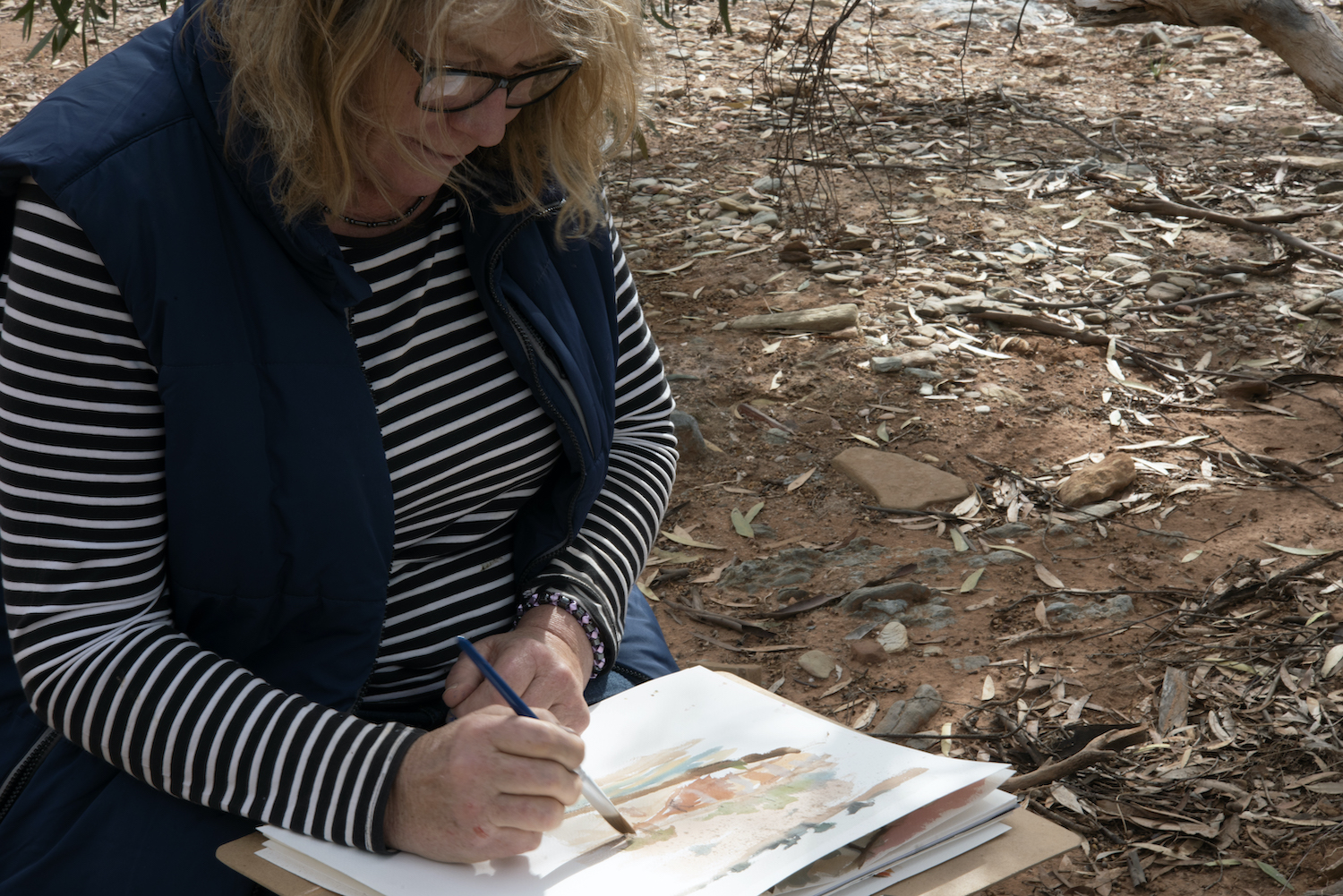
Julie drawing
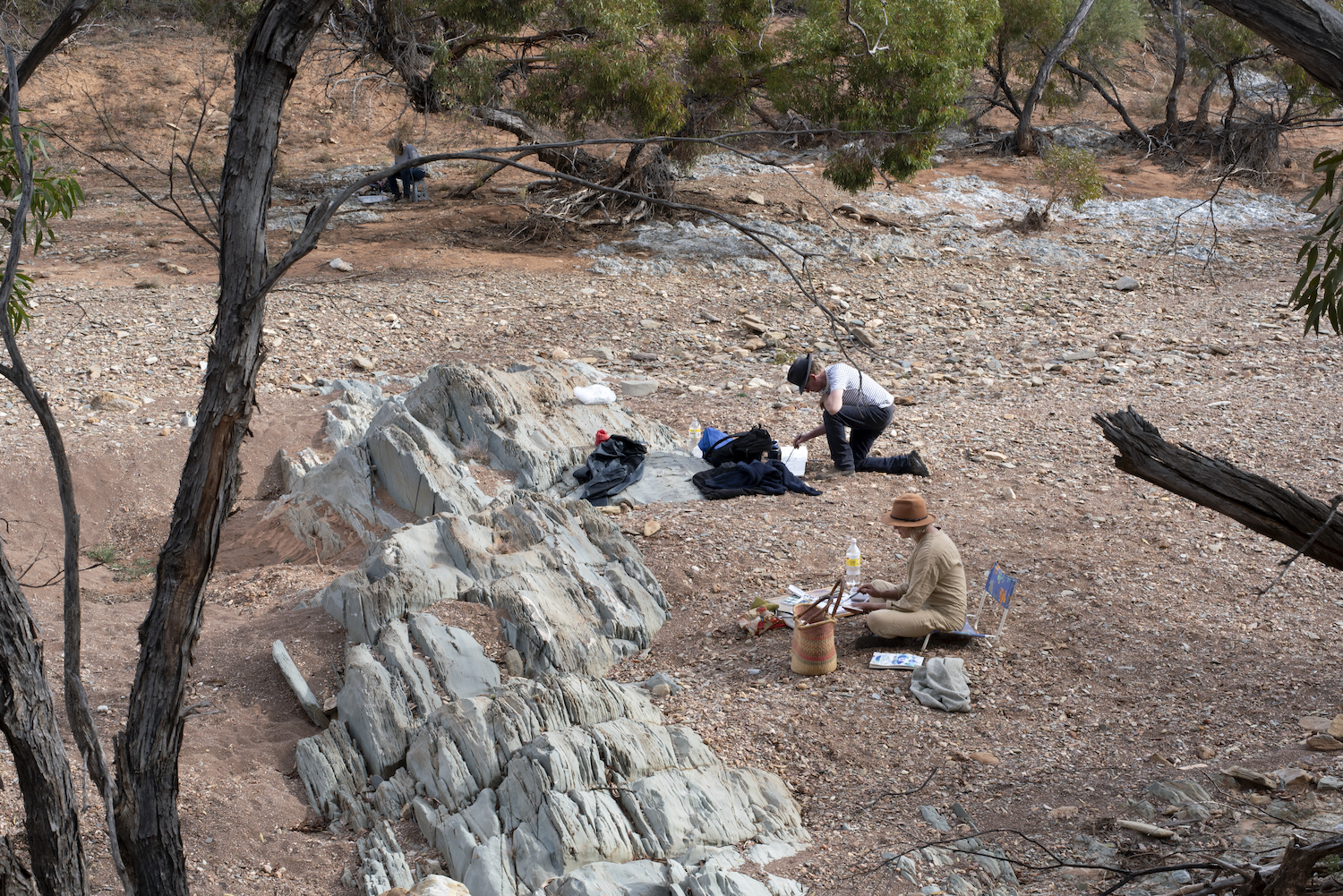
John and Cait on creek bed working
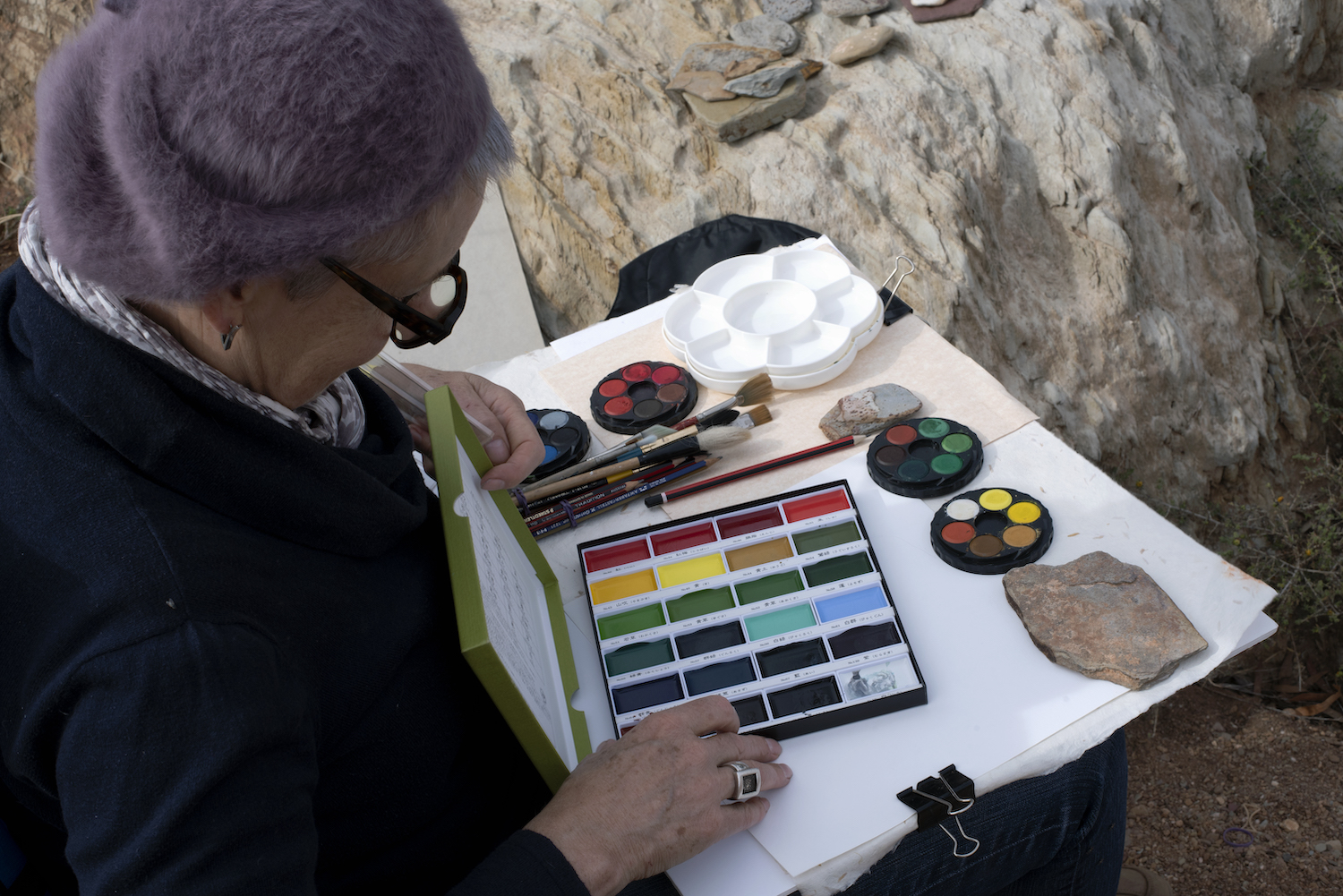
Alison choosing her materials
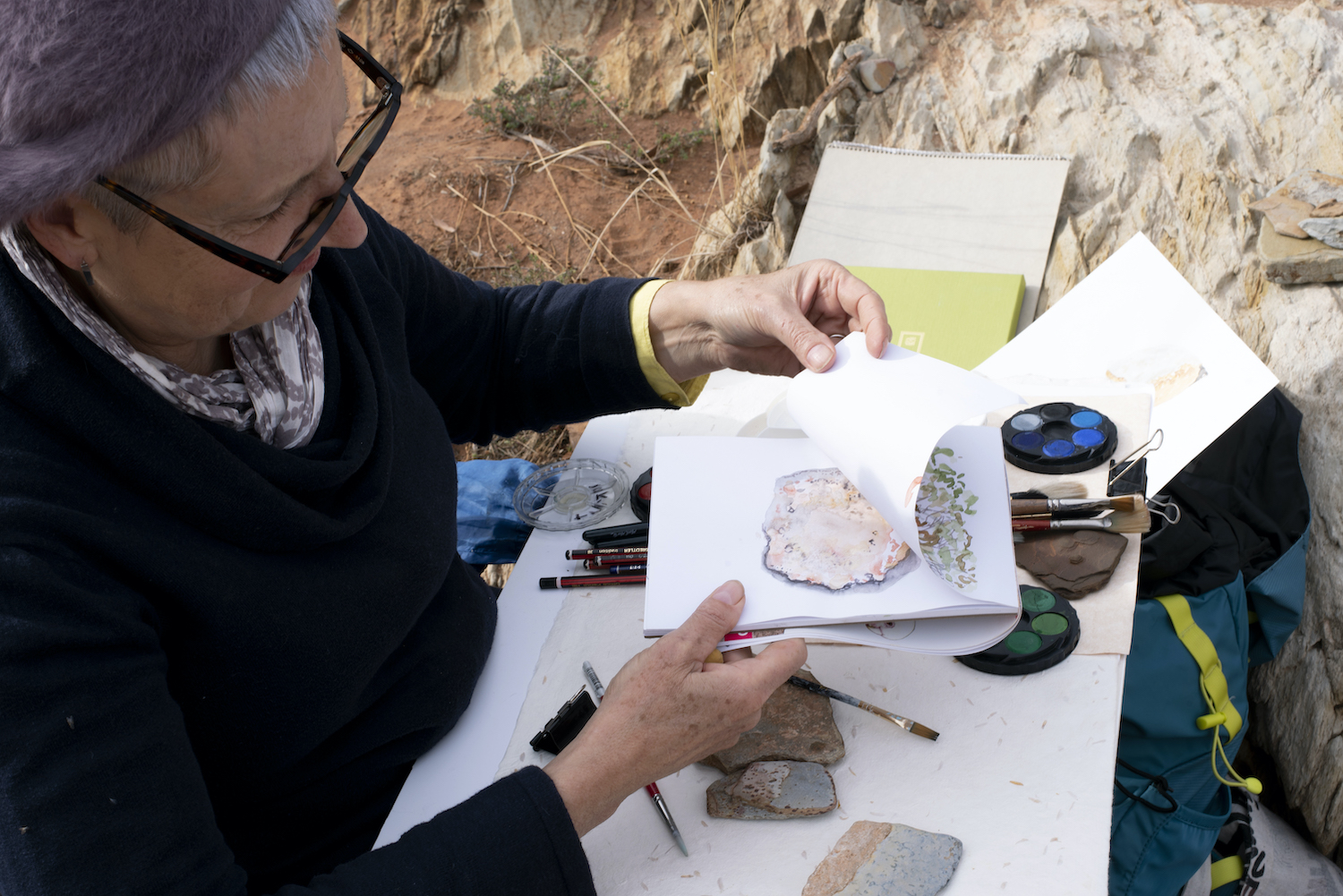
Alison drawing rocks
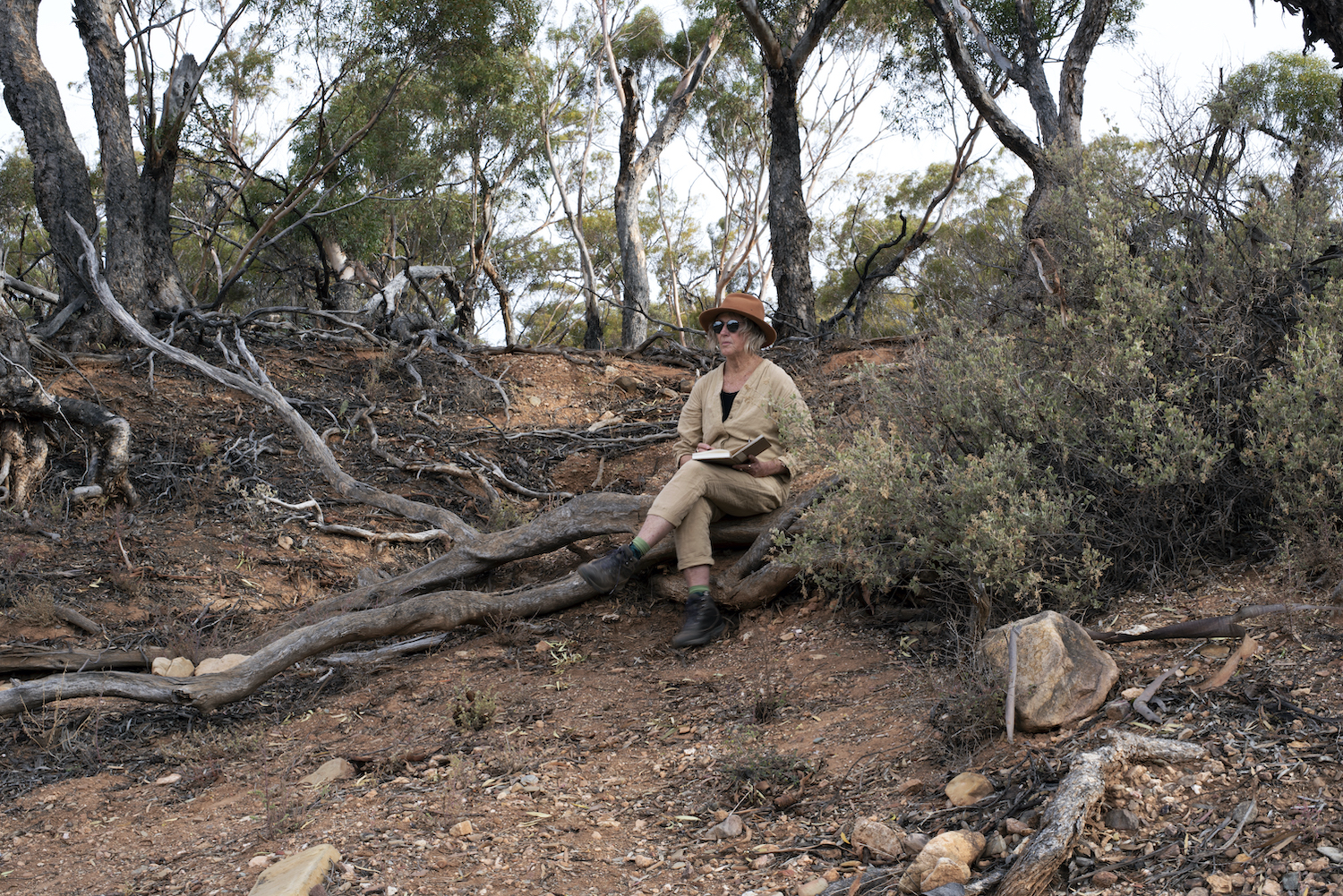
Cait drawing
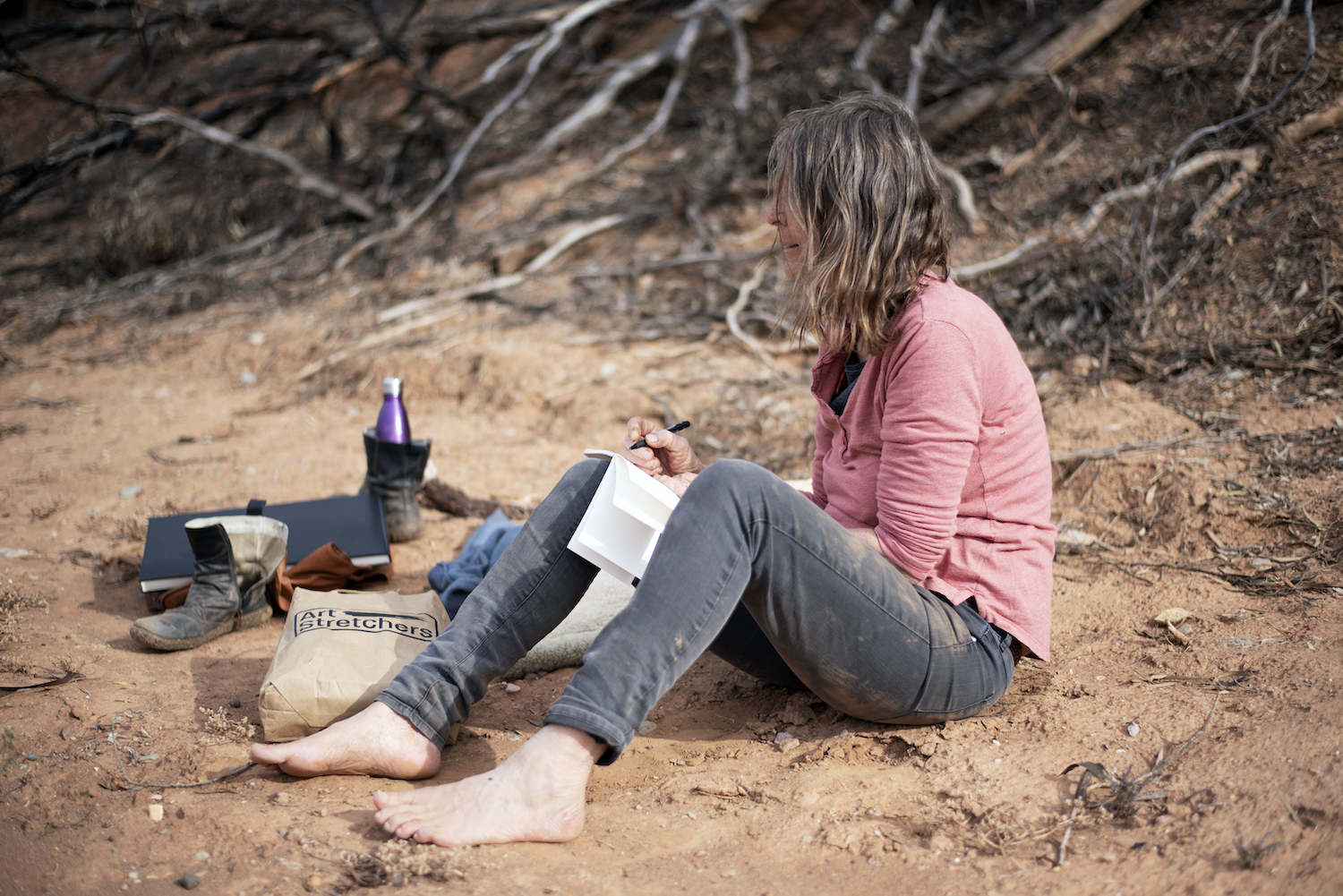
Penny working
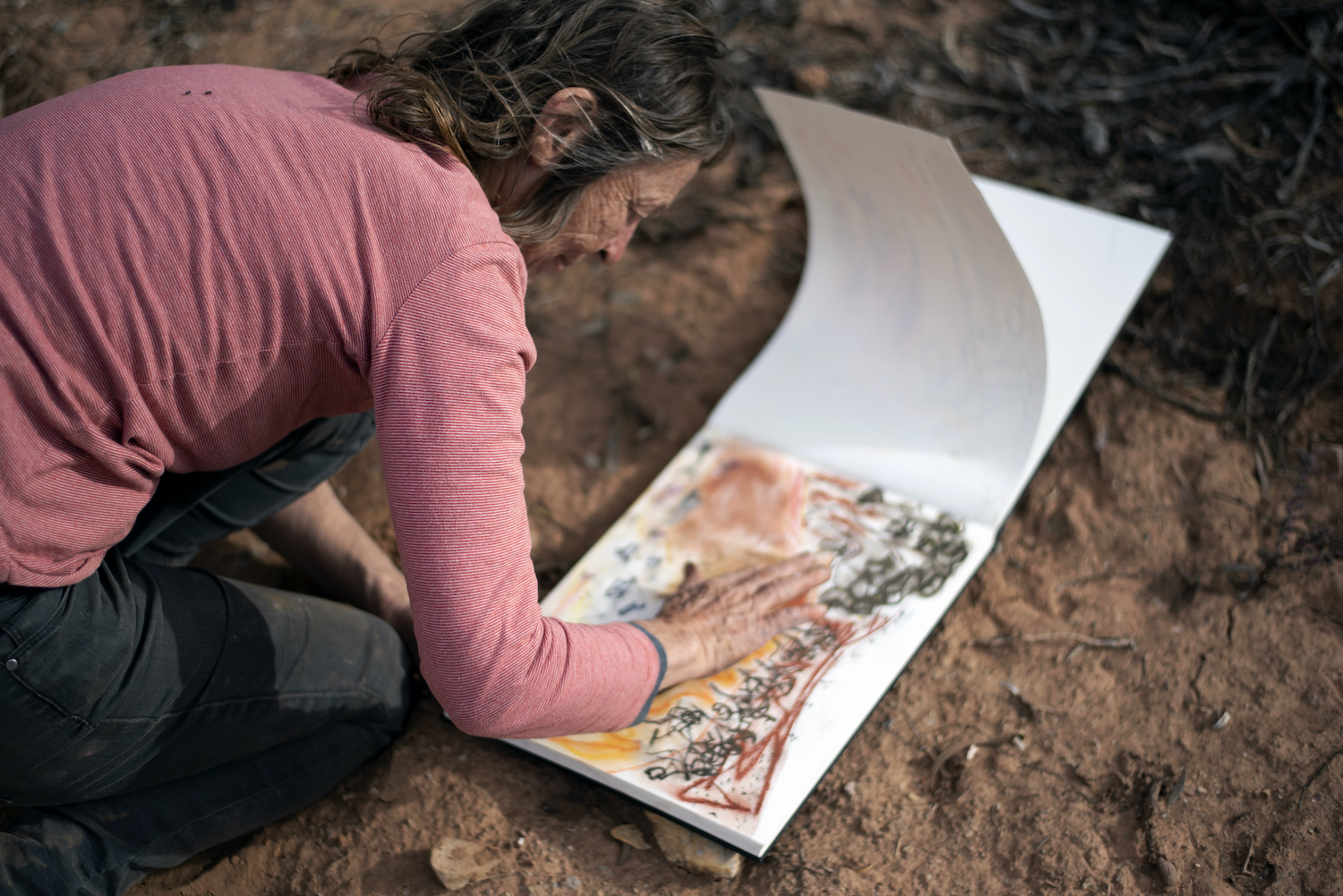
Penny drawing
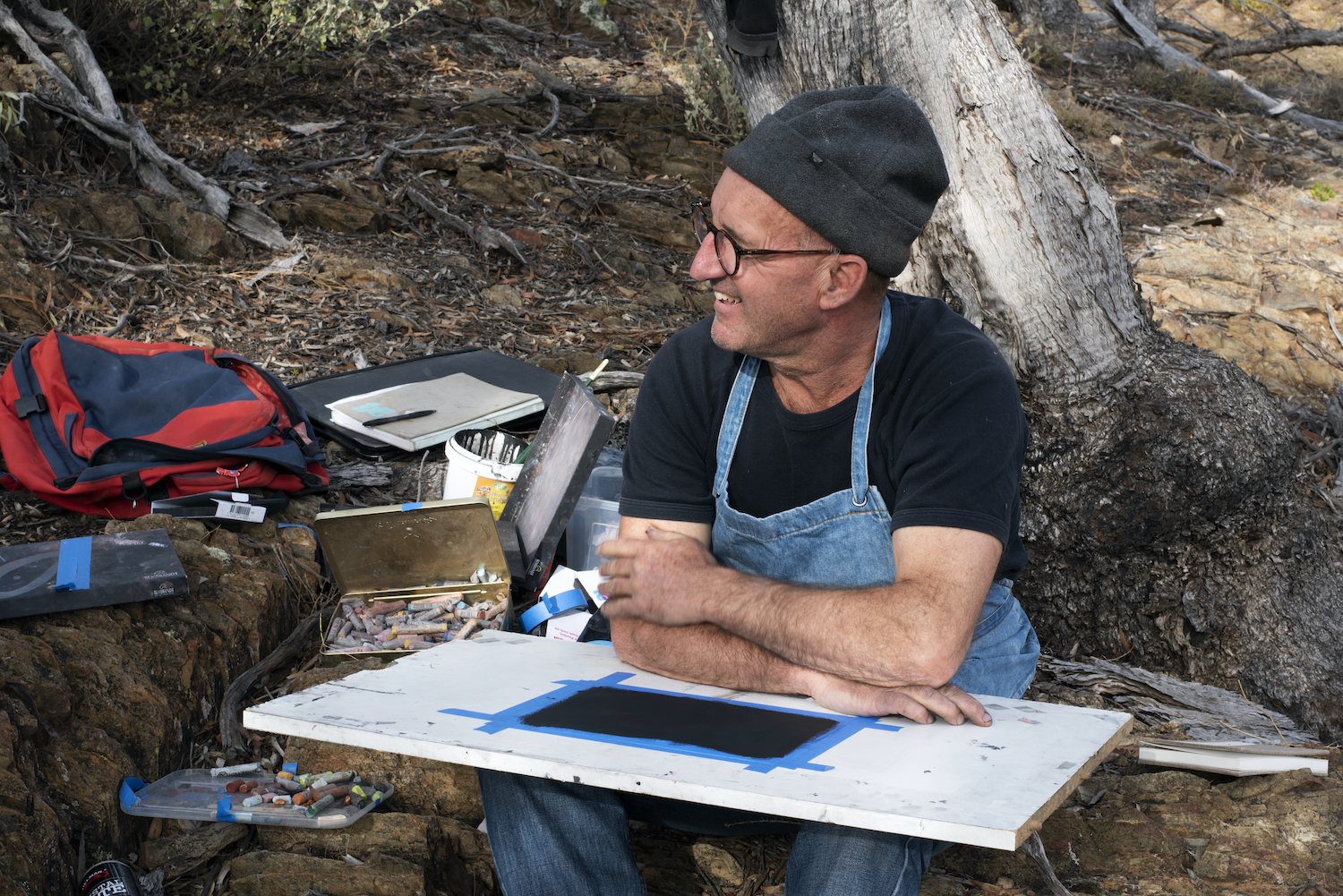
Jake
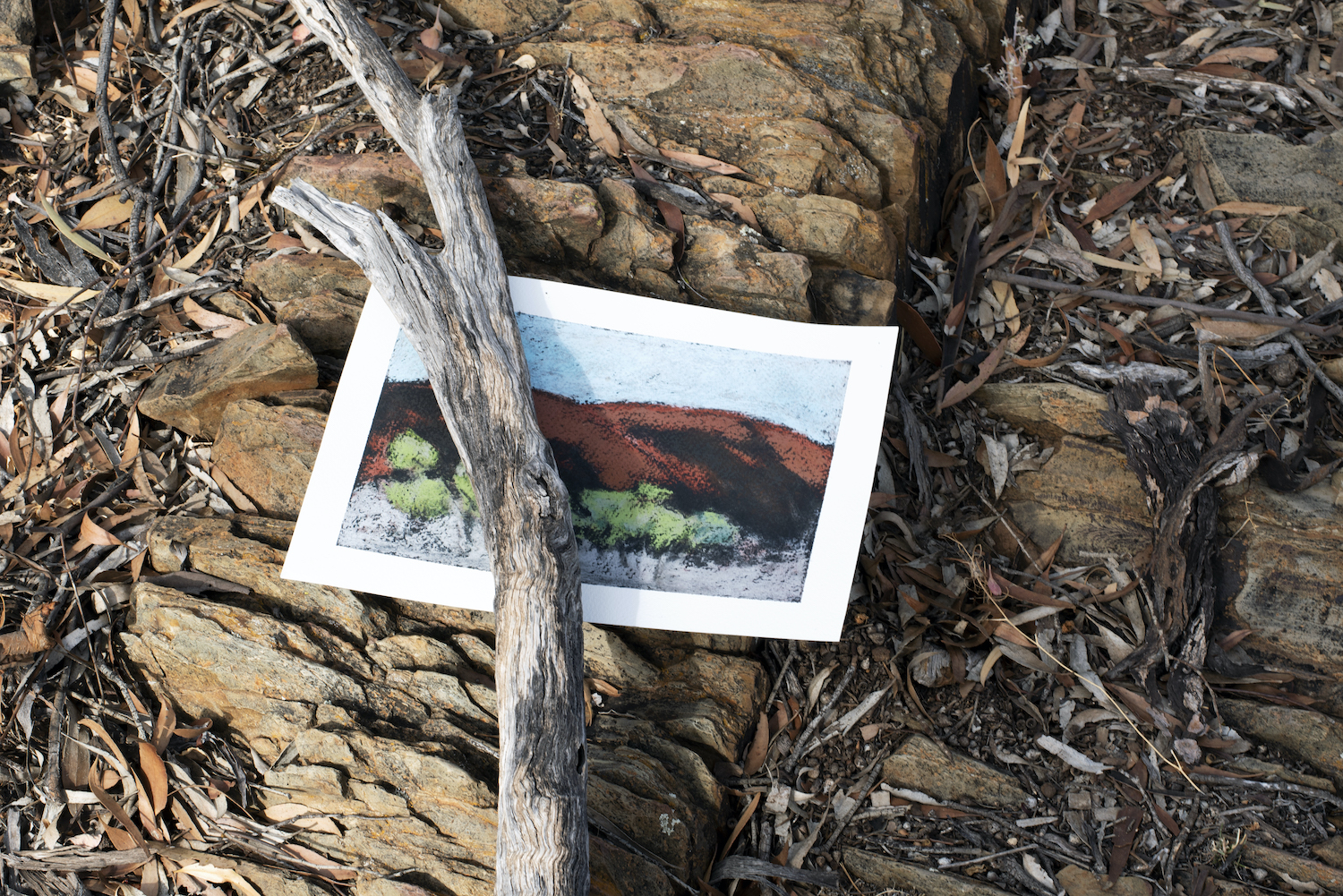
Jake’s drawing under branch
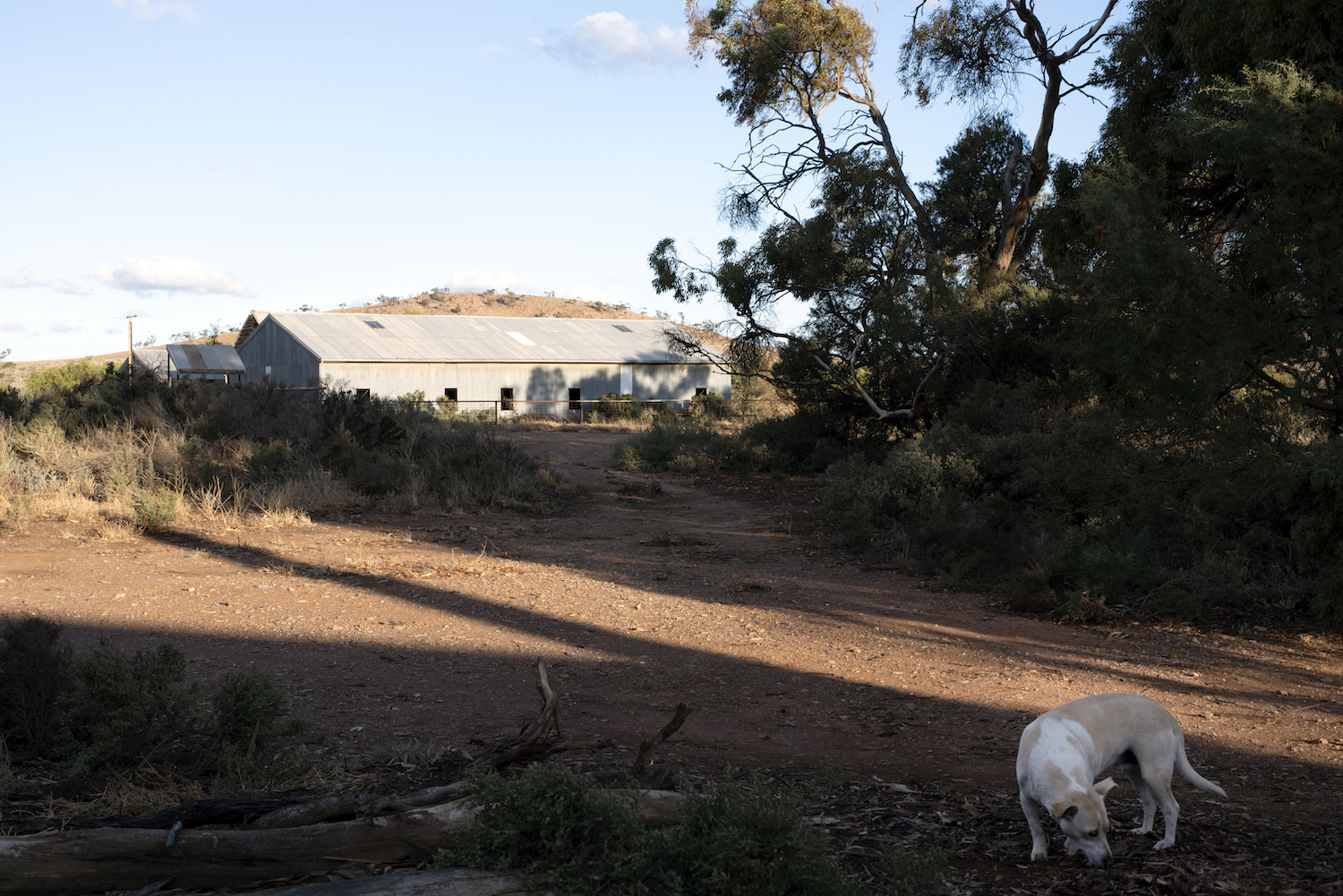
Rosie and Pitcairn woolshed in afternoon light
Day 2 TUESDAY 25 May – site: Woolshed
Collective noun of the day: a shed of artists
After a wild night of high winds and dust, we awoke to rain! Yes, real wet rain drumming lightly on the corrugated roof and that wonderful petrichor smell of rain on parched earth. Its been a long time since this country had rain. Clearly, returning to Dinny O’Brien’s Camp was not on today’s menu, so a quick reconnaissance of the evocative shearing shed, ensured that Day 2 would be an interior day. Ross’s father’s mantra proved correct: ‘Rain before 7 fine by 11’.
As the rain eased, the group salvaged pieces of rusted junk such as old car parts and fencing wire for possible installations, from the homestead tip. After lunch, a group led by John walked up to the eastern boundary and climbed the nearby ridge to view the distant ranges. The rain had cleared leaving everything clean, the ranges in sharp relief. Grey and white clouds shuddered overhead and the wind had a definite chill.
The Pitcairn Woolshed provided a fantastic opportunity for close studies of light, shade, architectural forms, and detailed studies of artefacts such as hand-forged gadgets, hinges and bolts. The small room at the back of the shed – the sharpening room for the shears – in earlier times housed the diesel engine that powered the overhead gear on the board where the sheep were shorn. It was filled with old oil and kero tins, a pair of discarded shearer’s moccasins, goggles and dusty old catering tins of French Onion Soup.
Jake’s site was his shearer’s quarters which looks out over the Pitcairn plain from where he could see the incoming weather; dark grey clouds and the effects of light on the ranges.
At 4pm everyone gathered to meet Ross and tour the homestead complex and gardens, Ross providing family history background with great family portraits going back several generations.
Dinner was followed by Day 2 show and tell. Taylah was the surprise – she had quietly returned to the shearing shed while everyone was touring the Sawers house, and had produced some excellent drawings of the woolshed interior in her chinese book. Cait was ill with a migraine so stayed quietly in her room for the day. Hopefully she will have improved by tomorrow.
Again some wonderful work was produced: Jake’s brooding sky and range landscapes (Suerat’s velvety drawings come to mind); Alison’s detailed drawings of the architectural lines created by the woolshed’s gates and trusses; Denise’s drawing on her found brown paper of the old diesel-driven operational shearing gear; Kerry’s sketches of the shearers’ graffiti wall and Penny’s first attempts at painting in a Chinese book. Julie set up her easel and painted the overhead gear with light streaming in from the let out pens, in oils on canvas board.
A great dinner followed, with Ross and his son David joining us for jokes, bon vin rouge and a near full moon rose clear and bright.
Quotes:
Kerry: “I feel we have a good amount of time here, time to go hard and try a few things [knowing] that this timeframe won’t last forever, so I can push myself a bit more…We are at a certain level where we don’t want to let ourselves down. We’ve got this opportunity and want to make the most of it.”
Alison: “I have been really immersed in study and work and haven’t had the head space for art so to quarantine this time and get back in to the zone is just brilliant… I think you actually need to get out of one environment and get into another and just be with other people who are looking, thinking about art, making art…and looking at things in a different way.”
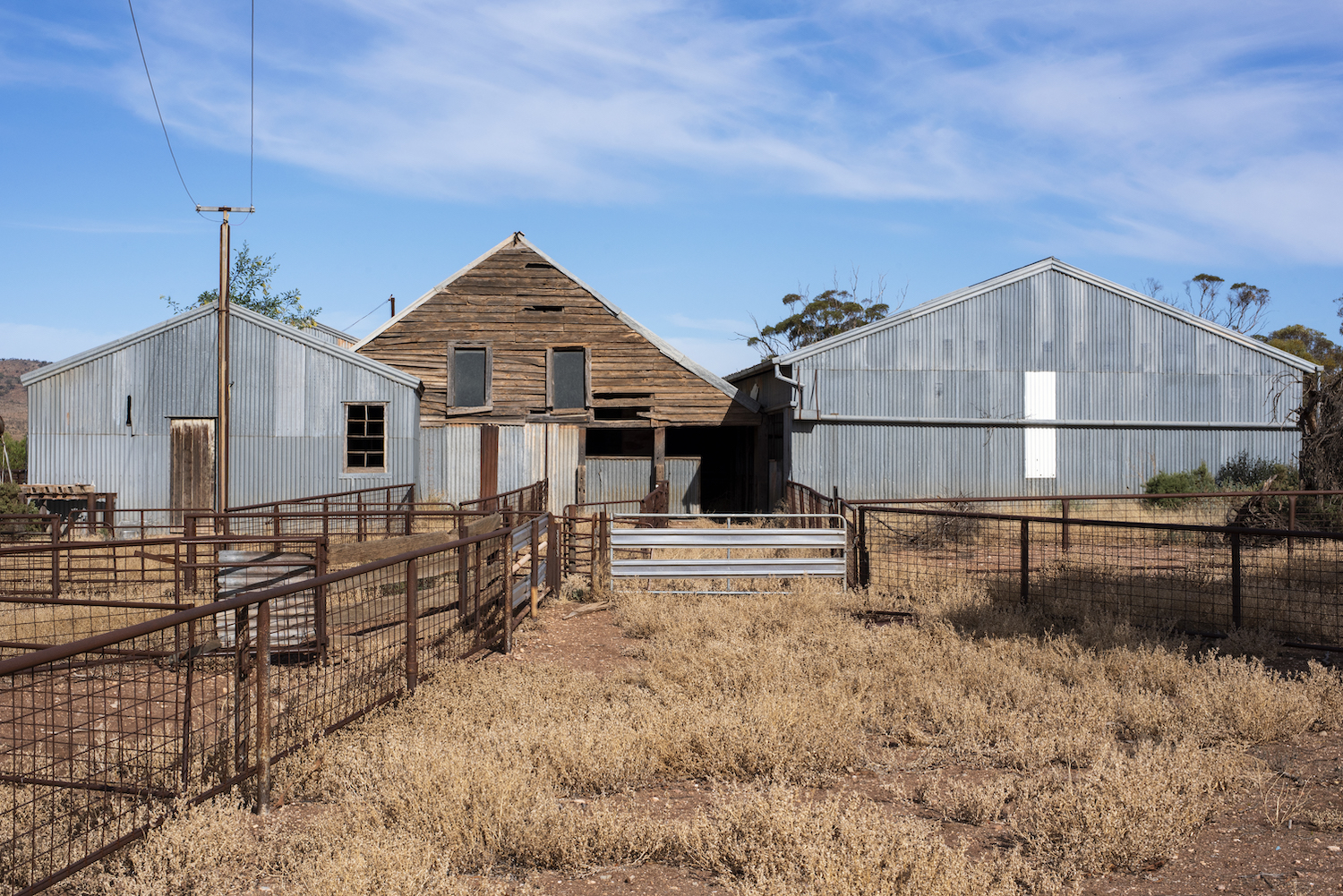
Pitcairn Woolshed
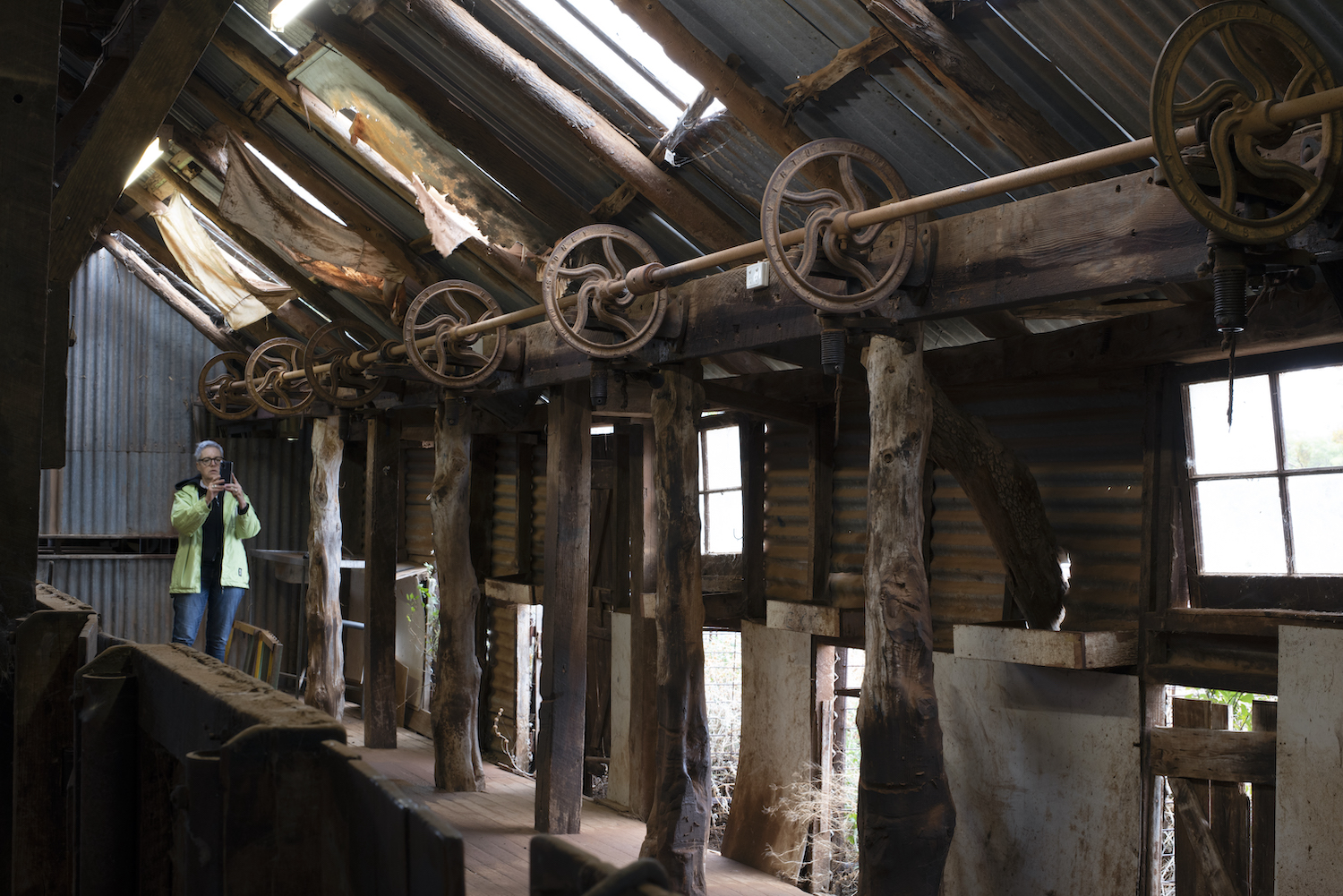
Alison photographing overhead gear in woolshed
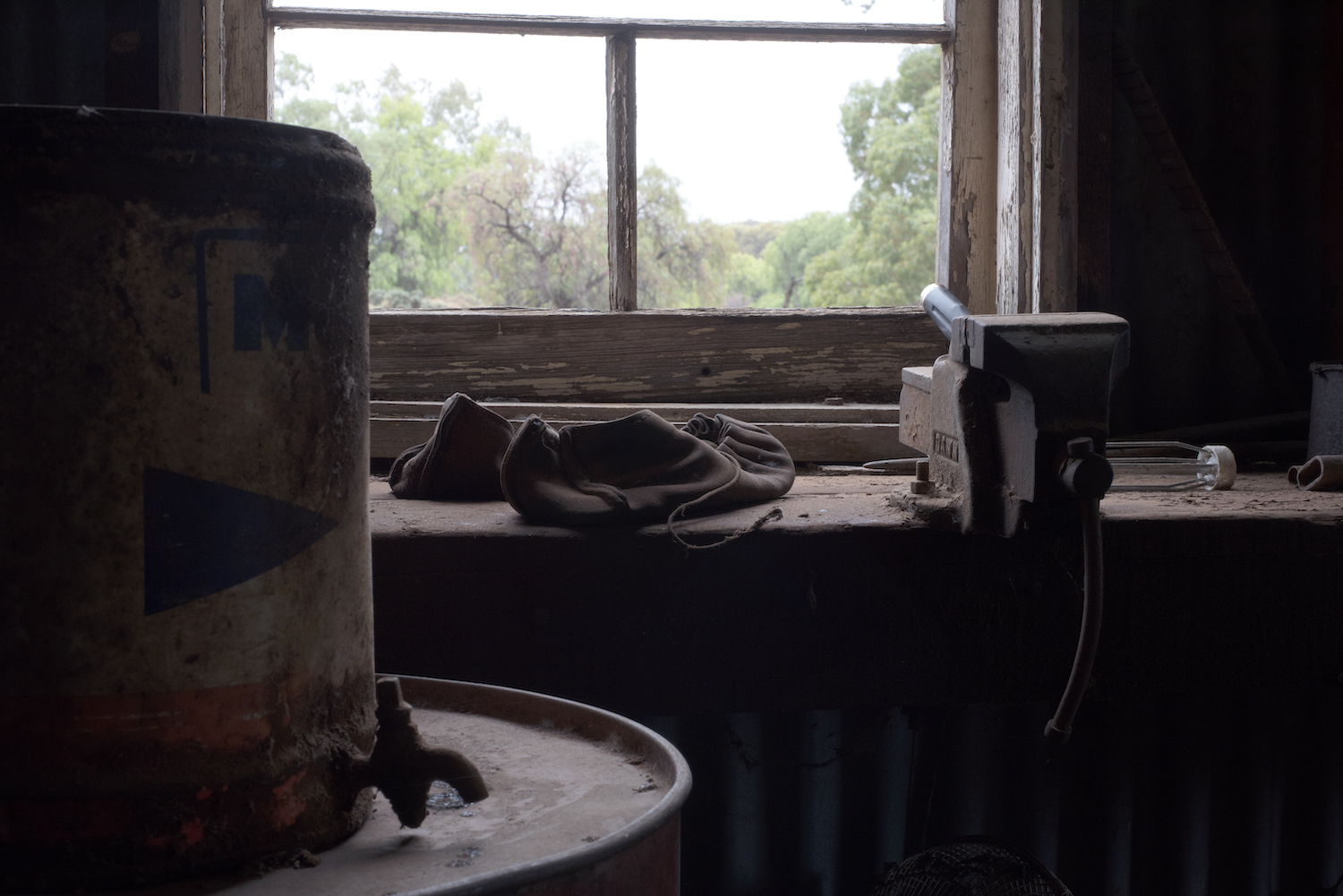
Moccasins (Shearer’s boots) inside sharpening and engine room
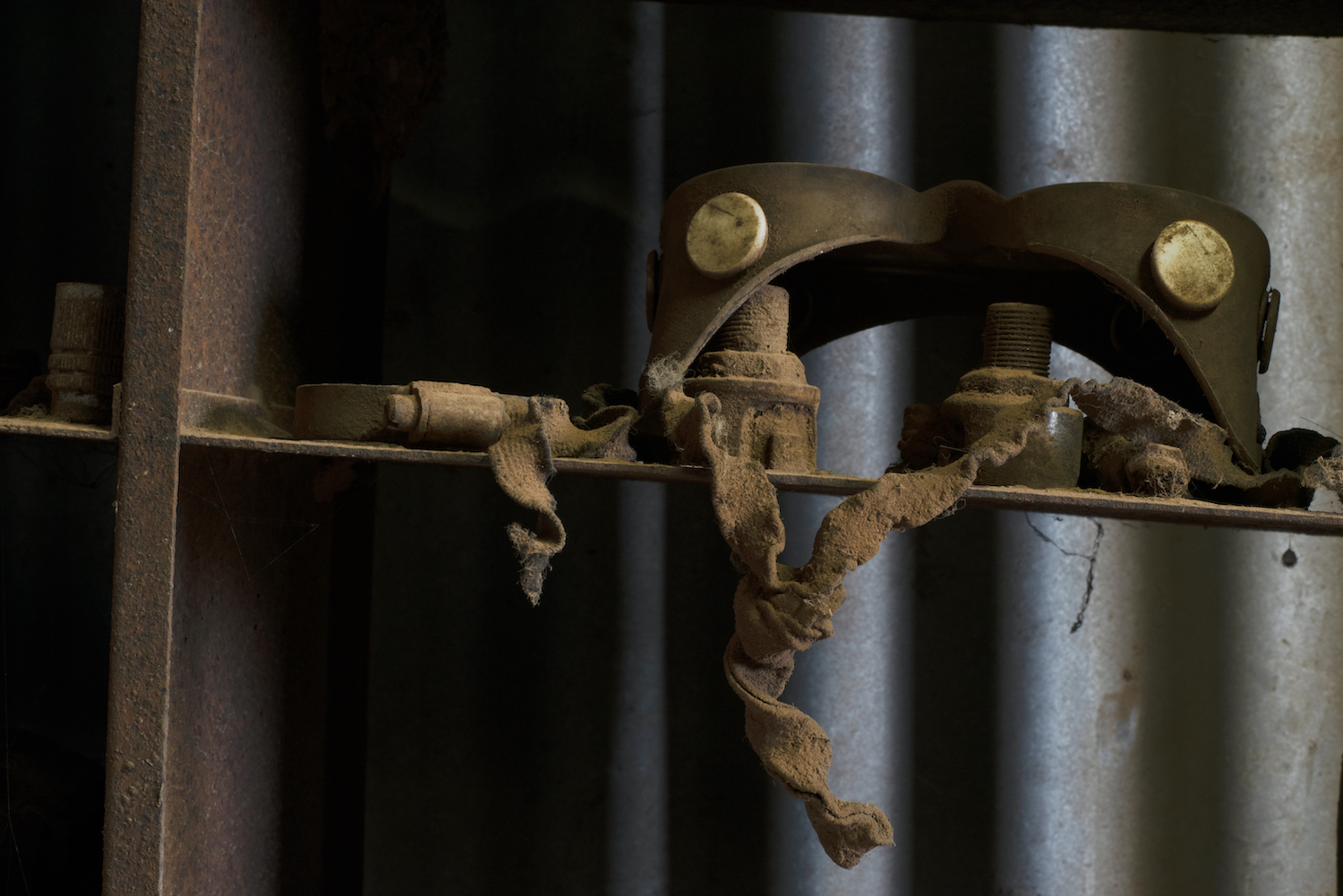
close up of googles
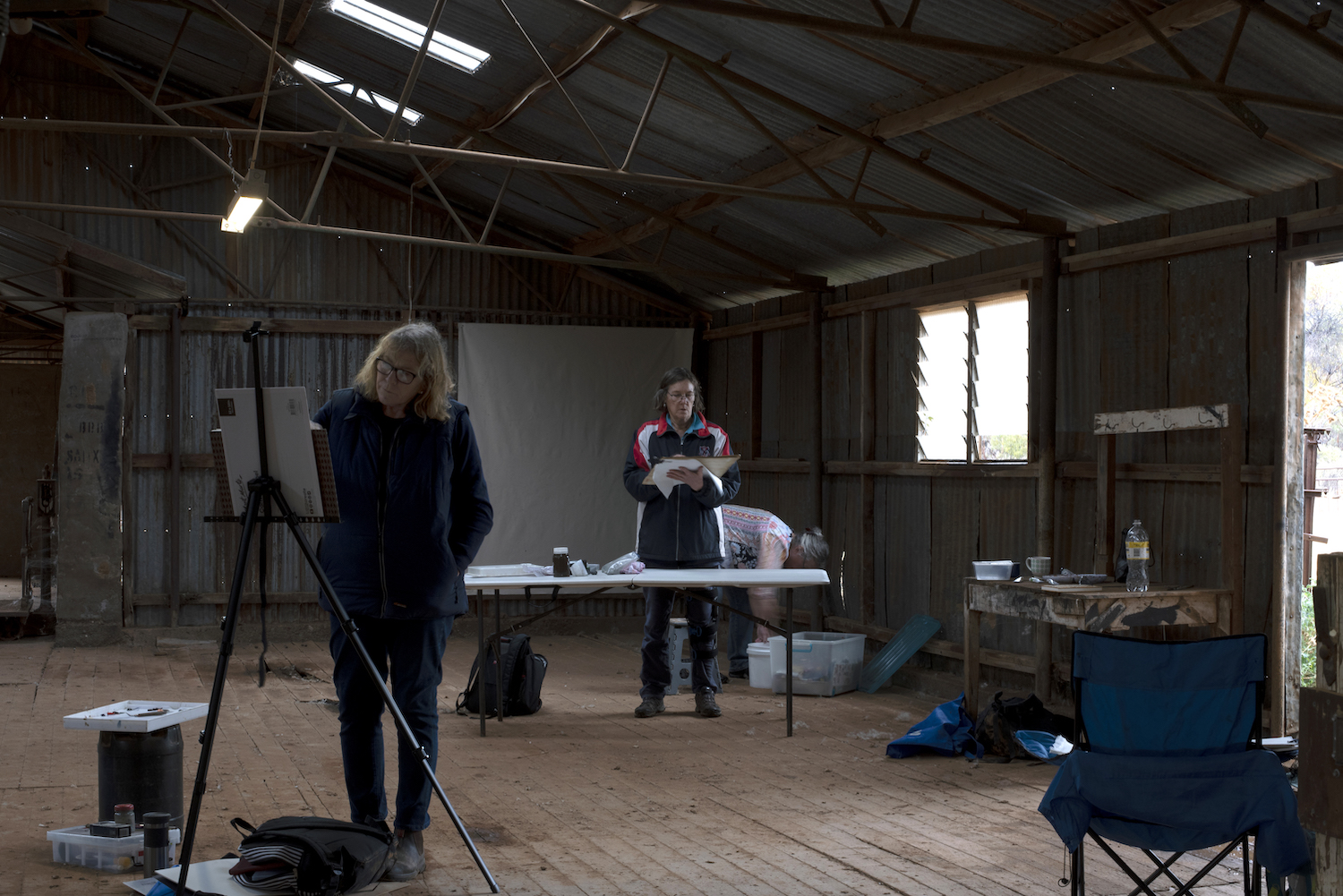
Julie and Denise working
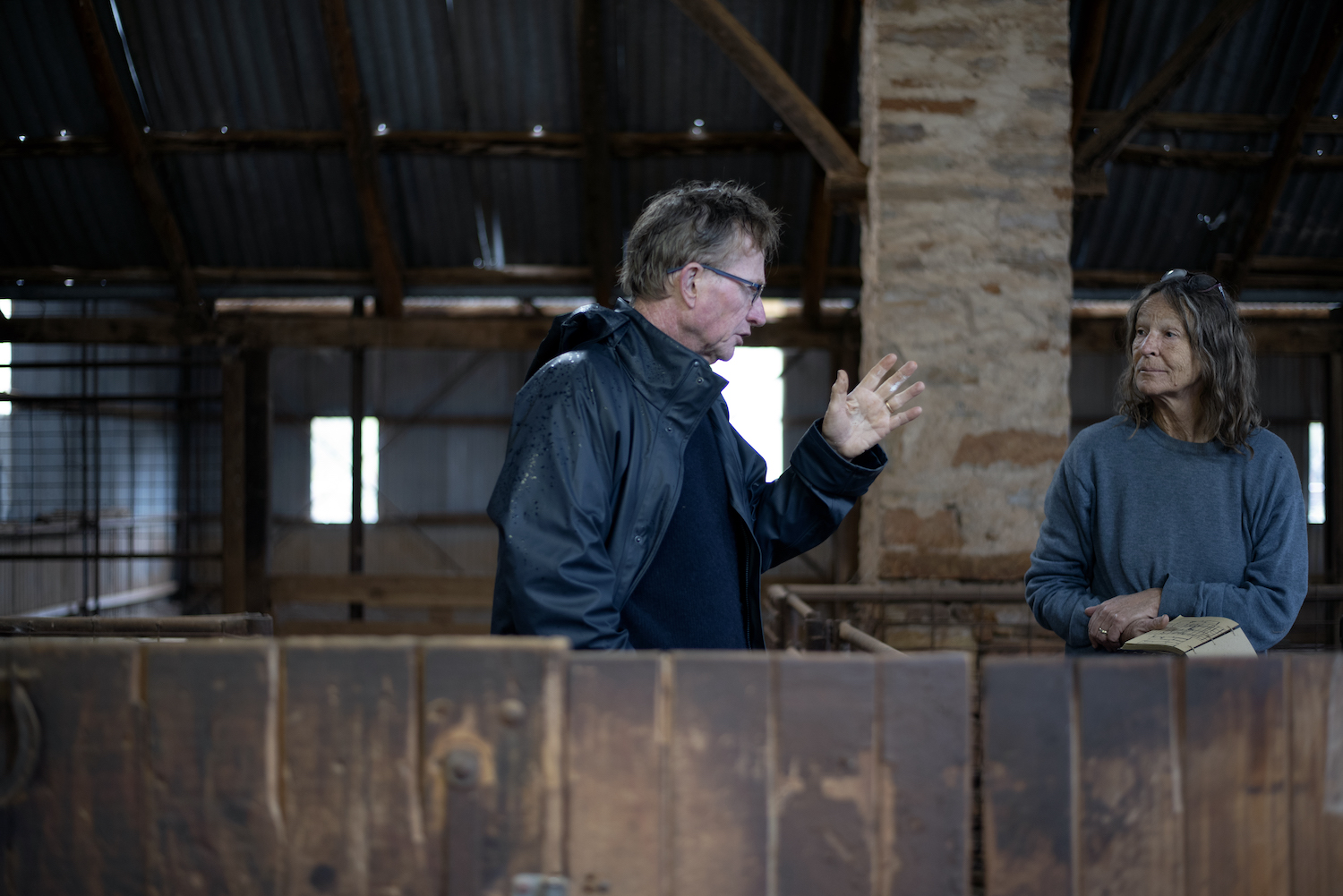
John and Penny talking in catching pens
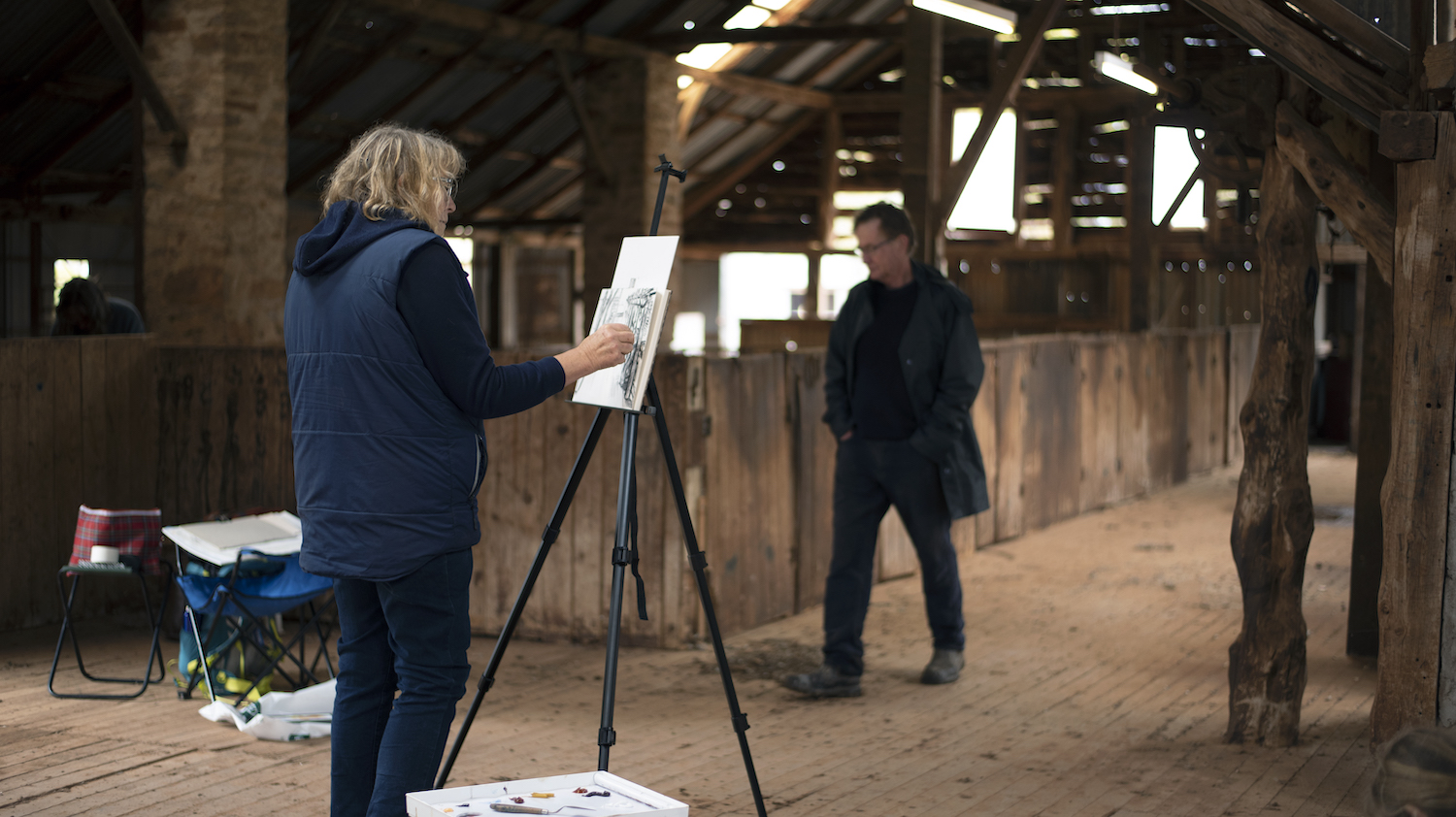
Julie drawing
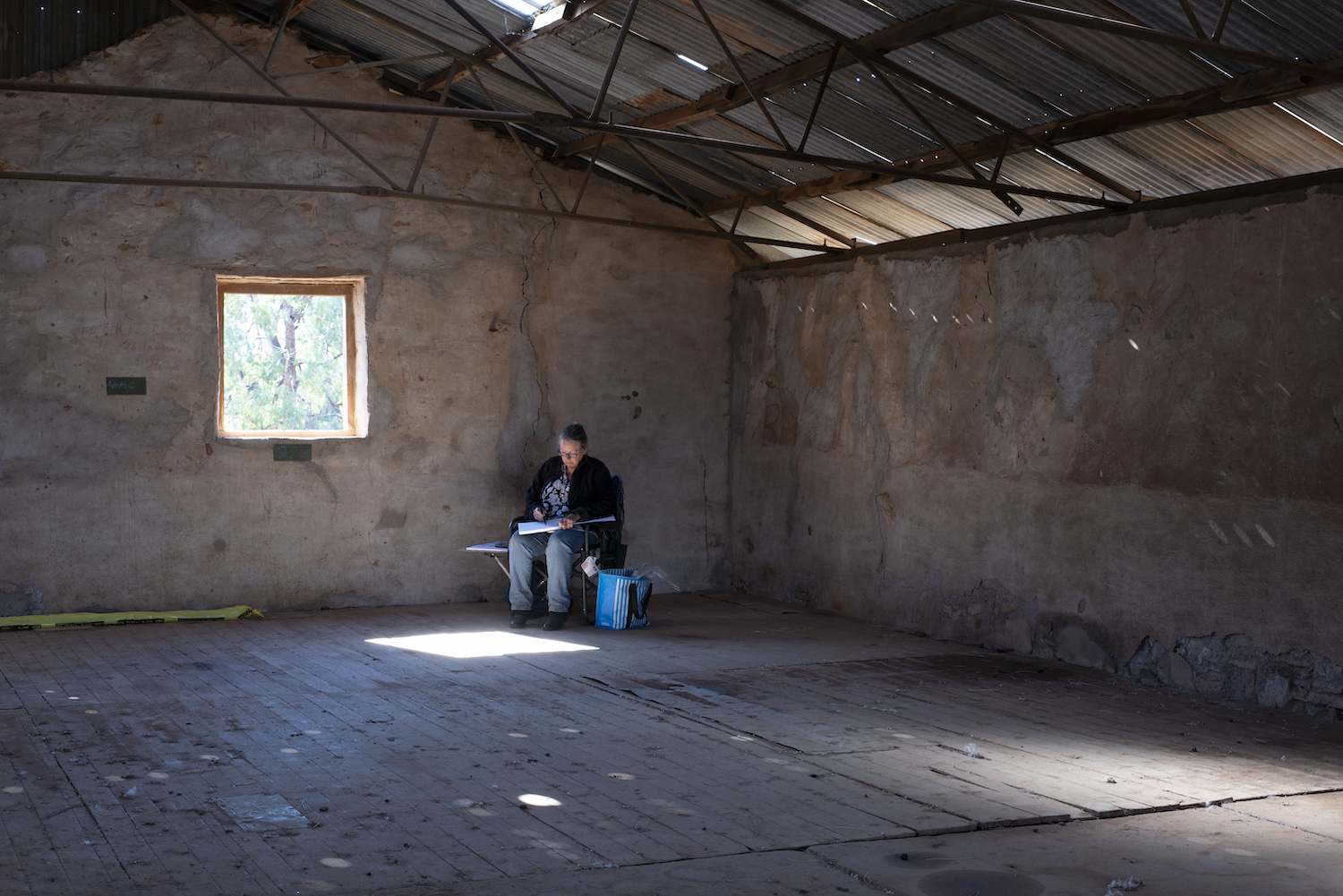
Lisa drawing
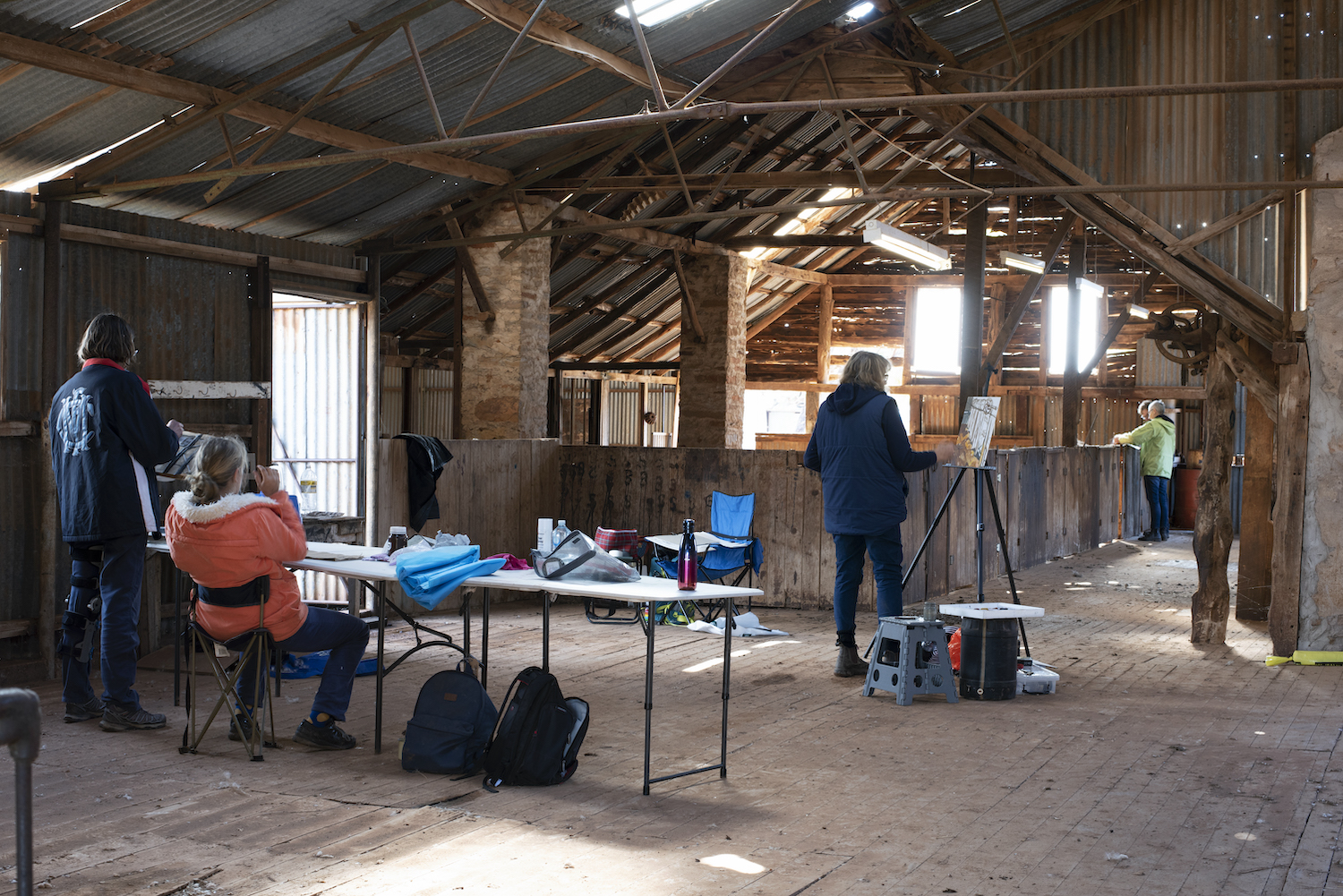
group working
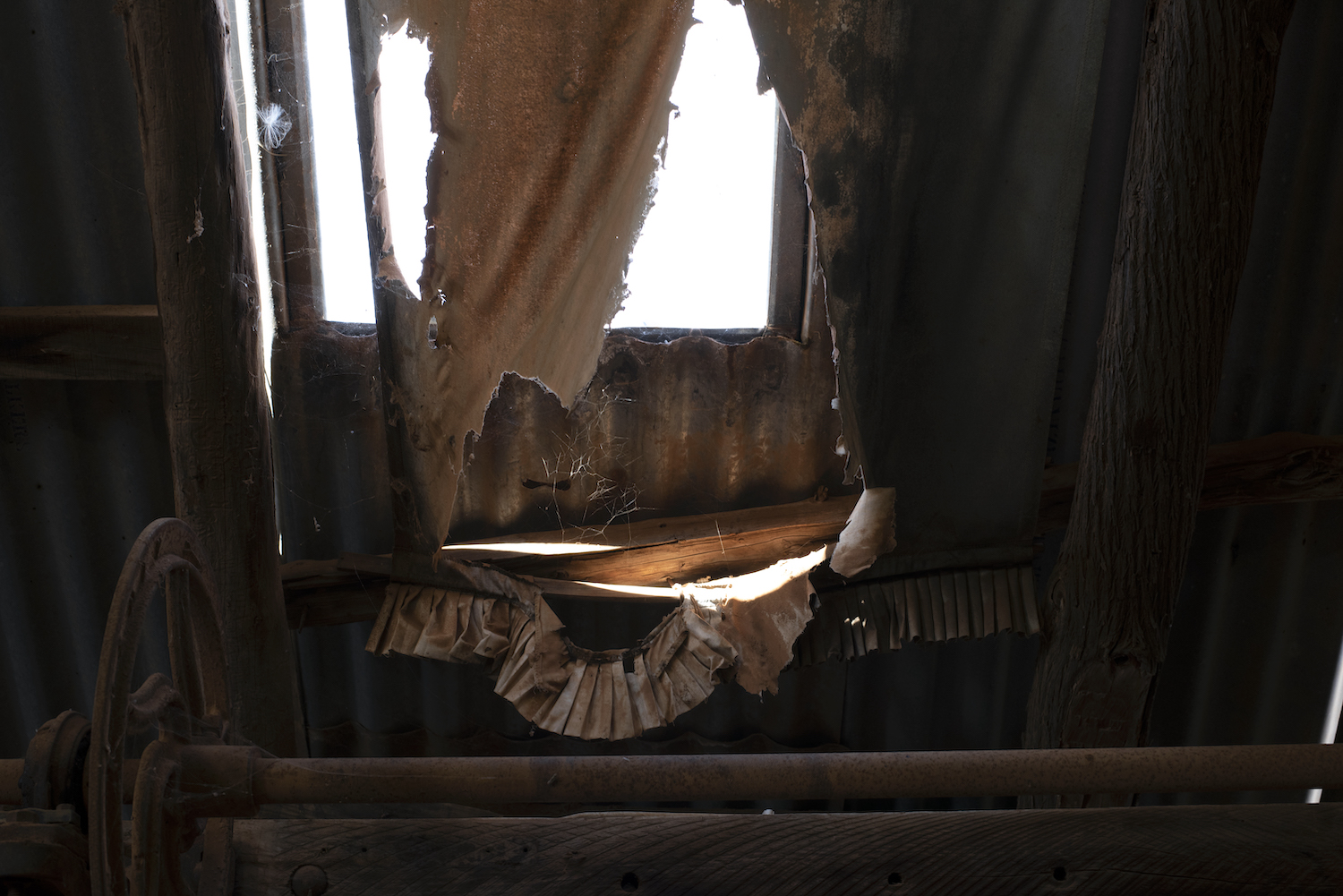
torn blind
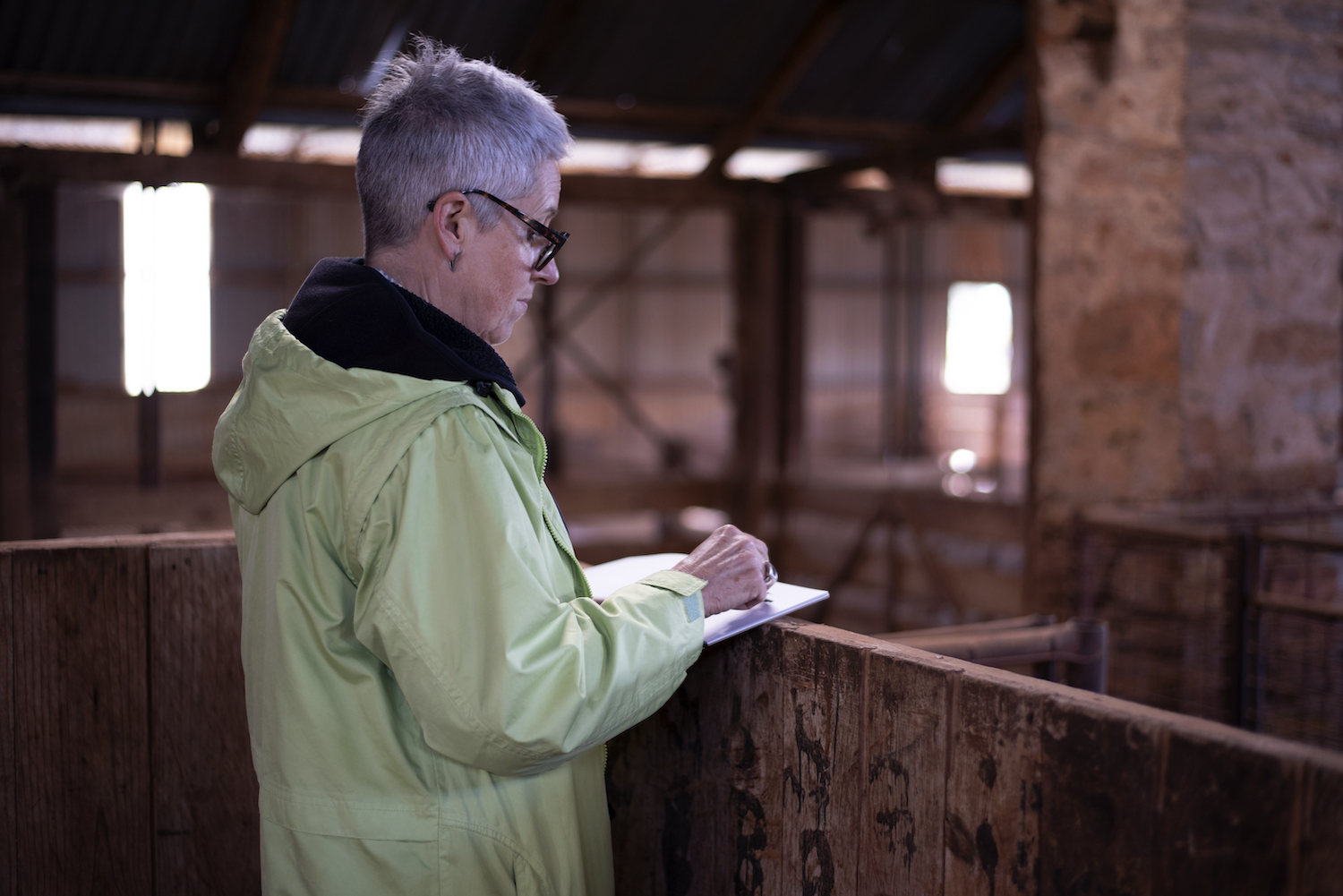
Alison drawing – close up
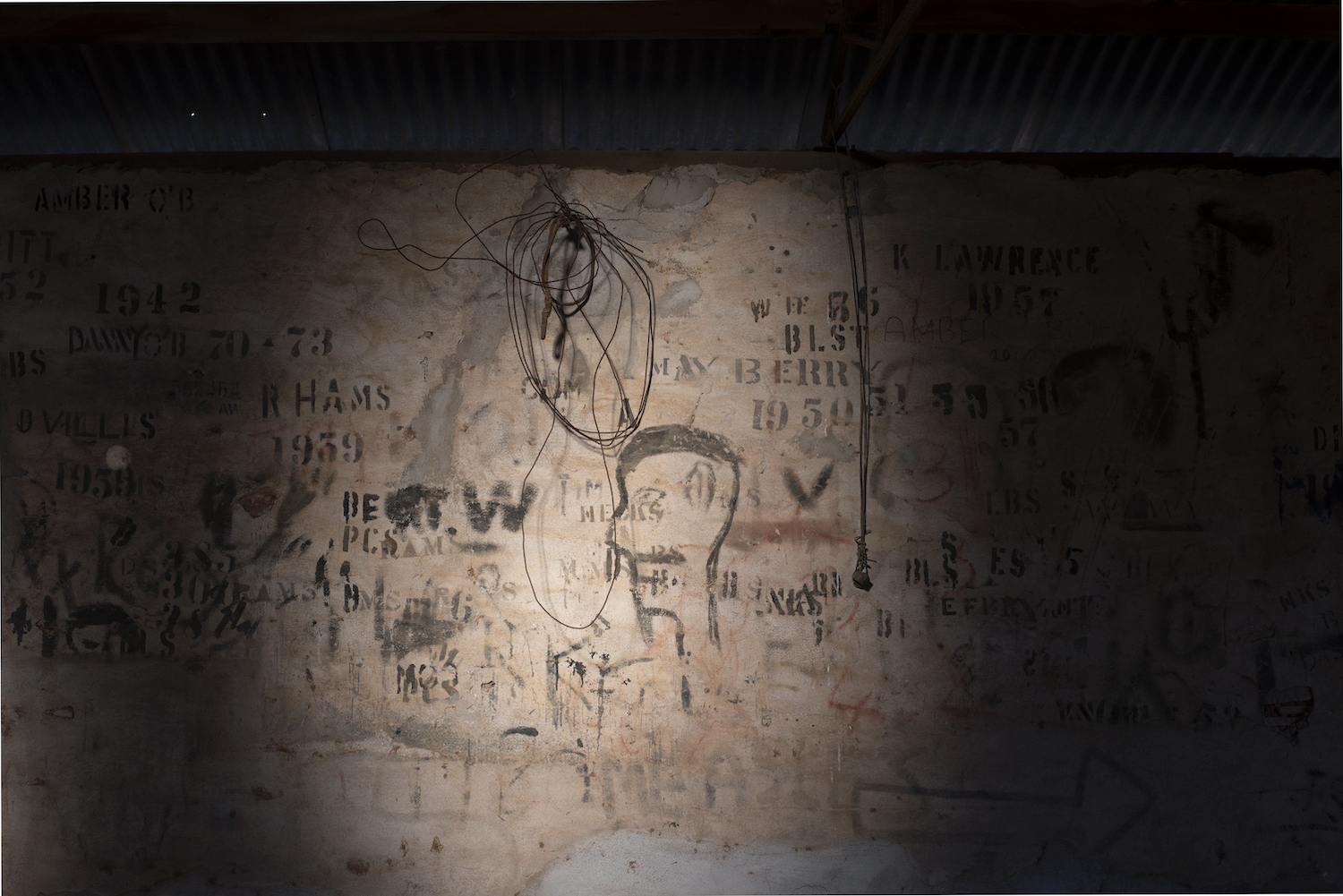
graffiti wall
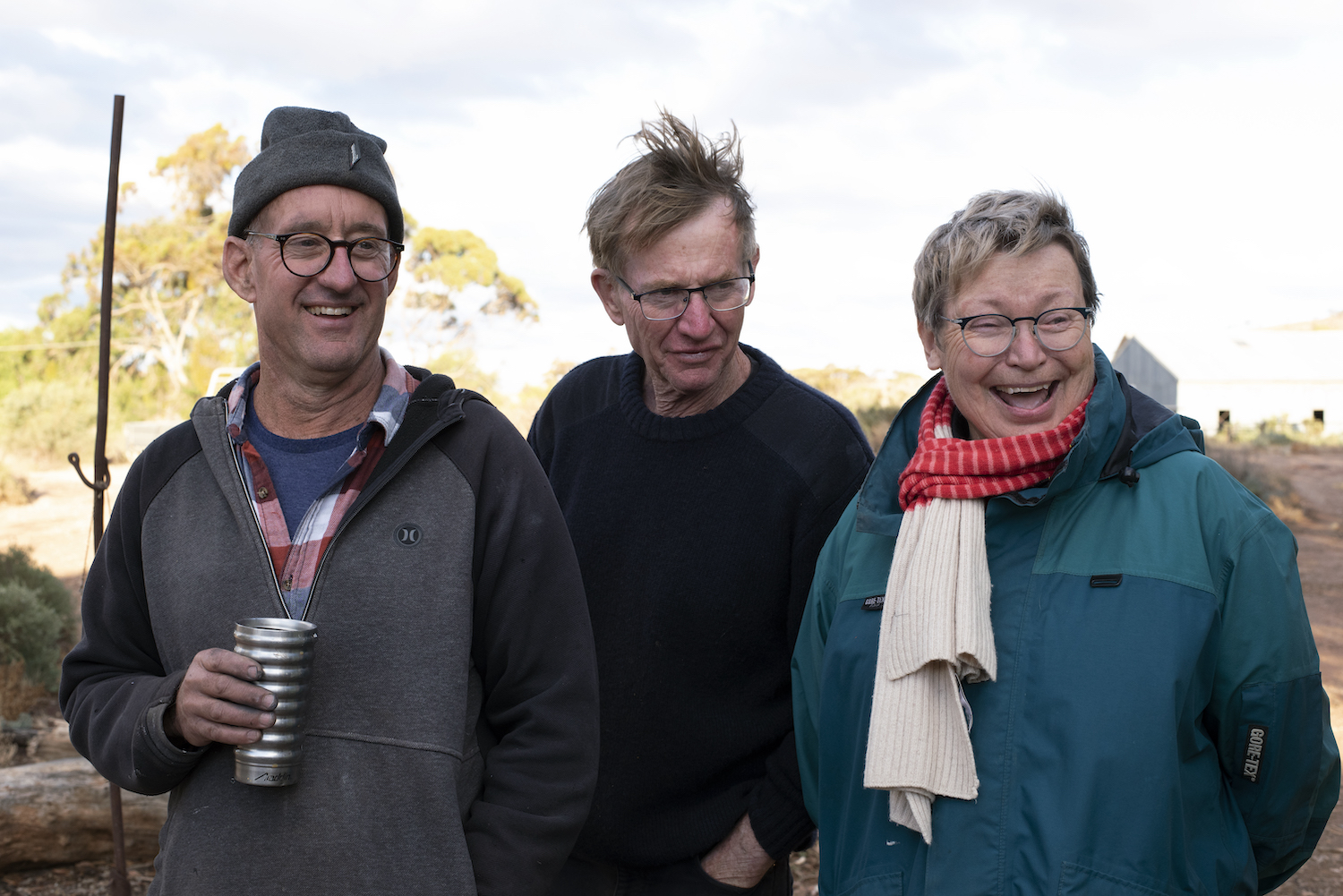
Jake, John and Anne
Day 3 WED 26 May – site: return to Dinny O’Brien’s Camp and creek bed
Collective Noun of the day: an evolution of artists
No rain overnight and at first light, no wind. However, the wind began to pick up by the time the artists left their quarters and returned to Dinny O’Brien’s Camp. A cooler day, 14 degrees at 10.15am. Post-rain, the air was clear and sharp.
Before departing, Anne and Kerry filmed a couple of interviews with artist/mentor John R Walker on his observations of the feel of the landscape and the artists’ camp.
Artists chose different sites than their first visit and many seemed more confident in using the chinese books. As the cool wind coursed down the creek, it seemed a good idea to light a fire in the creek bed, providing a warm, yarning spot.
Jake claimed Dinny’s old bed frame as his working bench and struck a small fire to keep himself warm. Ross drove Denise and Taylah in on the back of his ute, so that Denise could set up her painting table on the creek bed – a much better vantage point and right next to the fire. She was joined by Lisa. Kerry chose a rock outcrop above the bank to make her early studies and then after lunch, crossed the creek to the tributary bed and returned to her first site on Monday, on a field looking up to the Cone ridge. Penny claimed a dugout beneath a rock outcrop in the creek bed, which provided her with protection from the wind. Alison positioned herself on the opposite side of the creek bed to Monday’s first visit. Ross brought Cait out after lunch for her first visit since Monday and she chose a protected site on the creek bank.
We returned to the shearers quarters about 4.30pm and got the camp fire going. Anne and Kerry interviewed Julie and Jake in Ross’s conservatory (good light and clear sound), an hilarious and frank exchange, about their responses to the country, camp and their own practice. Over the course of the next few days, all the artists, as well as the cooks, will be interviewed.
Ross joined all the artists for show and tell in the dining room. The works produced revealed a much more relaxed and confident group with more accomplished, strong works; a great response to this arid landscape and its vibrant colours. Retiring to the campfire following dinner, we witnessed a full lunar eclipse seen at its best because of the miraculous clarity of the air (no dust) and no city lights. The stars and the milky way against the dark inky sky were magnificent.
What a fantastic end to a wonderfully productive day!
Quotes:
Ross: “Its amazing to see the different ways of seeing and interpreting a landscape that I know so well.”
Penny: “I was a little bit nervous at first but I have found a rhythm here. These [Chinese] books are lovely. I like the idea that you can just keep folding them out. I really enjoy that. And getting back to pastels. I did a lot of work with pastels 30 years about and I probably haven’t done anything with pastels for about 20 years now. So it’s really lovely getting back to working with pastels again.”
Alison: “As artists we are looking at the same things and yet interpreting them so differently, which is exactly as it should be. We are stimulated by each other…everyone interprets the landscape so differently. There will be lots of material to draw on.”
Cait: “The big headache came on Tuesday so I lost a whole day… after the migraine, someone asked me “What’s the difference?”… I said it was worth having a migraine because you are all cleared out; sounds are very sharp, but colours and smells…you come out of it and your eyes can see again…it was brilliant…and that riverbed …is a magic place.”
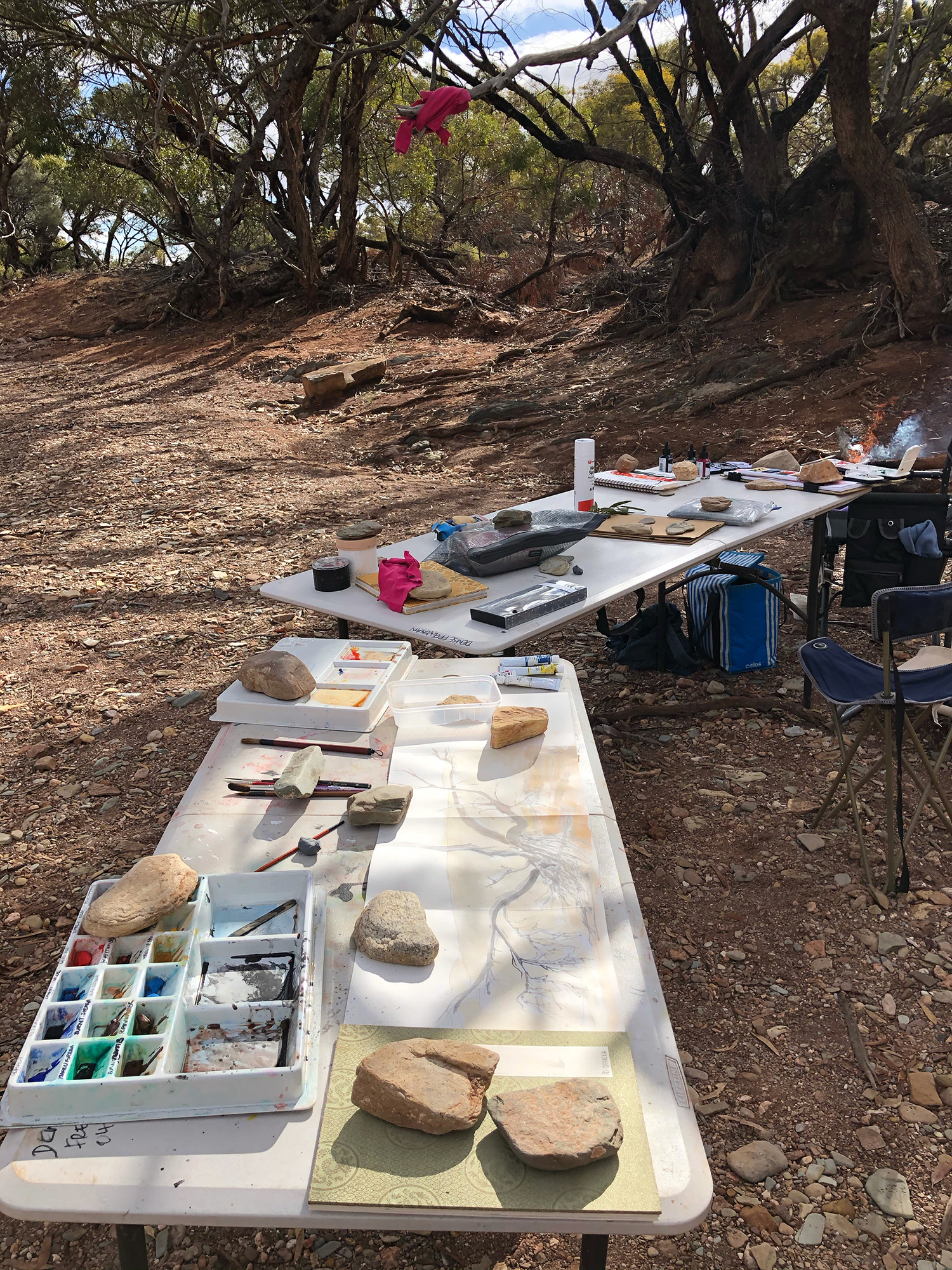
Denise’s double tables
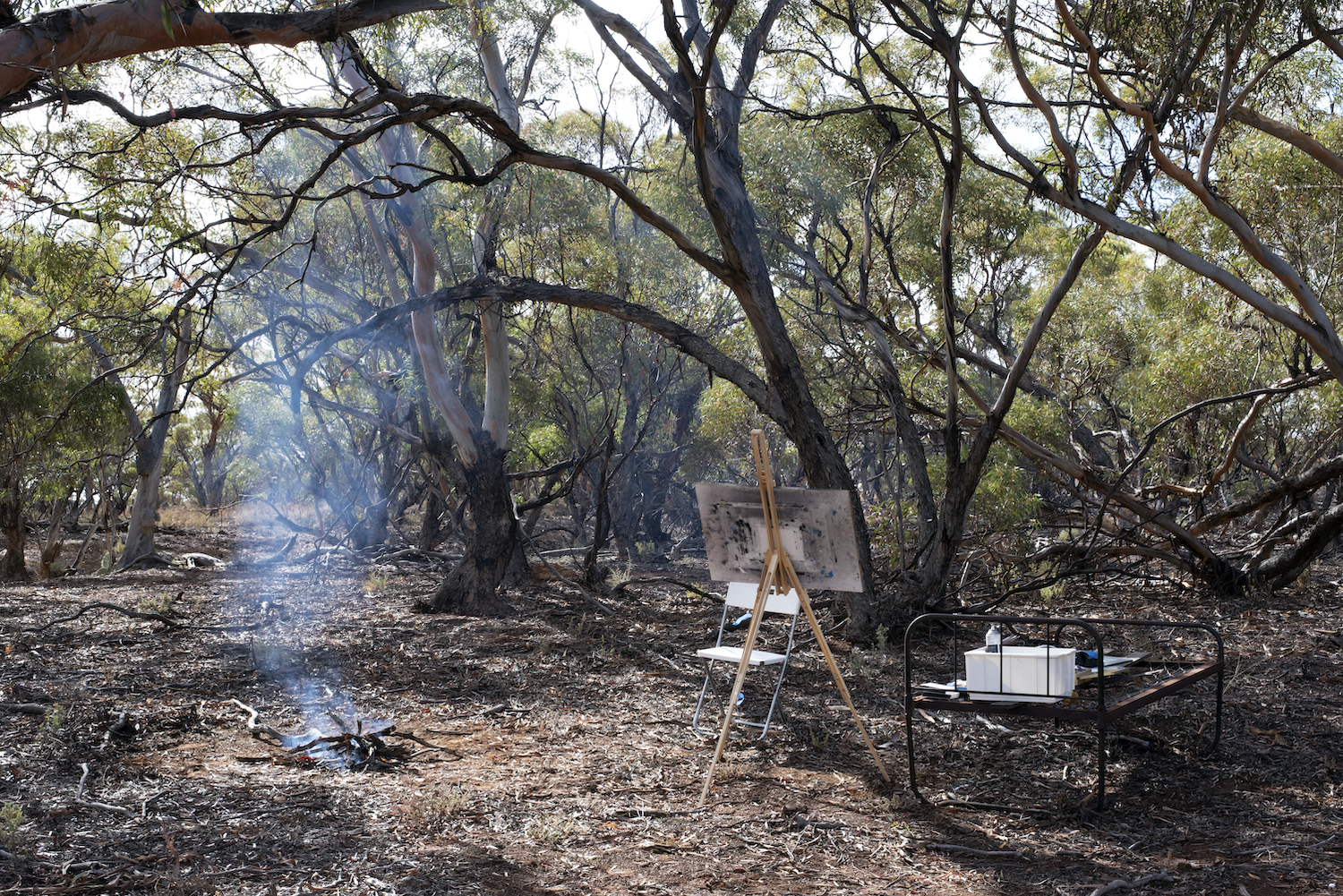
Jake’s spot at Dinny’s
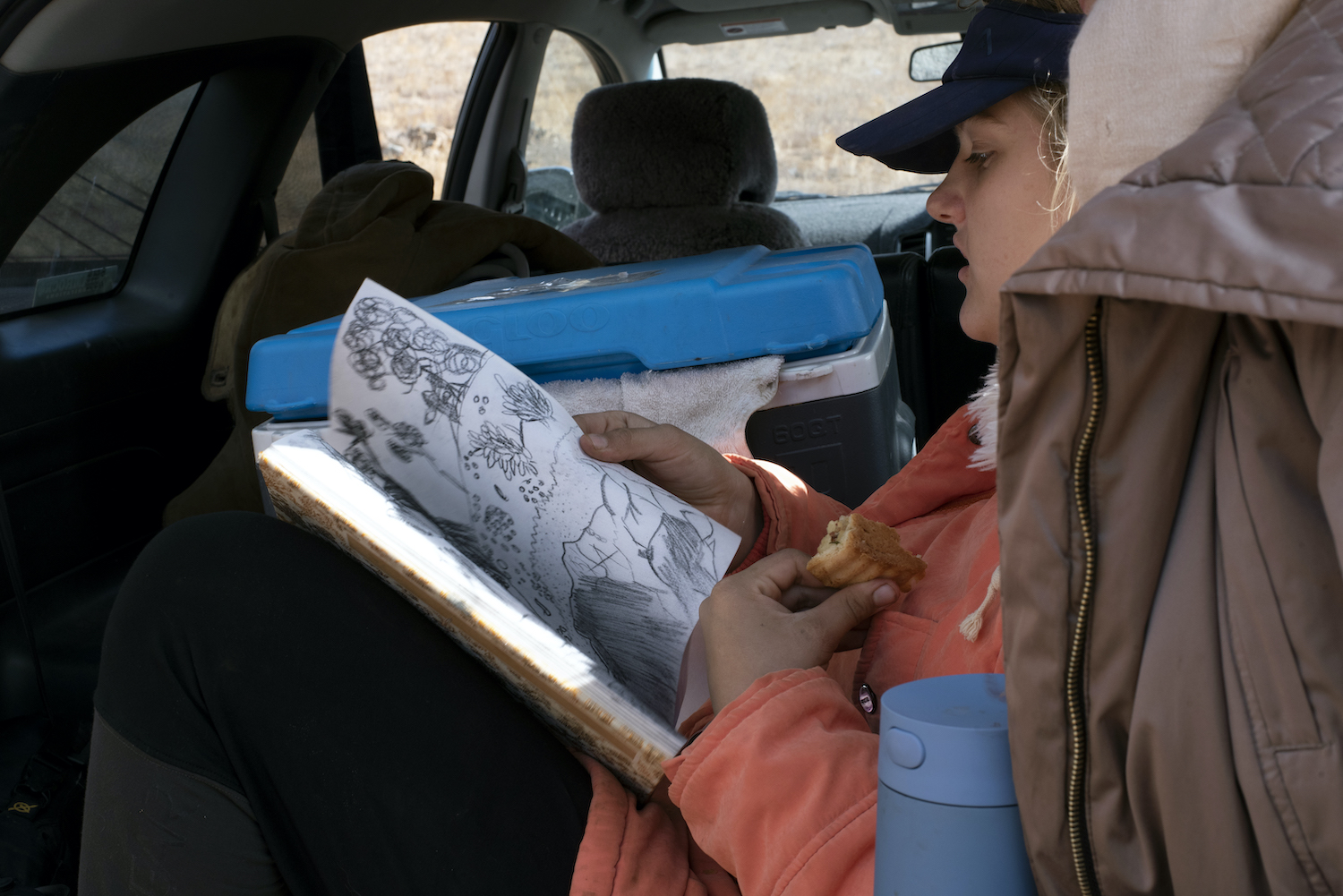
Taylah in the ute with drawing
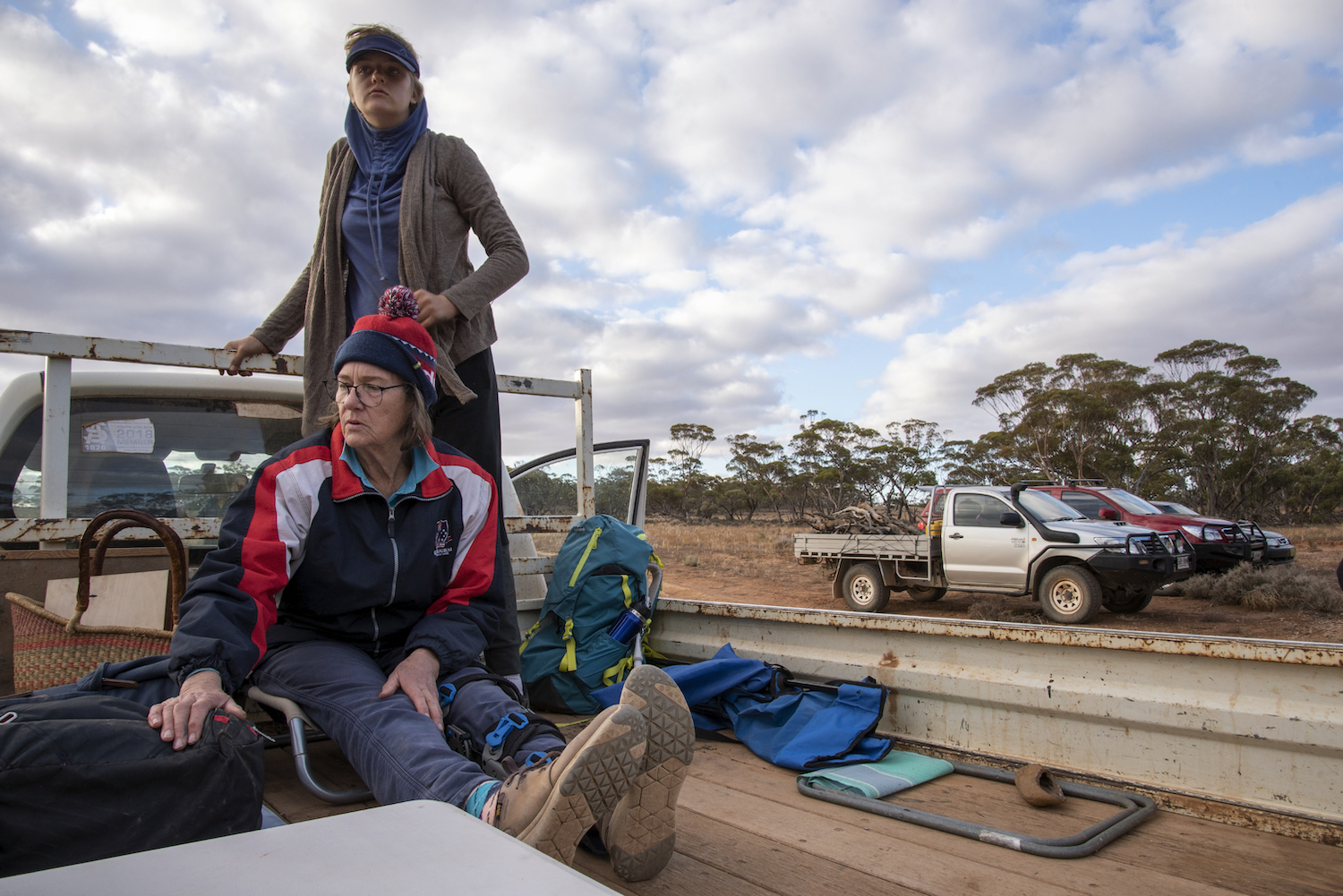
Denise and Taylah on ute
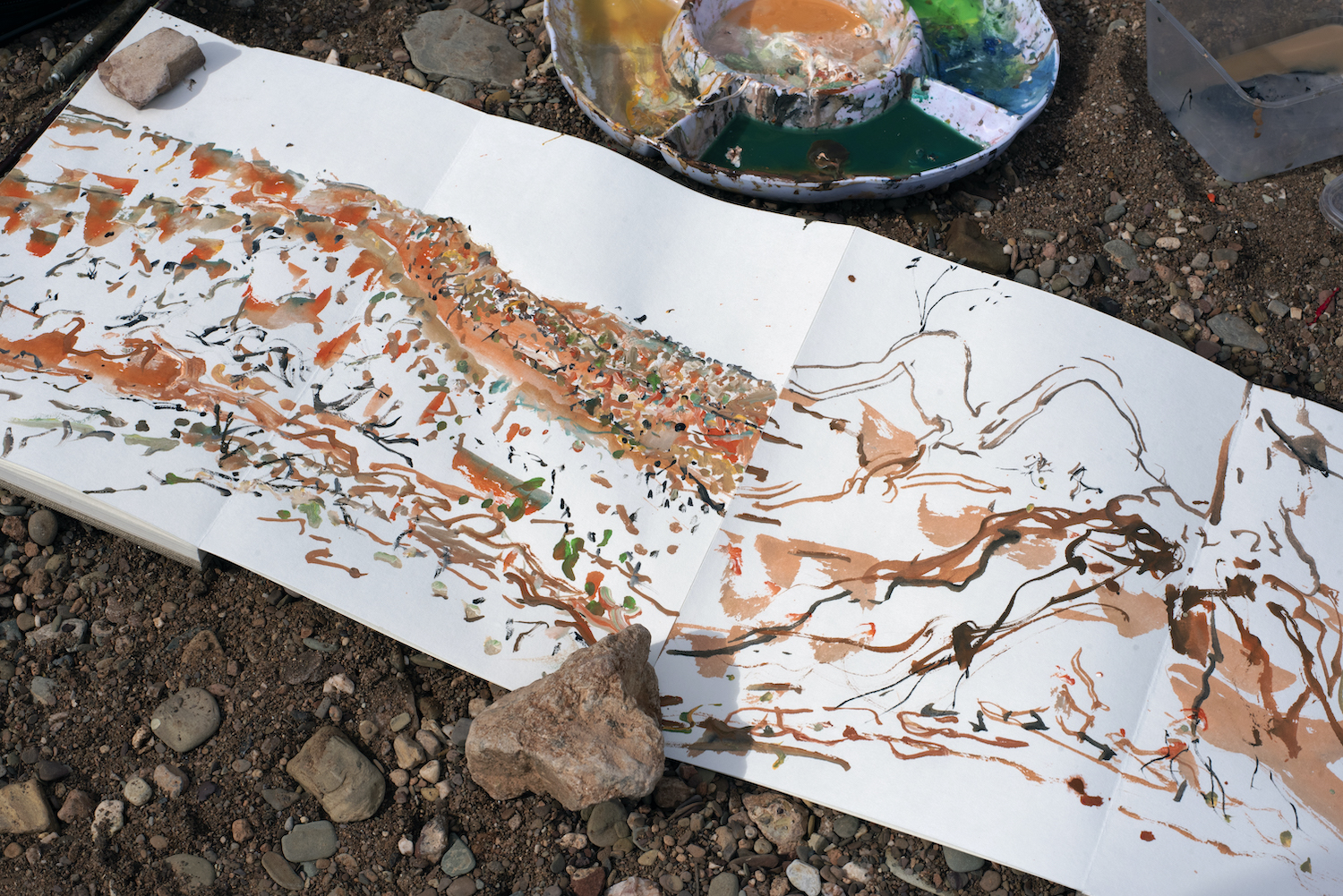
John R Walker’s drawing with rocks
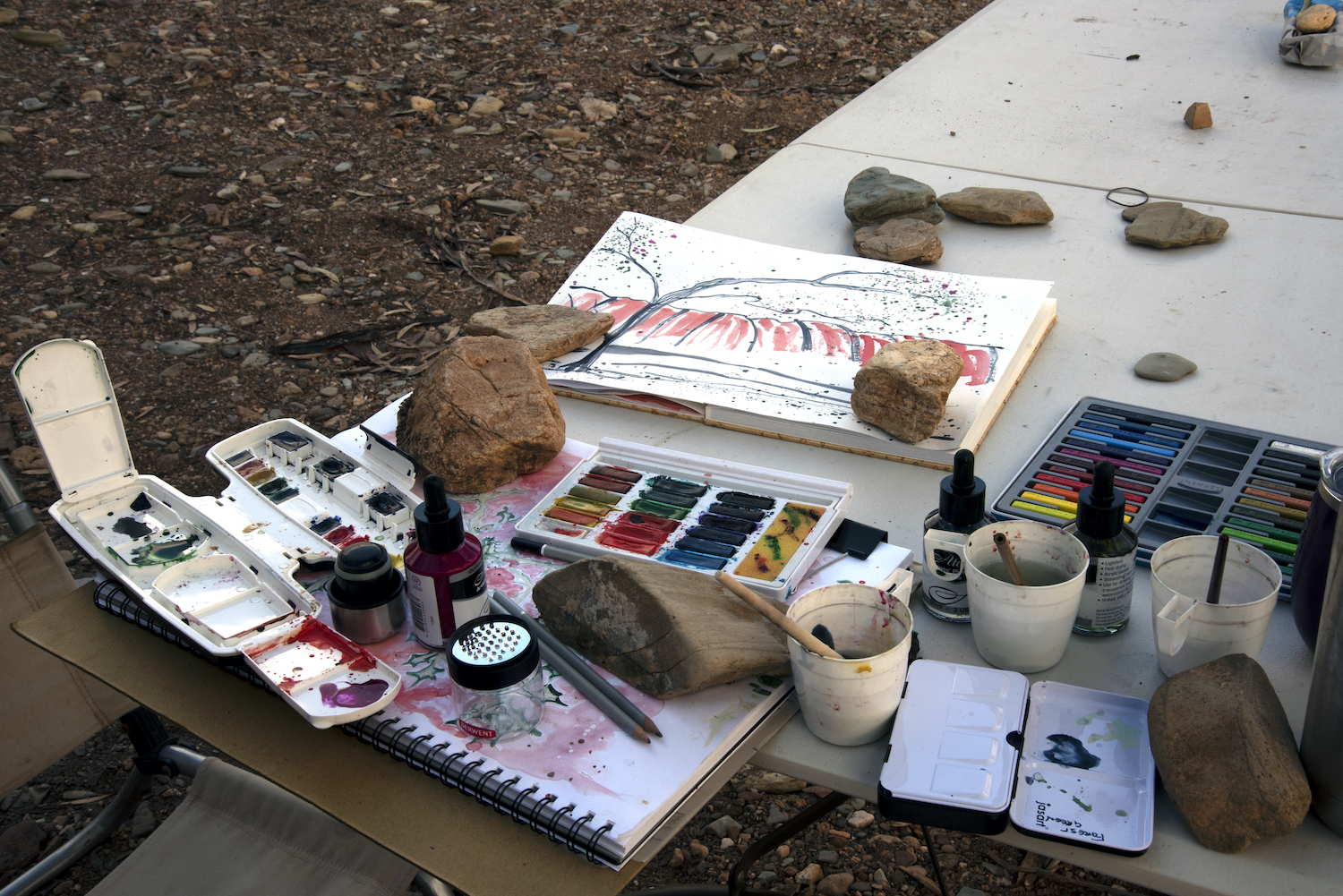
Lisa’s drawing and materials
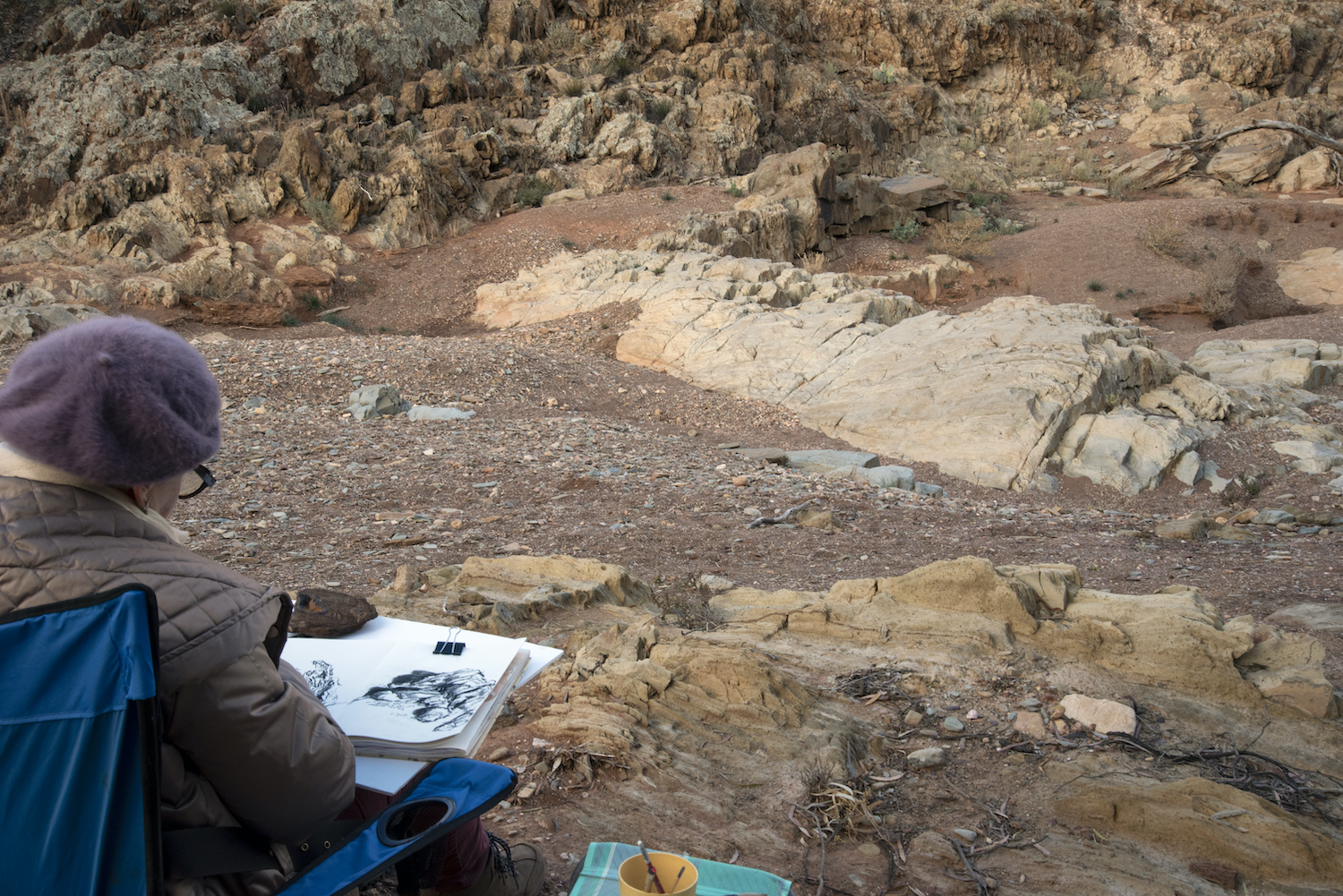
Alison drawing
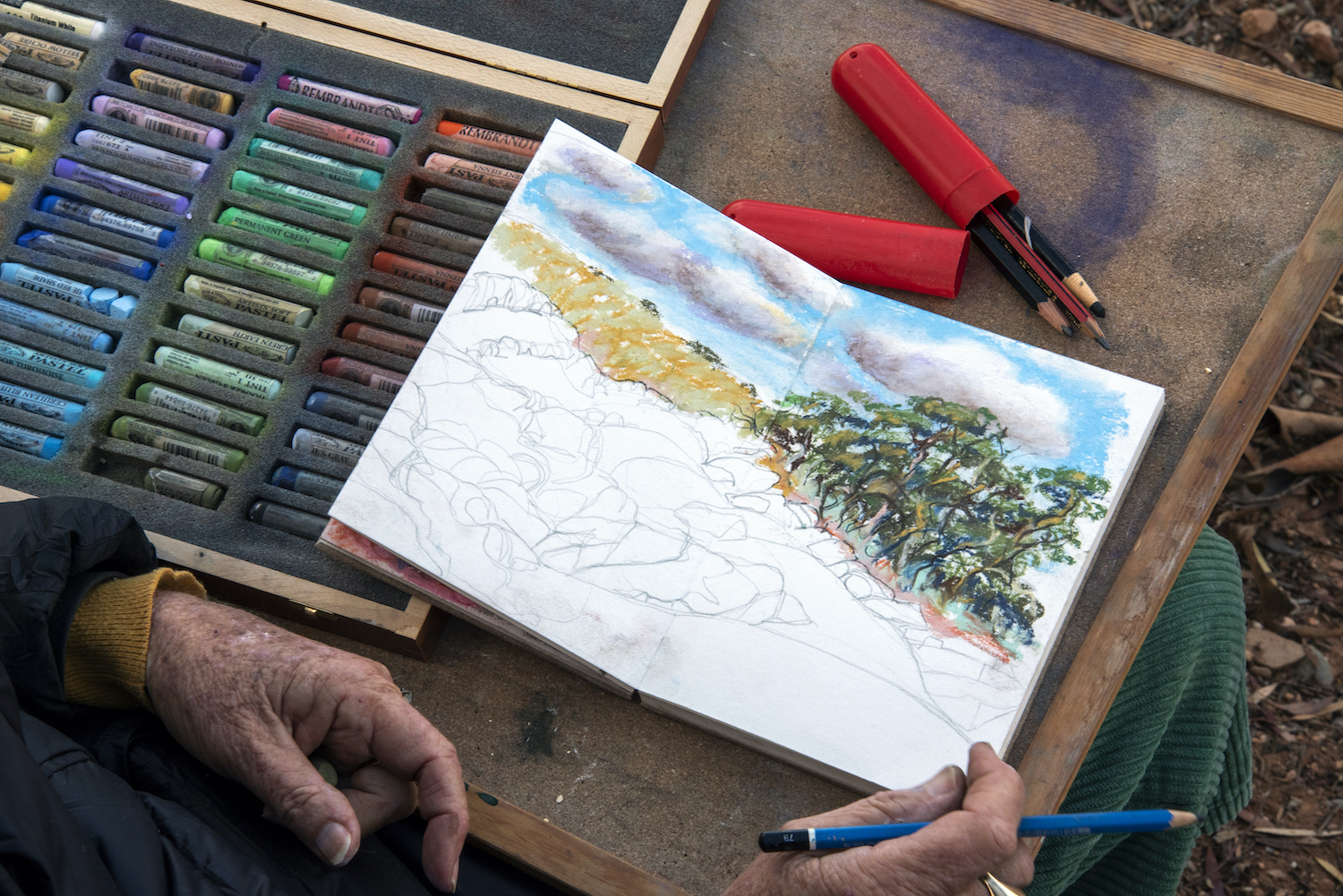
Cait’s drawing
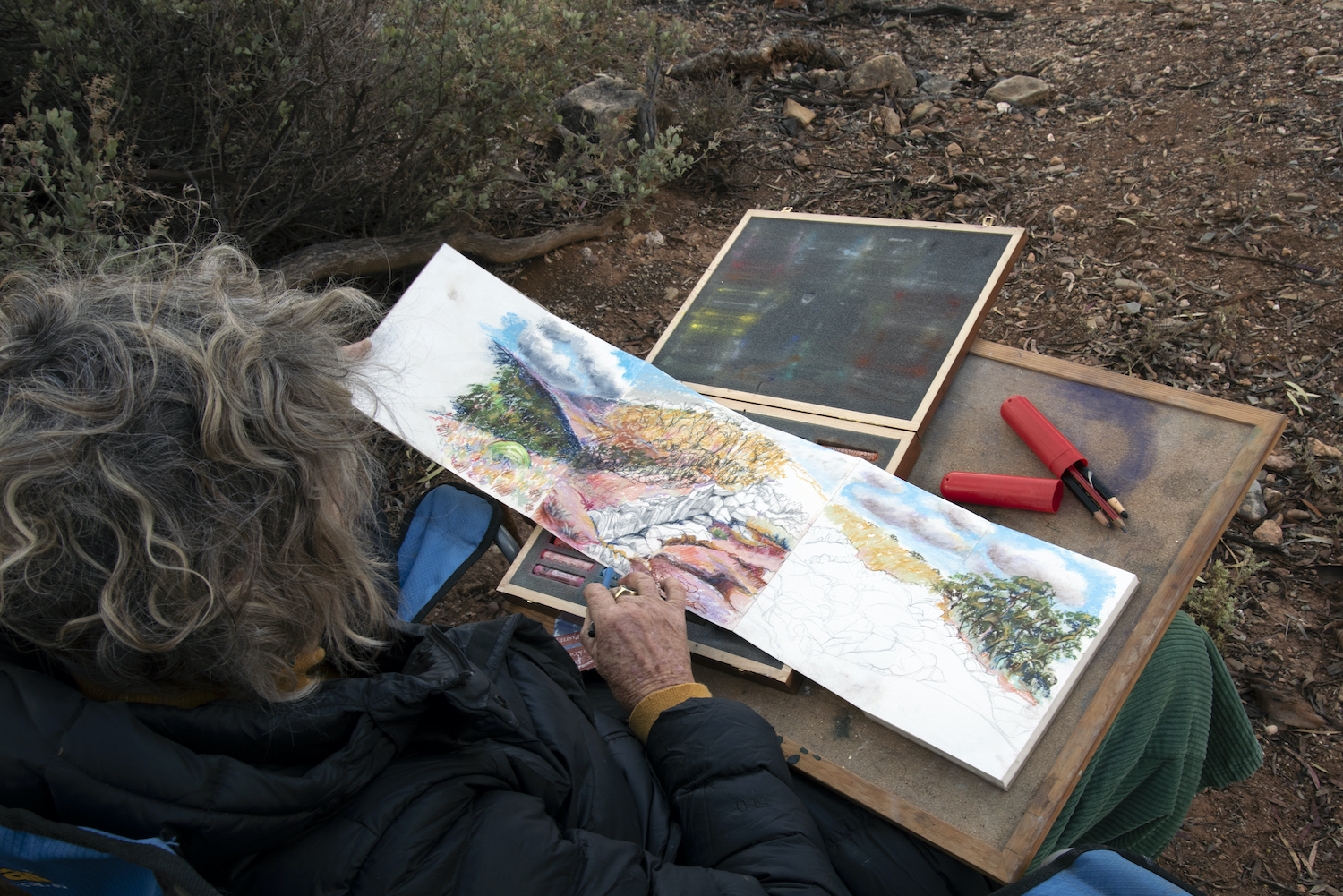
Cait’s drawing
Day 4 THURS 27 May – site: Porcupine Well, Dinny’s camp and Pitcairn Woolshed
Collective Noun of the day: an effervescence of artists
Today at breakfast, it was decided that people could choose where they wanted to work. Jake based himself at the Woolshed, Cait and Alison travelled out to Dinny’s camp creek bed (returning at lunchtime) and the rest of us were based around Porcupine Well and the nearby creek bed and banks. Denise chose the hill above Porcupine Well as her base. It was a beautiful clear day, with some scudding clouds, warmish except for the wind chill.
After lunch, Cait and Alison joined the group at Porcupine Tank, basing themselves half way up the hill above the tank. Jake continued working at Pitcairn Woolshed. Penny crossed the creek bed and found her position in the scrub, protected from the wind, and with a great view of the range to the south. Just before show and tell, Anne and Kerry interviewed John, Penny, Lisa and Denise on their experiences at the camp.
Today’s show and tell was another revelation – such productive responses to country and such inspired interpretations. After dinner, around the campfire, John played the Armenian hymn ‘Bats mets ter’ (Open to us) which for him epitomises the ‘hum’ reverberations of the vastness of Australian marginal landscapes (link: https://youtu.be/hetYU-T_BHc). Ross brought his wife Gen (who had just returned from Adelaide) over to meet the artists, and some good red wine was shared. Anne and John cranked up the music with some inspired dancing around the campfire.
Quotes:
Julie: “I’m not a landscape painter at all. I’ve come from still life and interiors to outside. Scary. It moves and changes. And with the day, the light changing minute by minute, you’ve got to keep up with your light falls.”
Denise: “John gave me a Chinese book in 2016…we did a house swap. He said ‘Take this with you’. I had a long skinny book and I went to Broken Hill and did a picture and then wherever I went, every place I had been to, drew in the book. By the time I got to their place, I had run out of pages, and then I realised I could paint the reverse side. I had done it all in pencil with some colour…I was doing a record of the journey.”
Jake: “Going for walks is good just to experience the landscape. I think that is a good way to become part of it.”
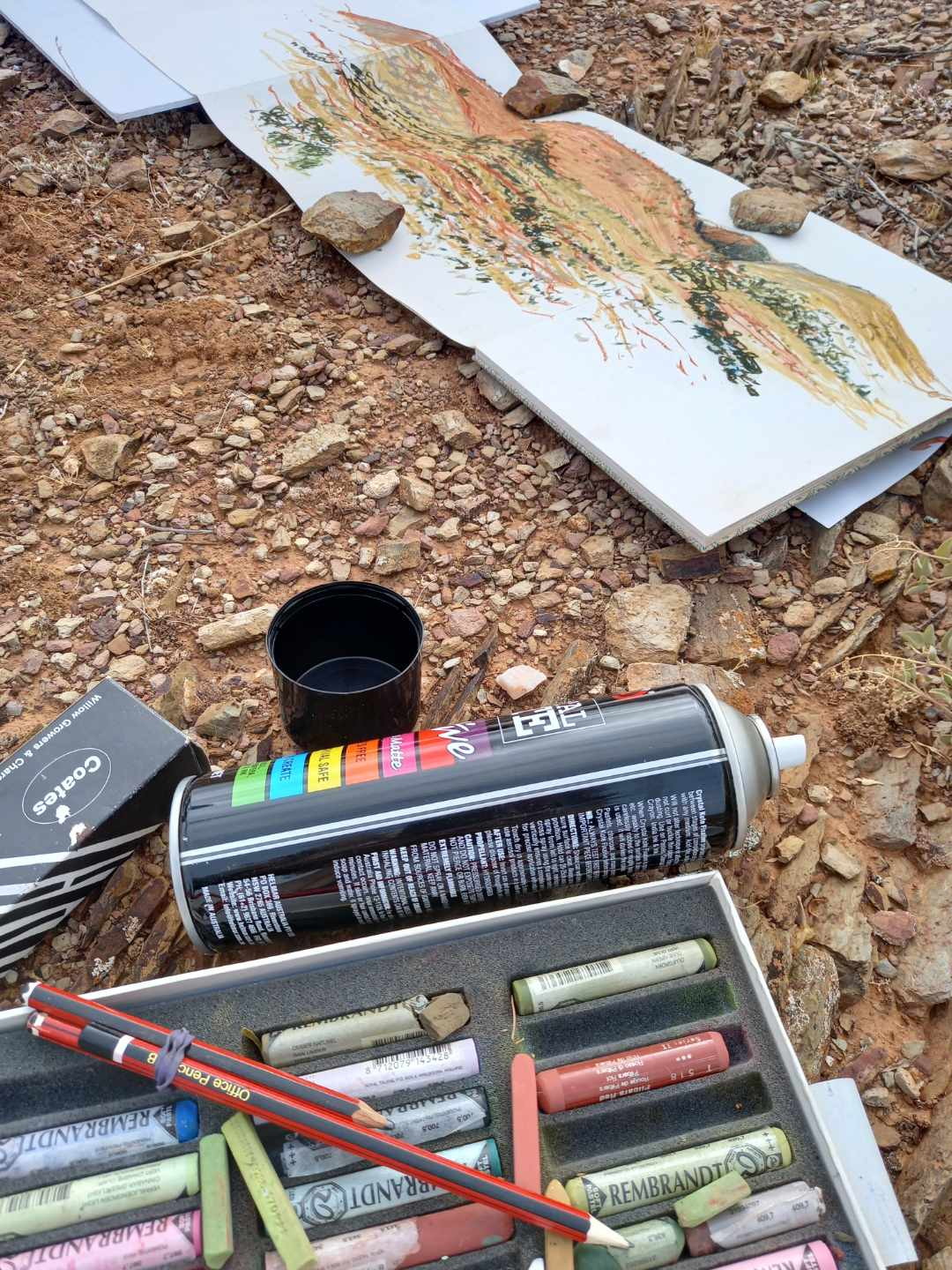
Alison’s work in the creek bed – photograph by Alison Laycock
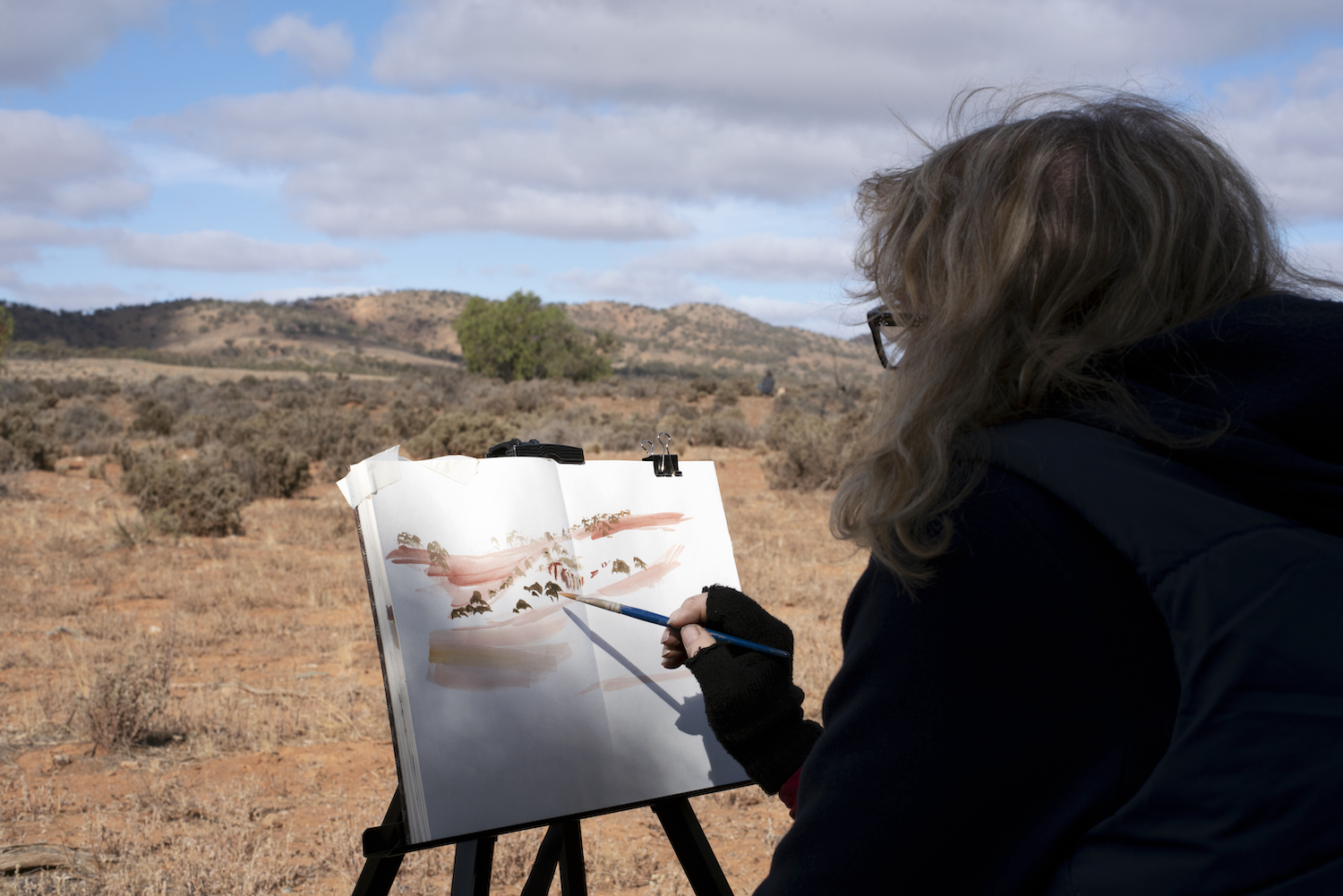
Julie painting
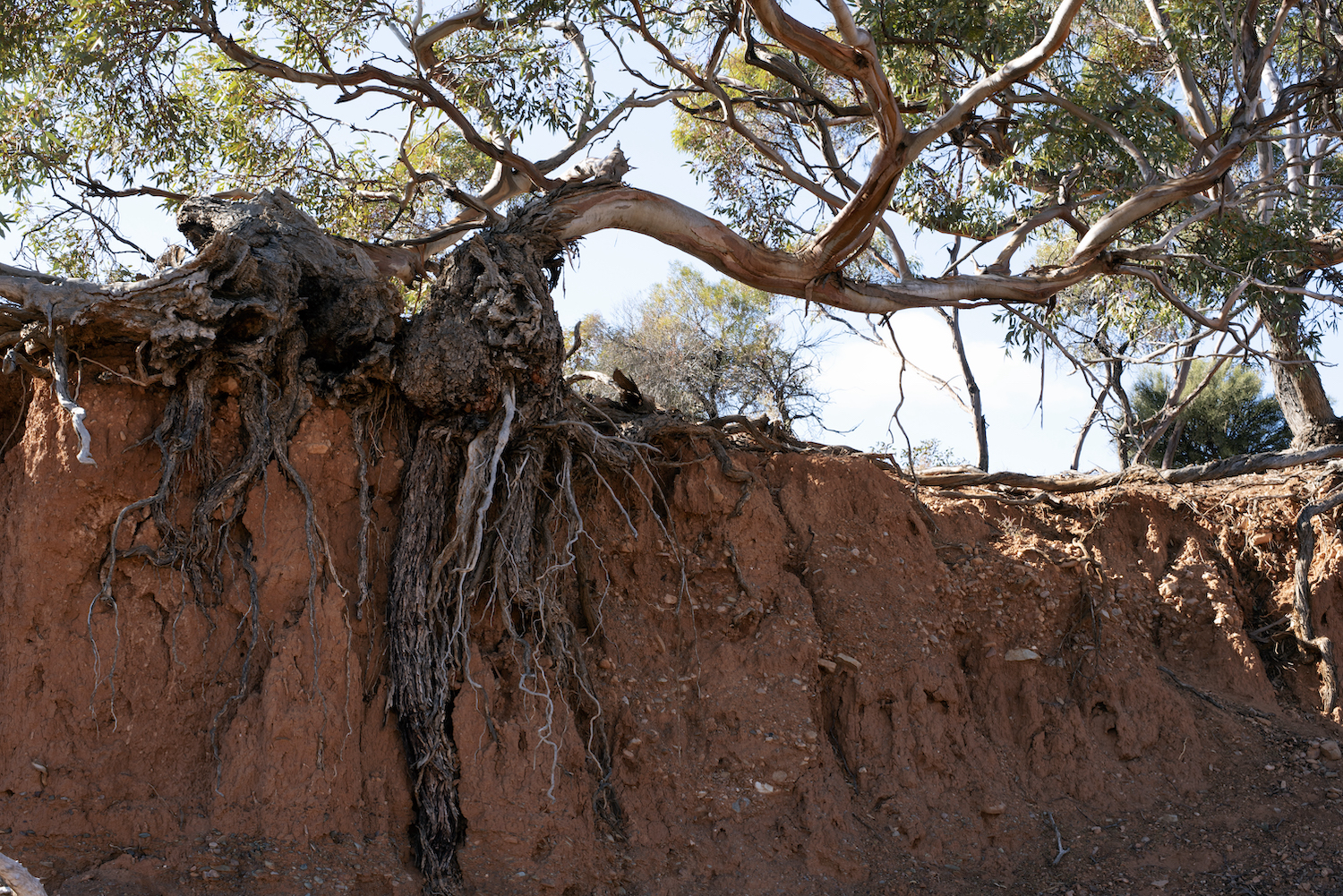
Tree with roots exposed
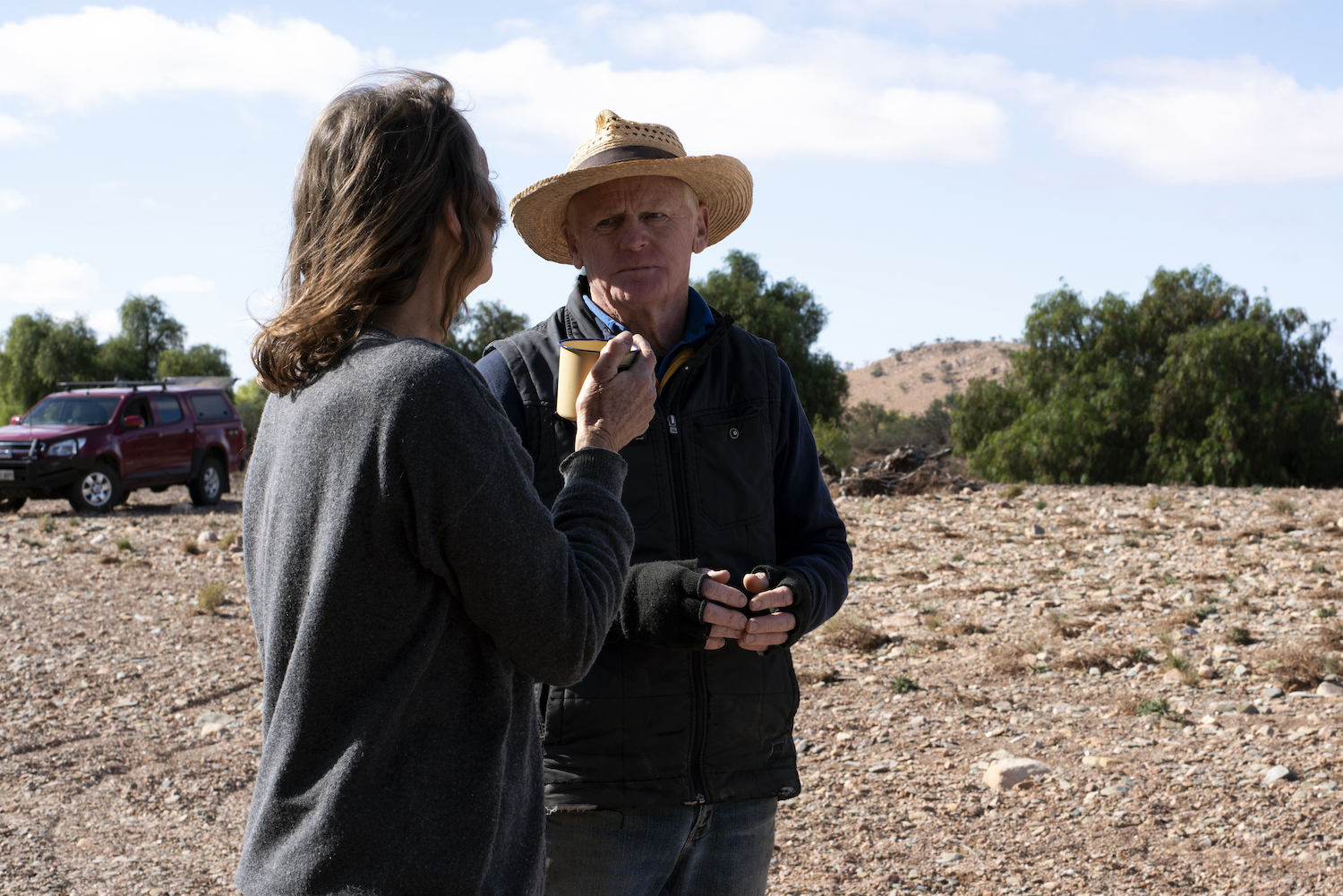
Penny and Ross
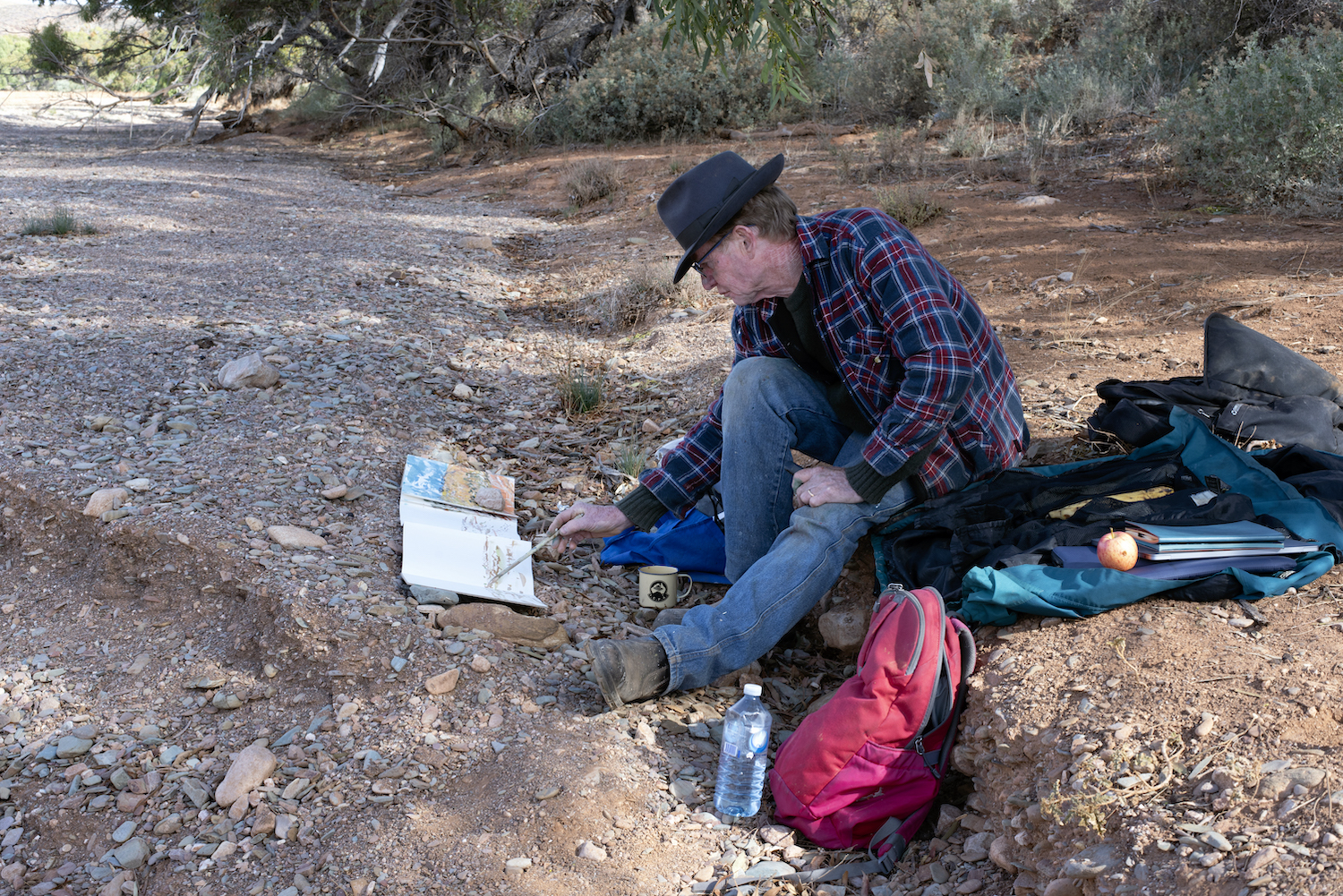
John R Walker painting
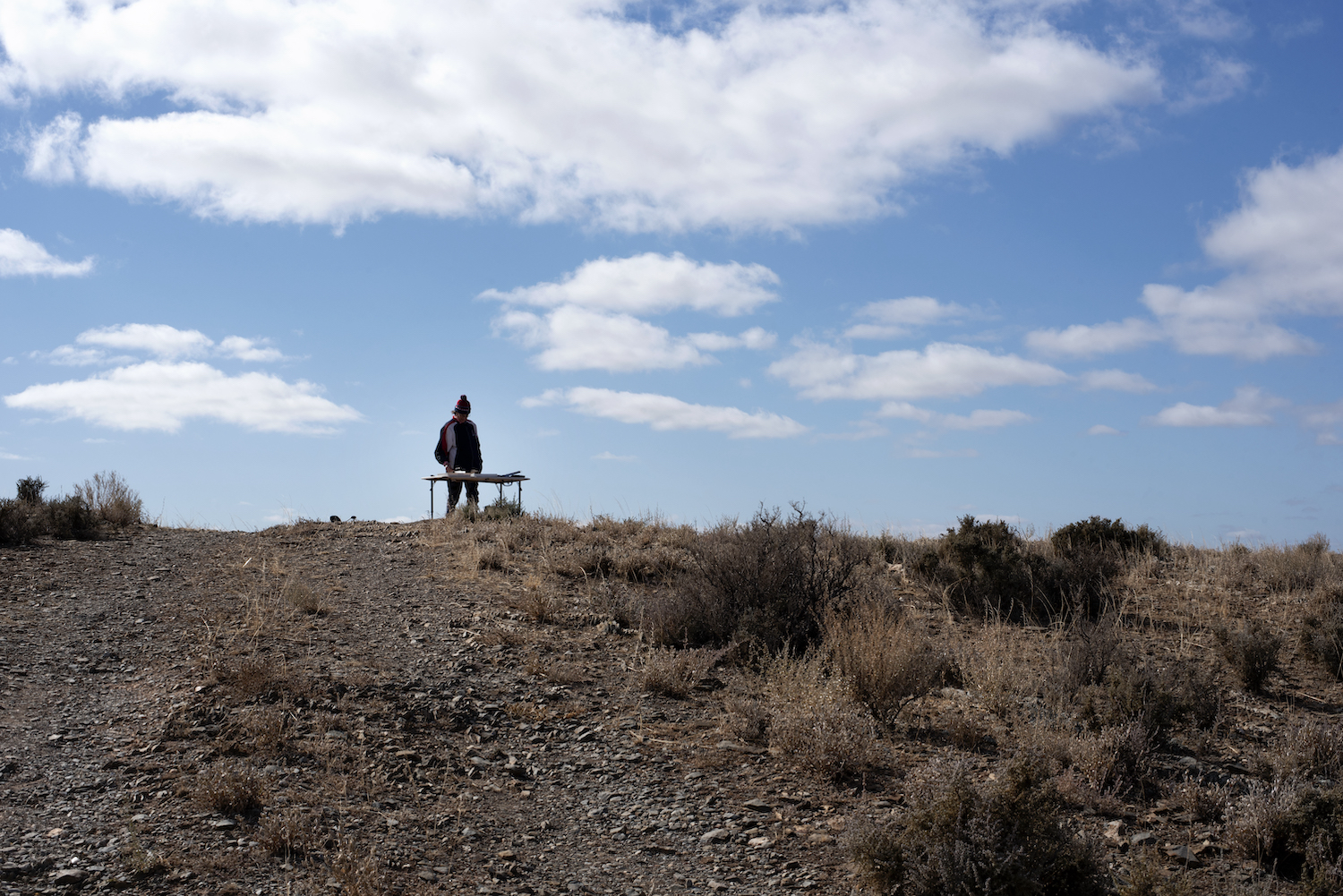
Denise on the hill
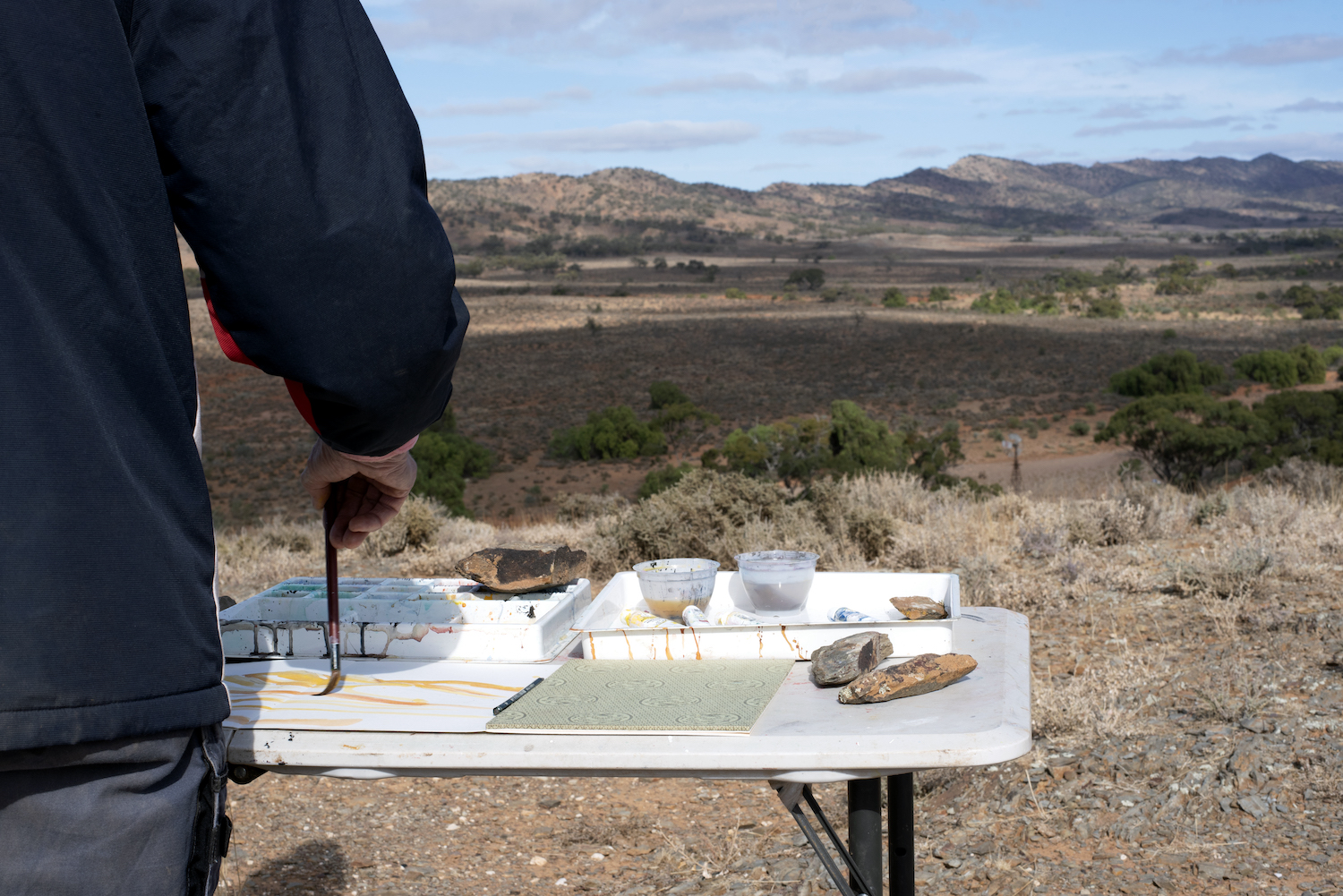
Denise at her table
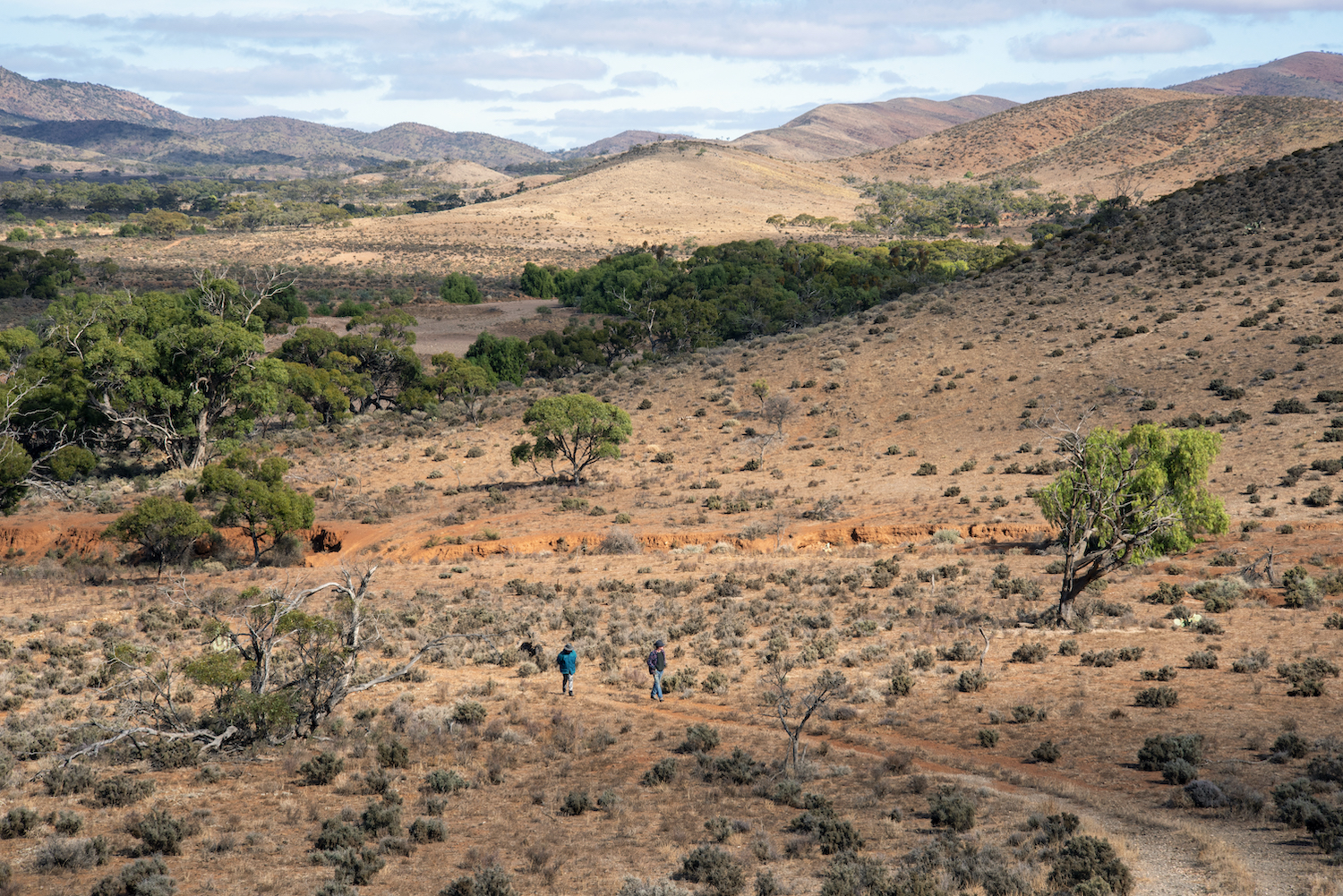
hillside
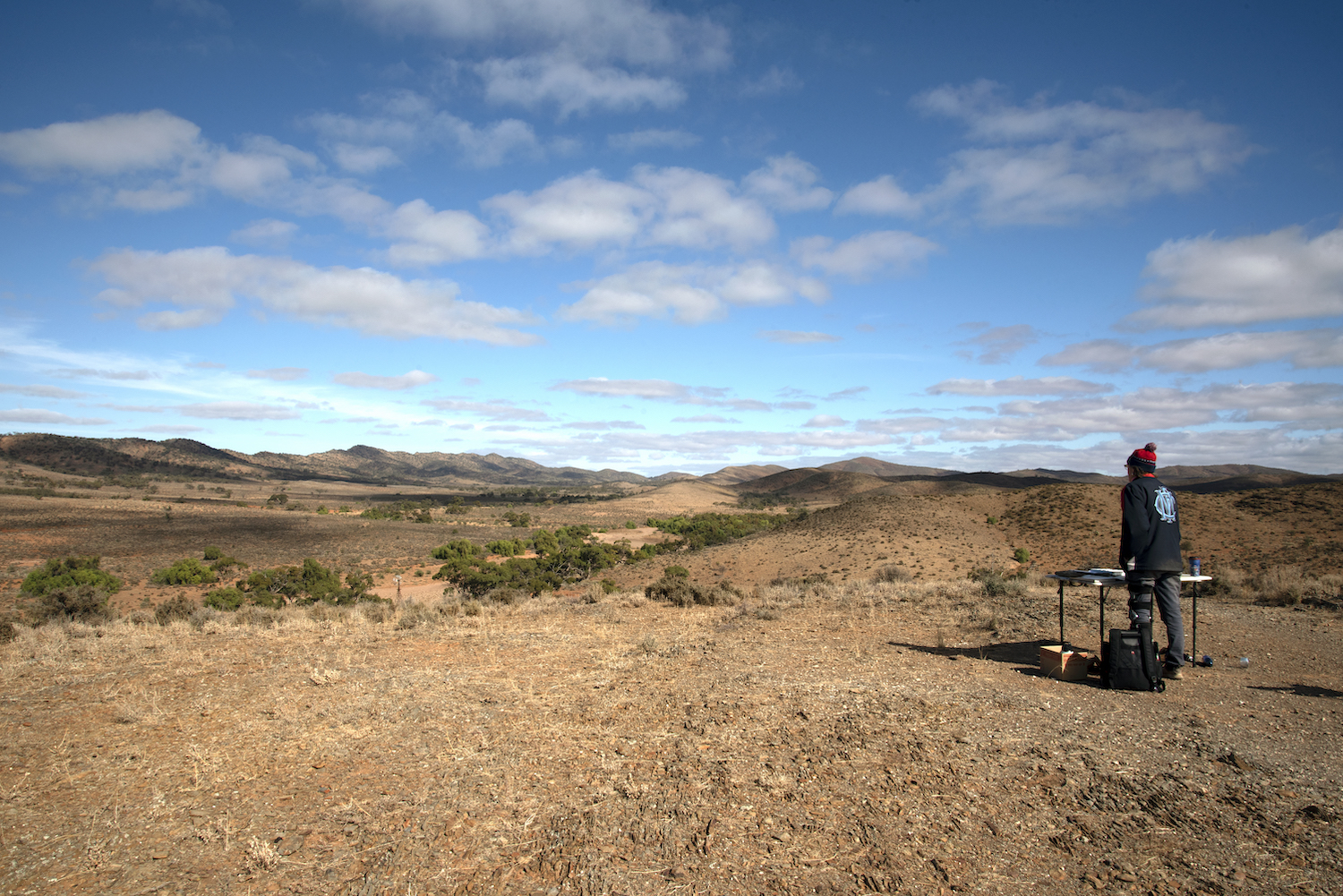
The plain and ridges
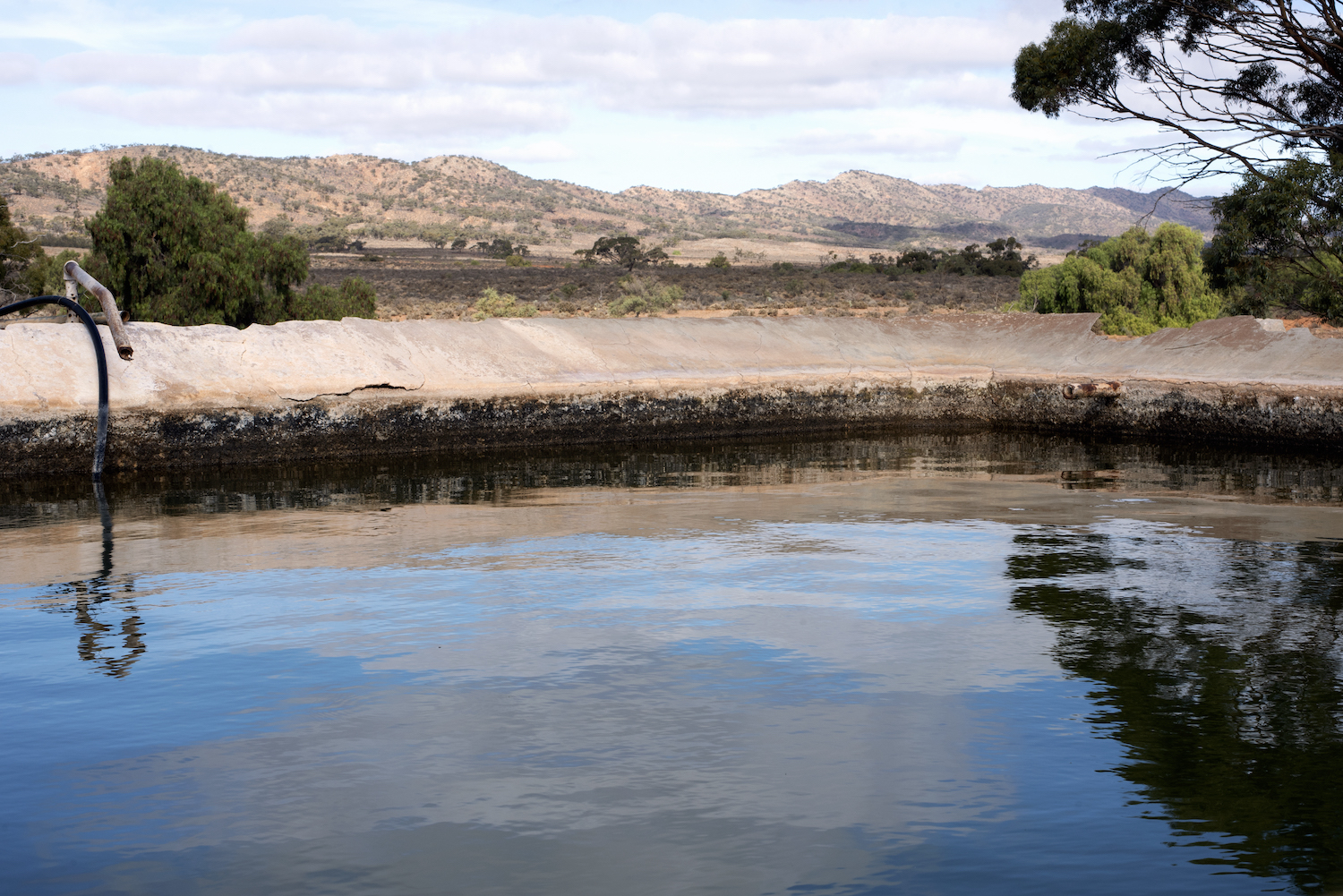
Porcupine Well
Day 5 FRI 28 May – site: Porcupine Well and ridges and Pitcairn Woolshed
Collective Noun of the day: a triumph of artists
Day dawned clear and very cool, with a chill wind. Last day to work. The energy amongst the group is focussed. Artists headed off to where they wanted to work. Penny and Julie walked up to the hillside above Porcupine Well, with Denise and Taylah perched on the top of the opposite ridge. Jake set up camp at Pitcairn Woolshed, while Alison and Cait headed out for a final morning at Dinny O’Briens’s camp and creek bed before returning to the rise above Porcupine Well. Lisa moved between Denise’s table on top of the ridge and Pitcairn Woolshed. Kerry spent time around the Woolshed and the homestead tip. John wandered down the creek bed and up the ridge to visit each artist.
Lunch was served in the dining room and all agreed that all the works generated over the past five days would be displayed in the Woolshed for the final show and tell. Jake and Ross swept out the floor and a installed lights in preparation for the display. Anne and Kerry interviewed Cait and Alison, cooks Justine and Graeme and Jess and Taylah about their experiences during the camp.
Everyone gathered at 4pm in the Woolshed, bringing in their works – Chinese books, sketches, oil on board including installations made of found objects around the painting sites visited. The amount and quality of the work on display was remarkable. Everyone had tried the Chinese books and produced some revelatory journeys in gouache, watercolour, charcoal and pastels. A truly celebratory exhibition! As John said ‘I think you should all be very happy.’
Ross and Genevieve Sawers were delighted with the outcome of the artist camp and brought over the homestead guest book which included entries by Charles Mountford and other geology professors from the University of Adelaide. We were all invited to contribute to the guest book. Ross also provided Denise with two wool packs and the Pitcairn stencil (painted on to a wool pack using black acrylic) for use in the artists’ camp exhibition back at Burra Regional Art Gallery.
Quotes:
Penny: “I see a lot of women in the same boat I am in, where we had children and the need to put food on the table which meant more money, and less about our art. You have to make choices and I actually ended up making a lot ephemeral work because the materials are free and that is what I have been doing for the past 15 years. But I started off making marks on paper and that’s my passion.”
Kerry: “I was near the tip, drawing some of the discarded machinery, thinking about the vastness of time with that Armenian music floating [in my head]…juxtaposed with the kangaroo skull; a reminder of the brevity and fragility of our existence. Everything merged but the range endures.’
John: “If you just get out and work, and not worry about it too much, after a week or so, the energy feeds. The more energy you put in the more energy you get. Things start sparking ideas…It is like a garden… you are putting in food, putting in compost, doing the work and before you know it, after a year or two, you’ve got soil. It is really quite simple…. simplicity is the hardest thing, but its is all about simplicity…The magic is in what is all around us.”
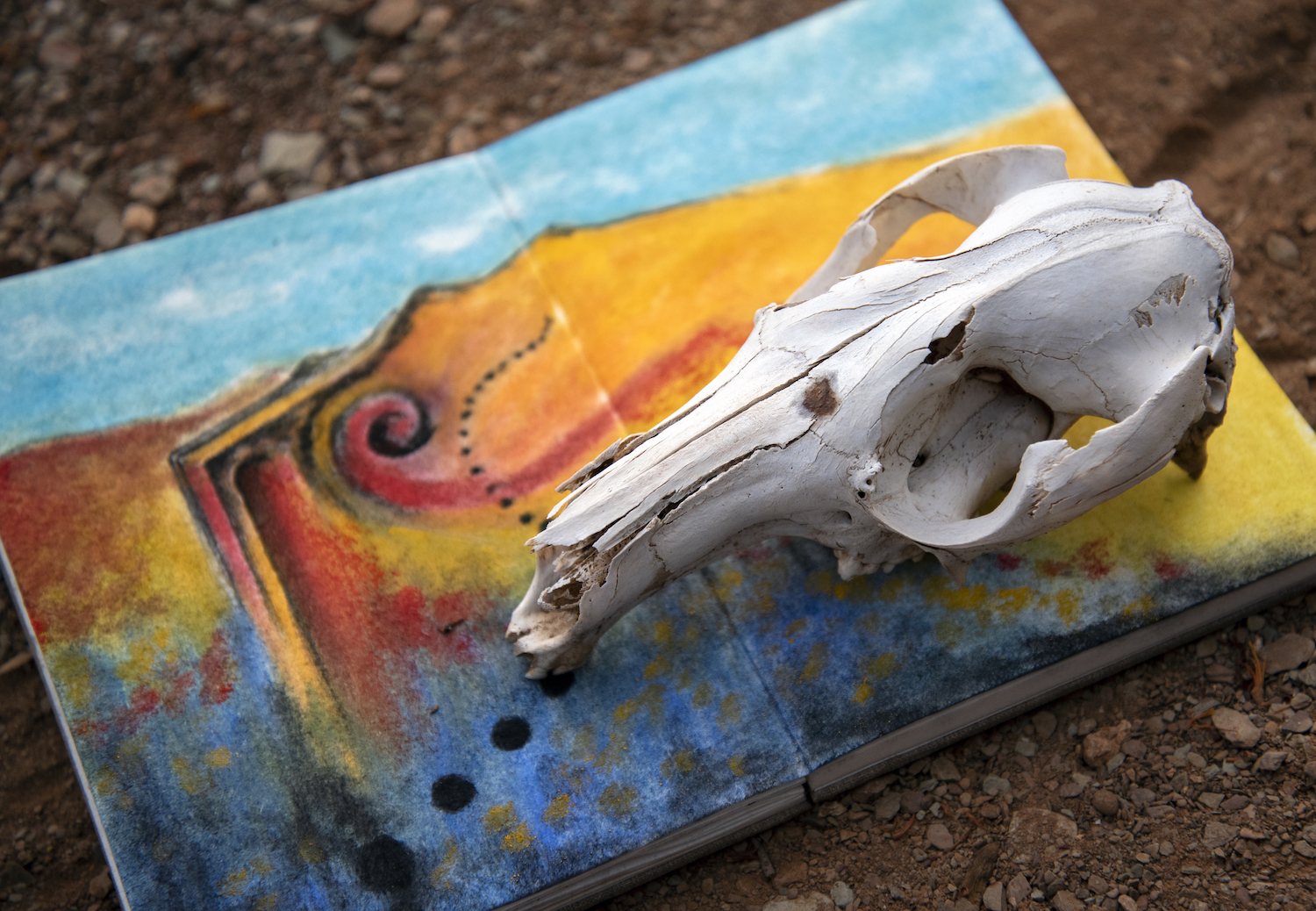
Kerry’s drawing with skull
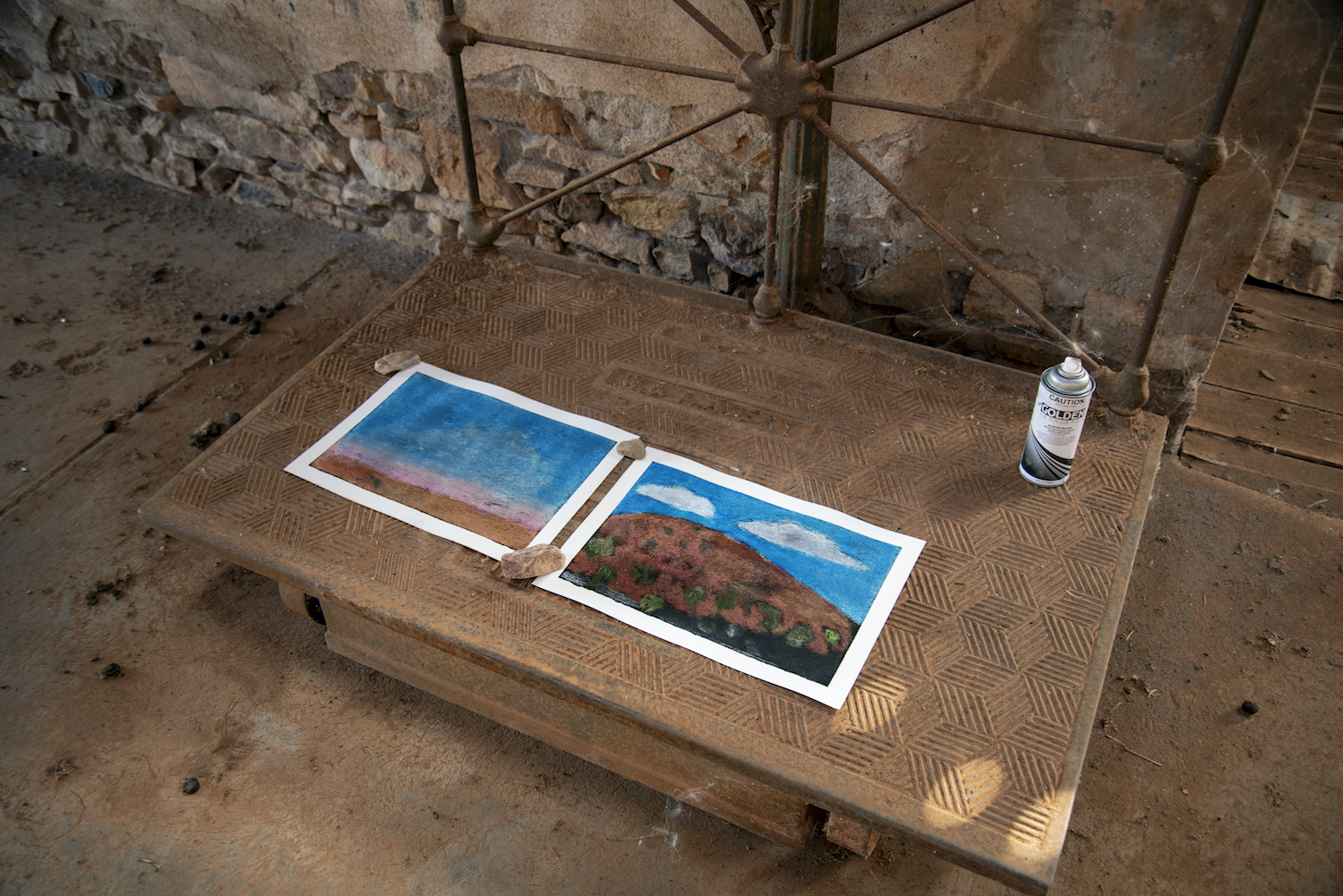
Jake’s drawings
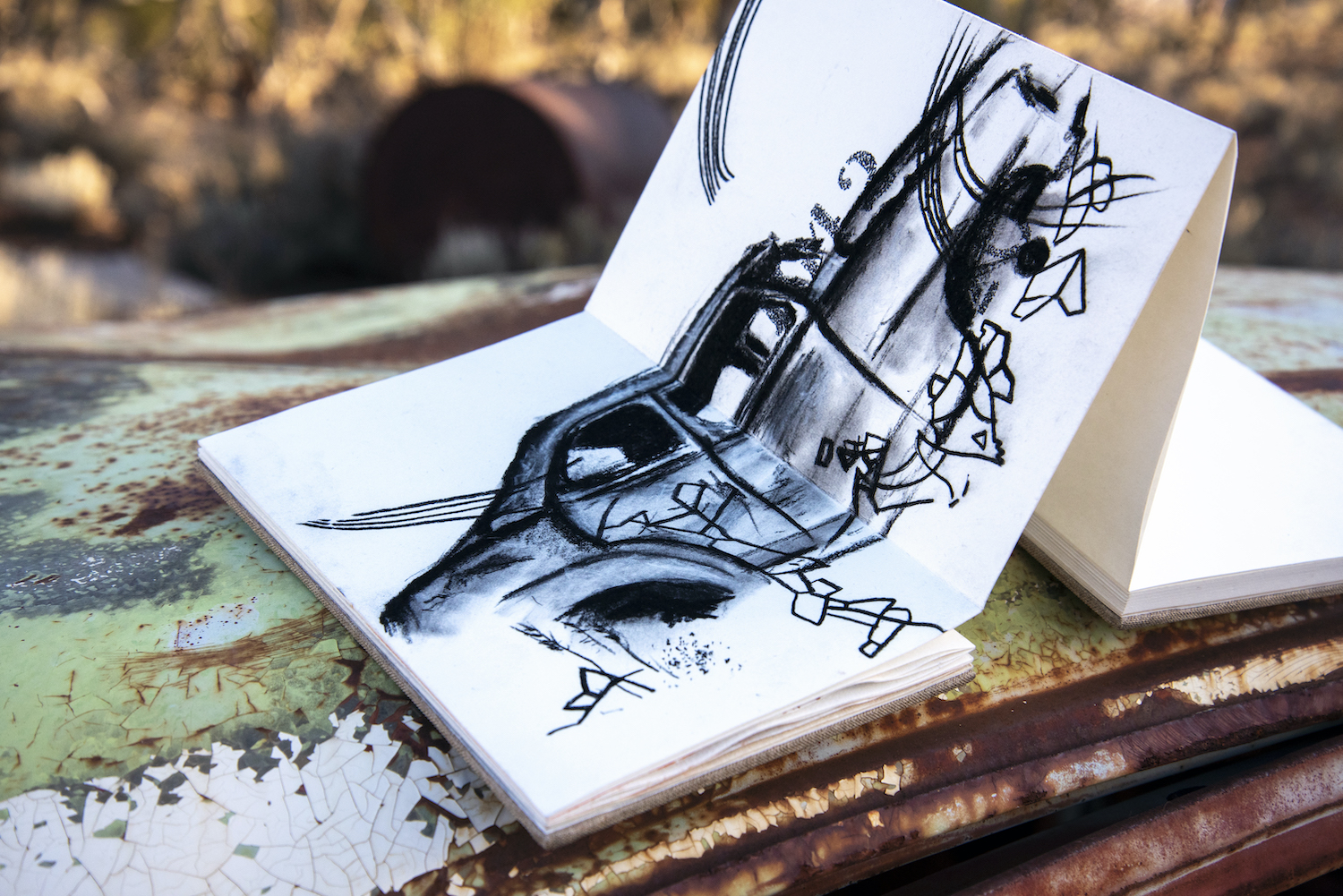
Kerry’s drawing
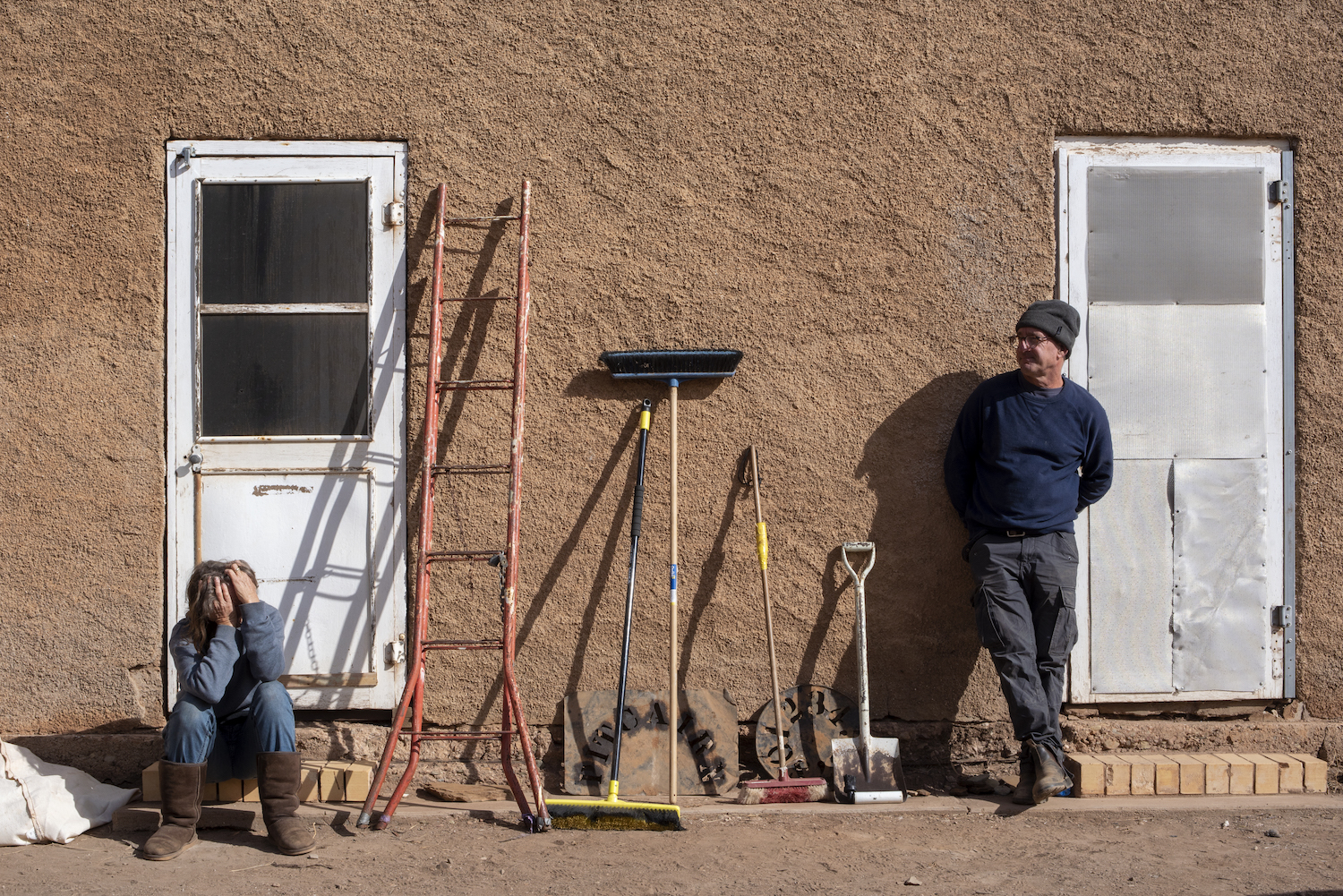
Jake with cleaning gear for Woolshed prep
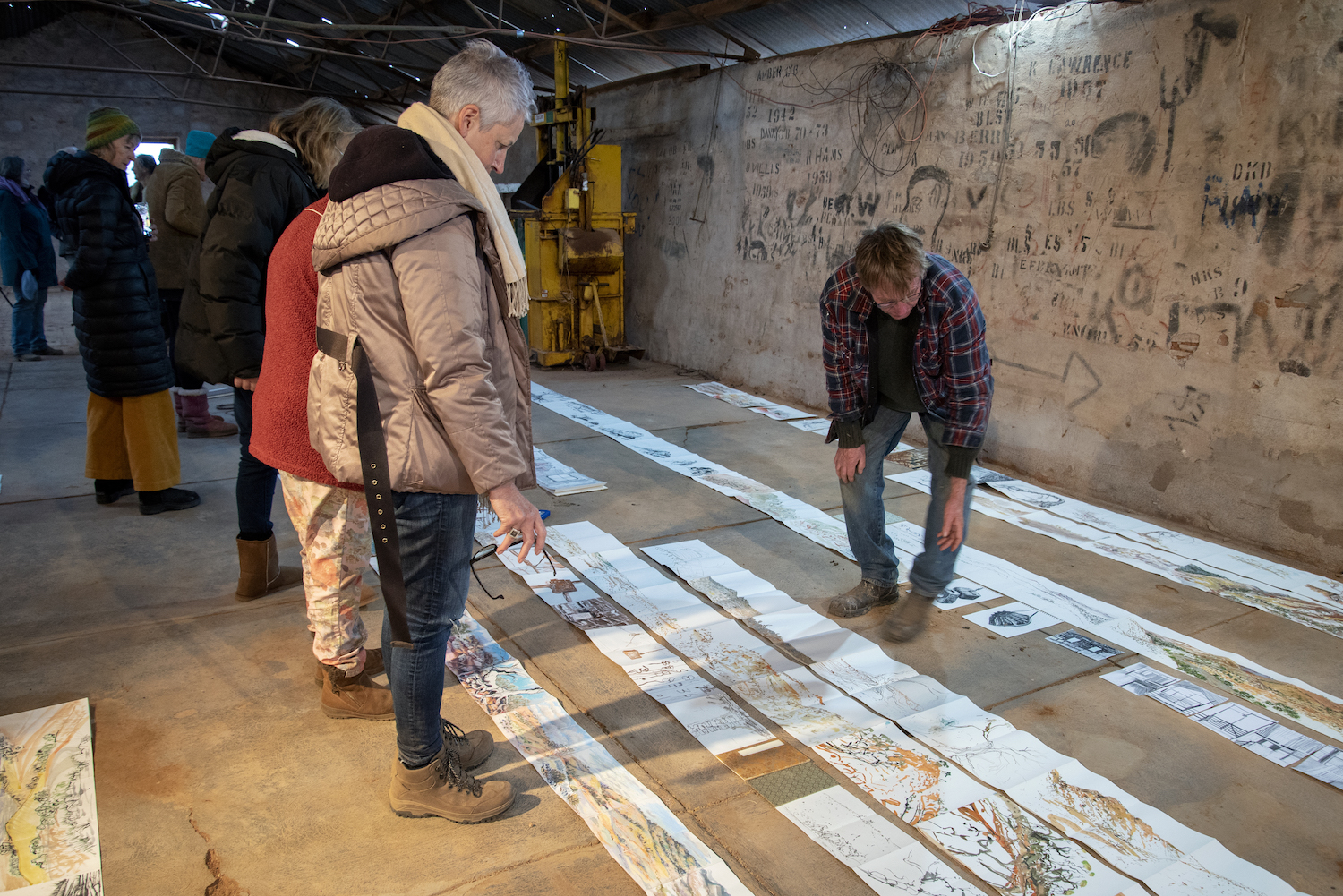
looking at works
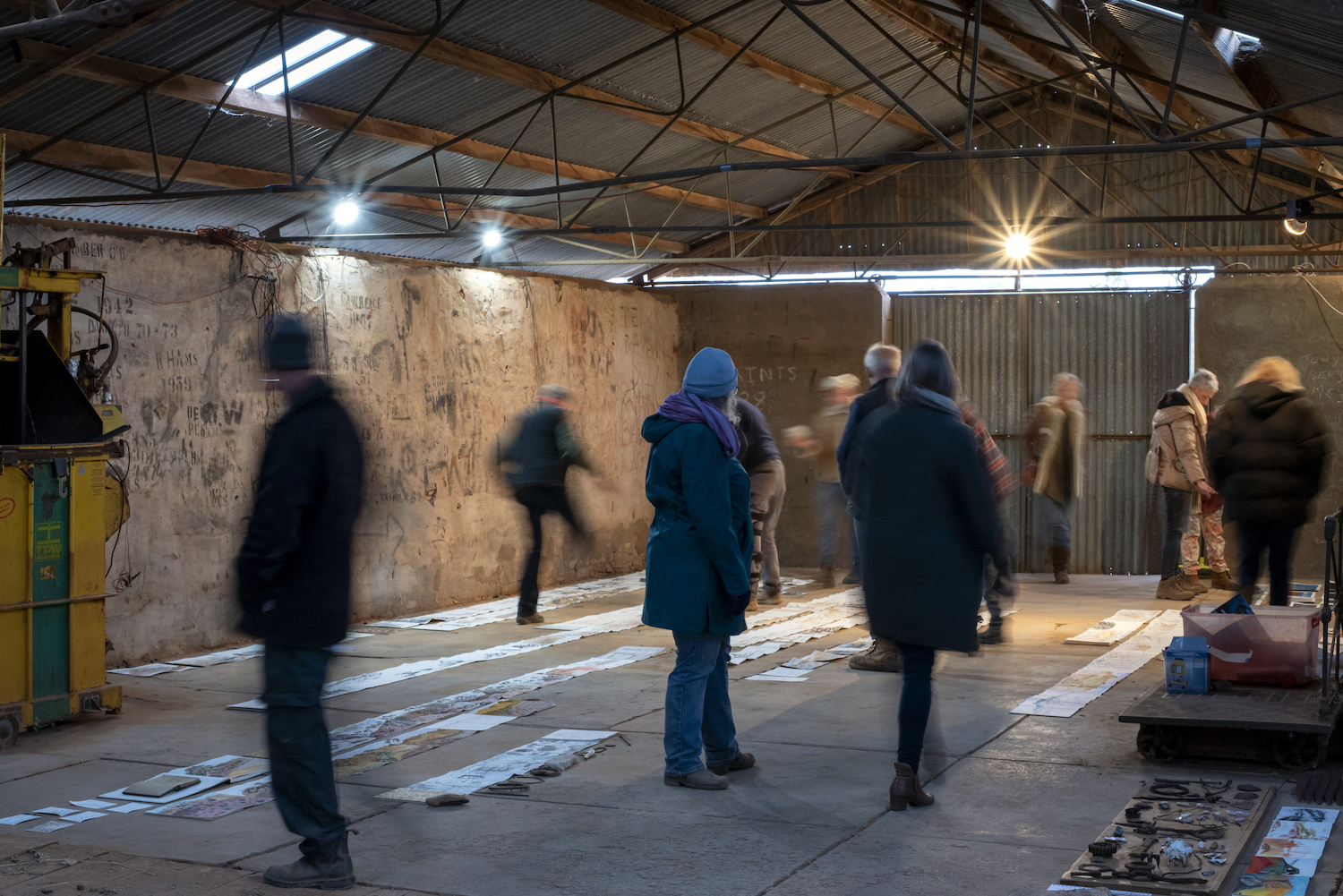
more looking at works
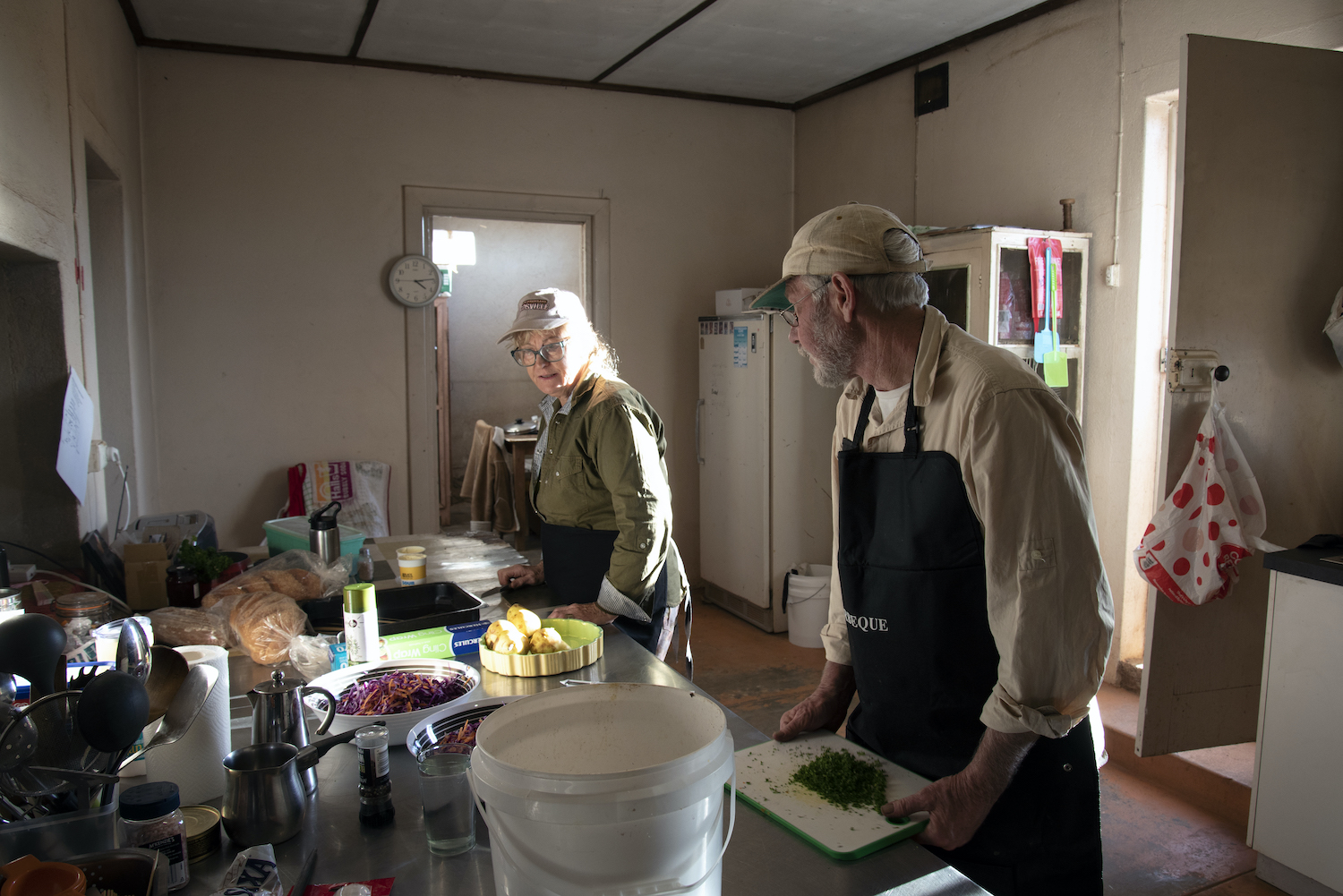
cooks prepping
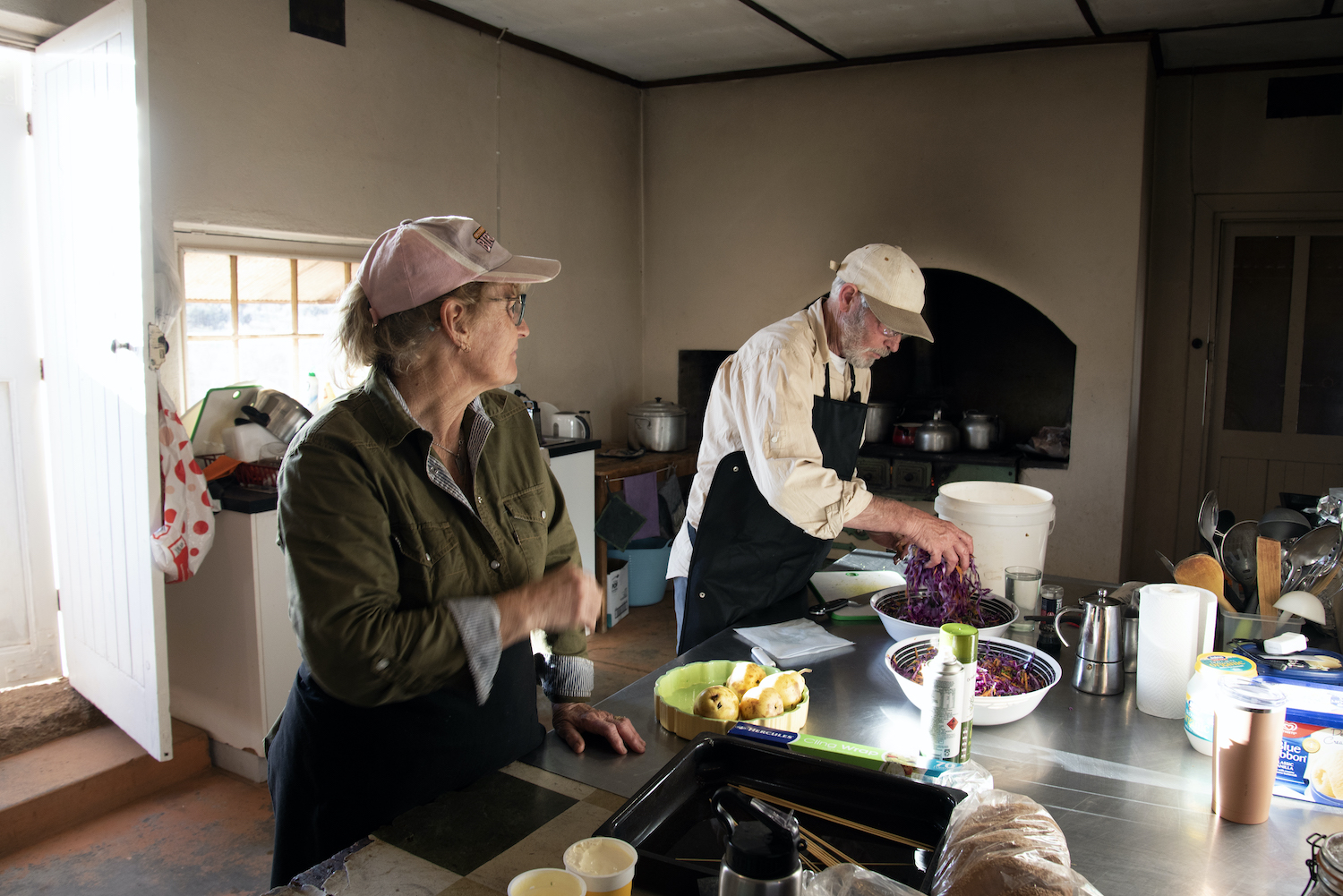
cooks prepping
Pack up Sat 29 May – site: Pitcairn Shearers’ Quarters
Collective Noun of the day: an abandon of artists
Early rise. Very chilly morning, with traces of frost on the cars. Cooks Justine and Graeme prepared a generous bacon, egg and sausage breakfast for everyone, as we all began to pack up camp. Great group photos and then the leaving. Such an extraordinary landscape and such gracious hosts, Ross and Gen Sawers. Denise and her team have much to be proud of. One of the oft-repeated comments by many of the artists was the very rare ‘luxury’ of having a period of time dedicated to concentrating solely on their art practice, in an inspiring and focussed environment. All were immensely grateful for the opportunity and it was clear from the amount and quality of work generated over five days. As John noted: “I’m impressed with how much they [the artists] have done. I think the Chinese books have struck a chord. I have felt for years that the books have some real potential in a place like Australia for the sort of landscape we have.”
We’ll reconvene next Sunday 6 June at the Burra Regional Art Gallery for a BBQ, debrief discussion and look at the two ACROSS COUNTRY exhibitions: John R Walker in the main gallery and the Artists’ Camp works in the Bence Room.
Perhaps the great Greek modernist poet, George Sefferis, sums the feeling best. Just insert ’art’ for ’poem’:
Accept who you are.
Don’t
drown the poem in deep plane trees;
nurture it with what earth and rock you have.
For things beyond this –
to find them dig in this same place.
Quote:
Jess: “It’s been lovely, a change of scenery: no internet, no service, took a bit of getting used to, not being in contact with family, but they survived.”
Anne: “What’s impressed me from Day 1 has been the focus and dedication that everyone has brought to this camp. This experience requires a certain kind of maturity and bravery: you’re in a group and have to find your place within that group, sort out the dynamics at the same time as you are also going into a landscape you don’t know with materials you are unfamiliar with….I think having a regular camp provides a kind of anchoring. People will find it opens up ways that they hadn’t seen before and gives them more freedom, more confidence to keep going.”
“Would you come back for more?” “In a heartbeat”
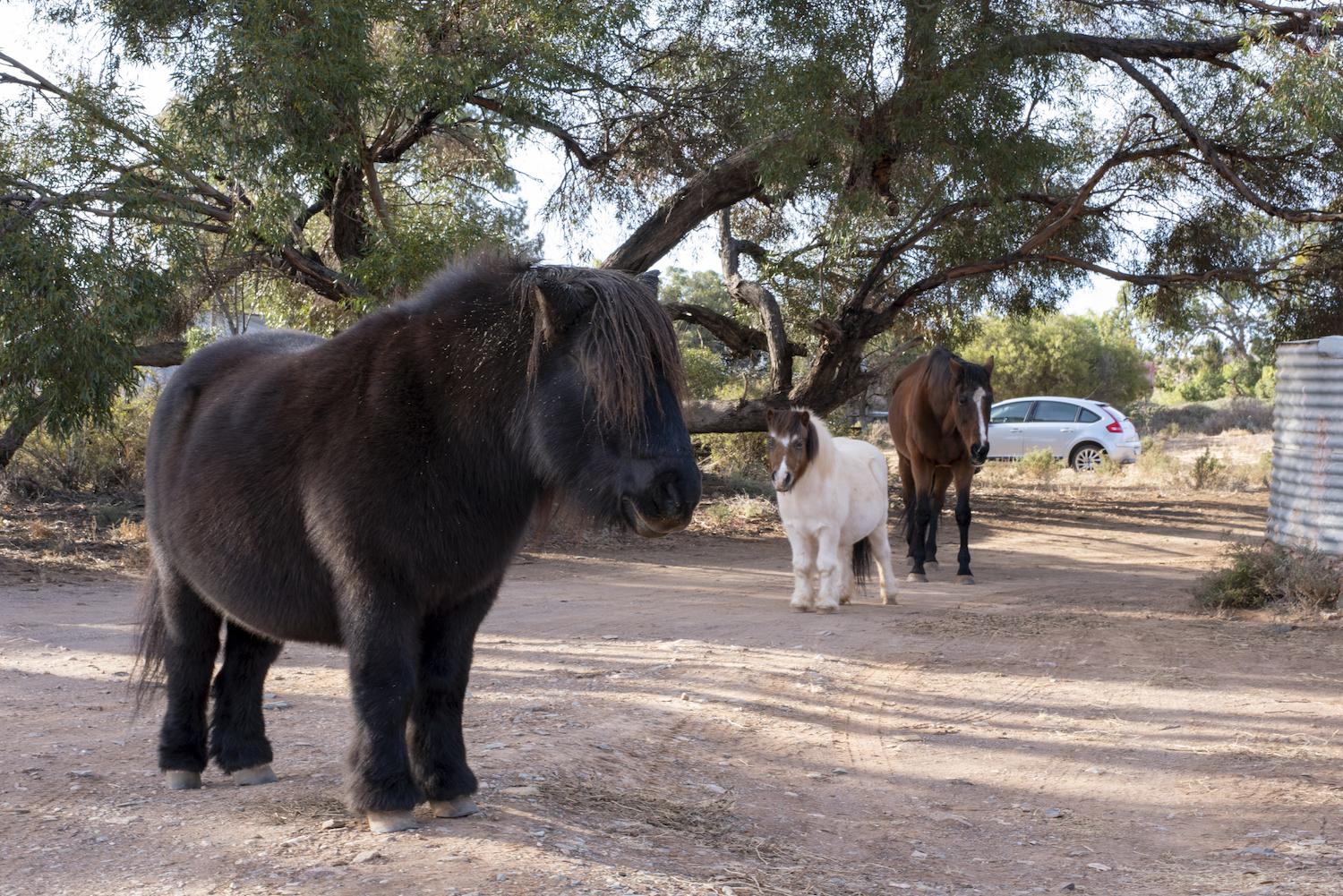
horses say farewell
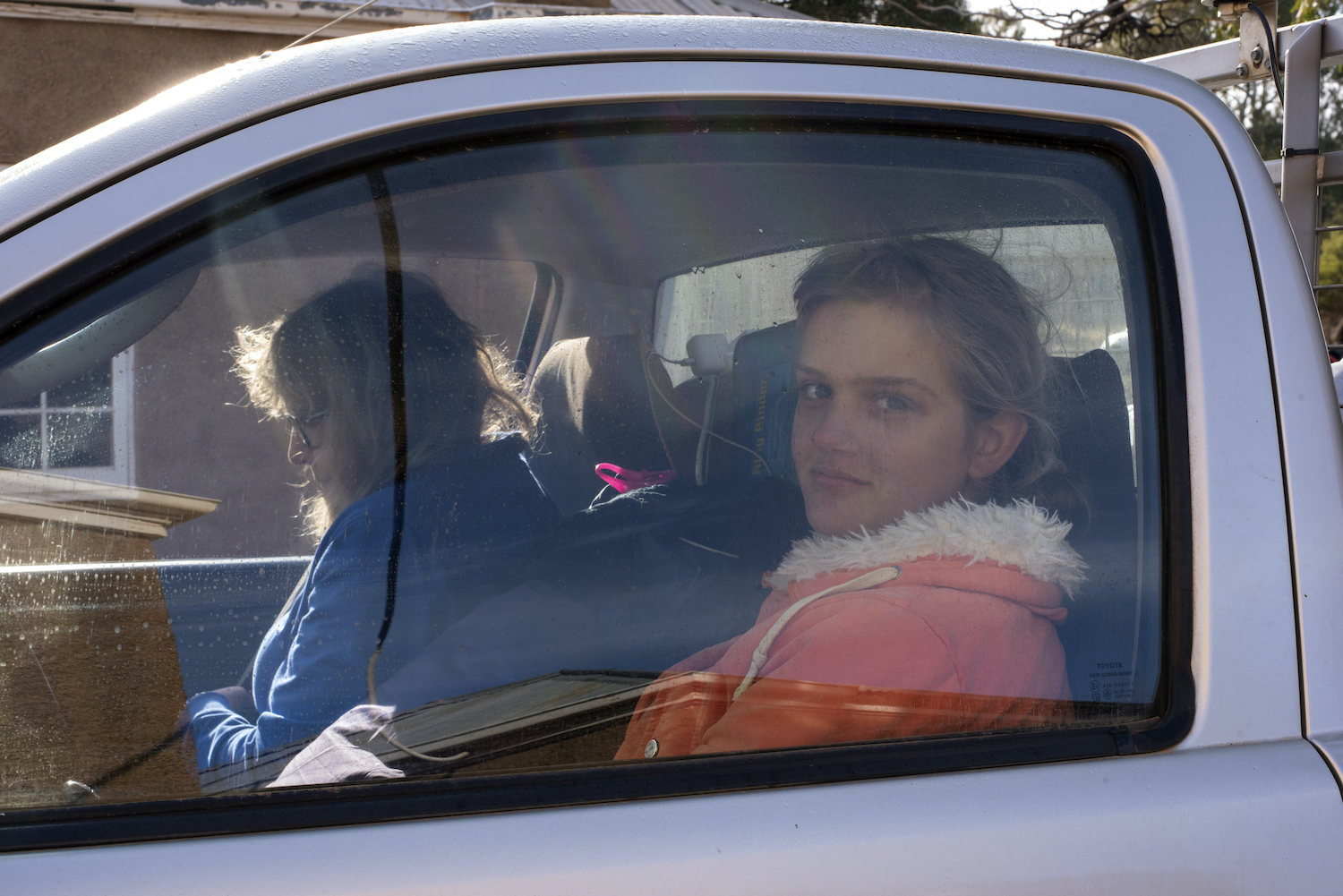
Julie and Taylah in the van
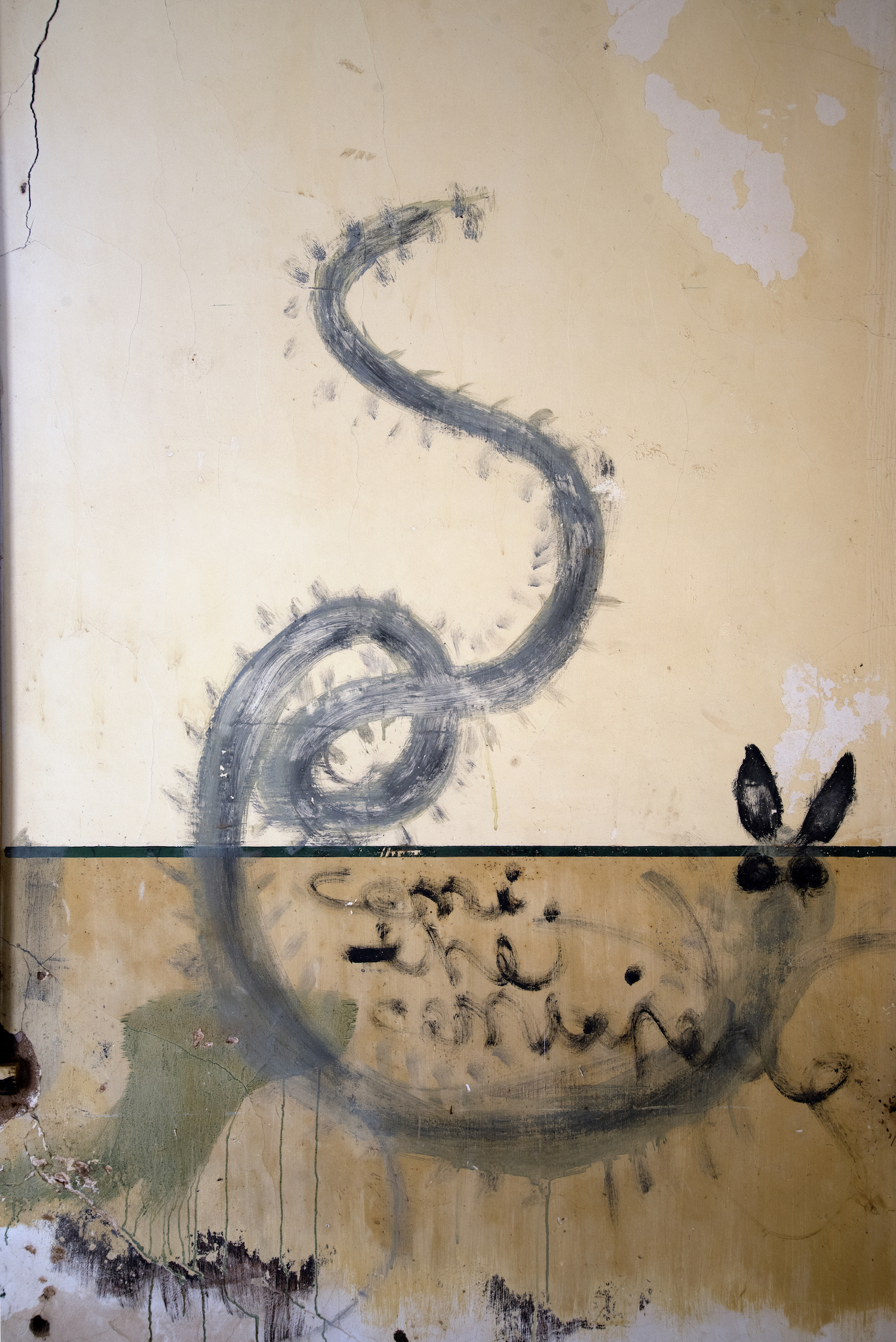
graffiti on the wall in derelict singlemans hut
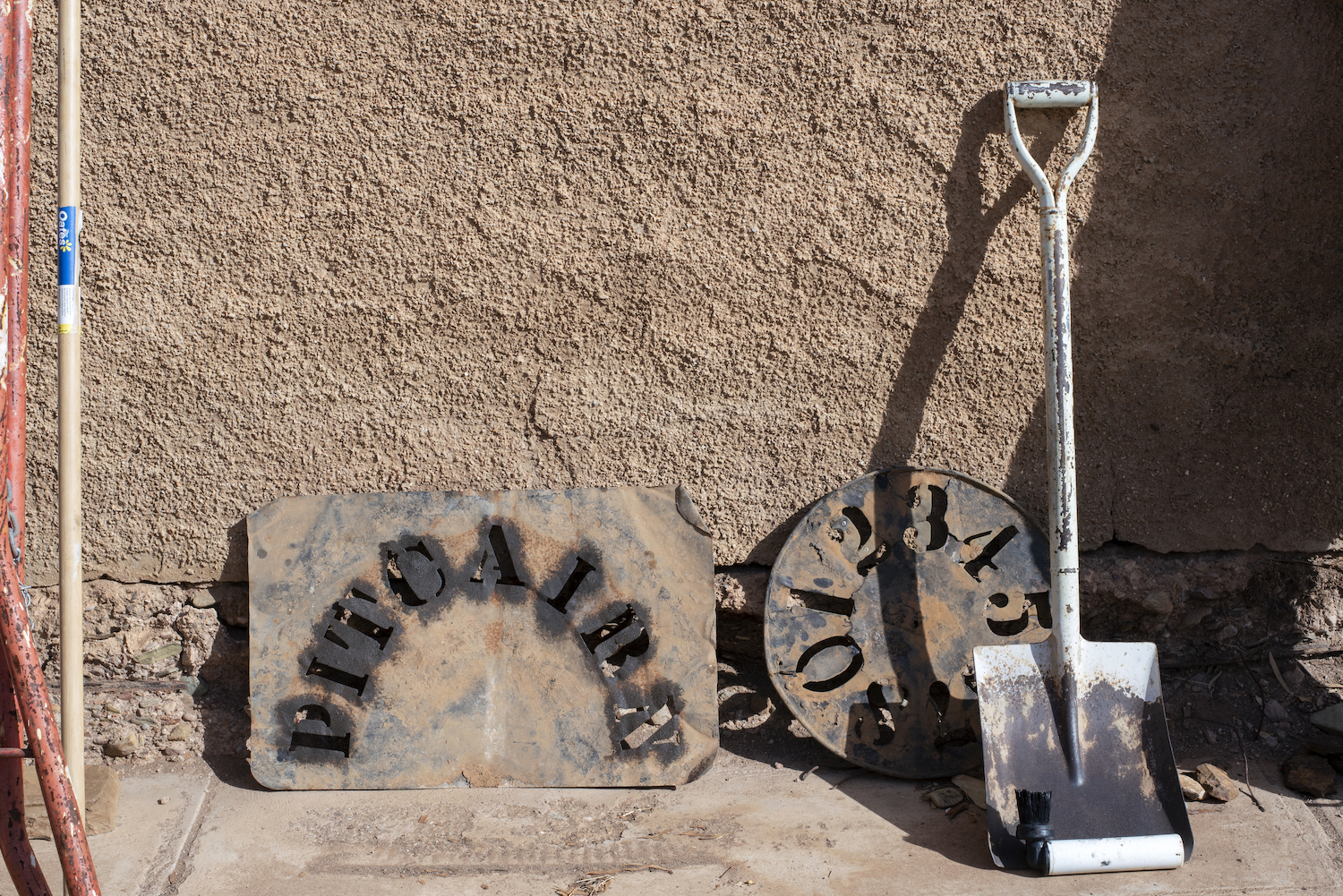
Pitcairn wool brand stencil
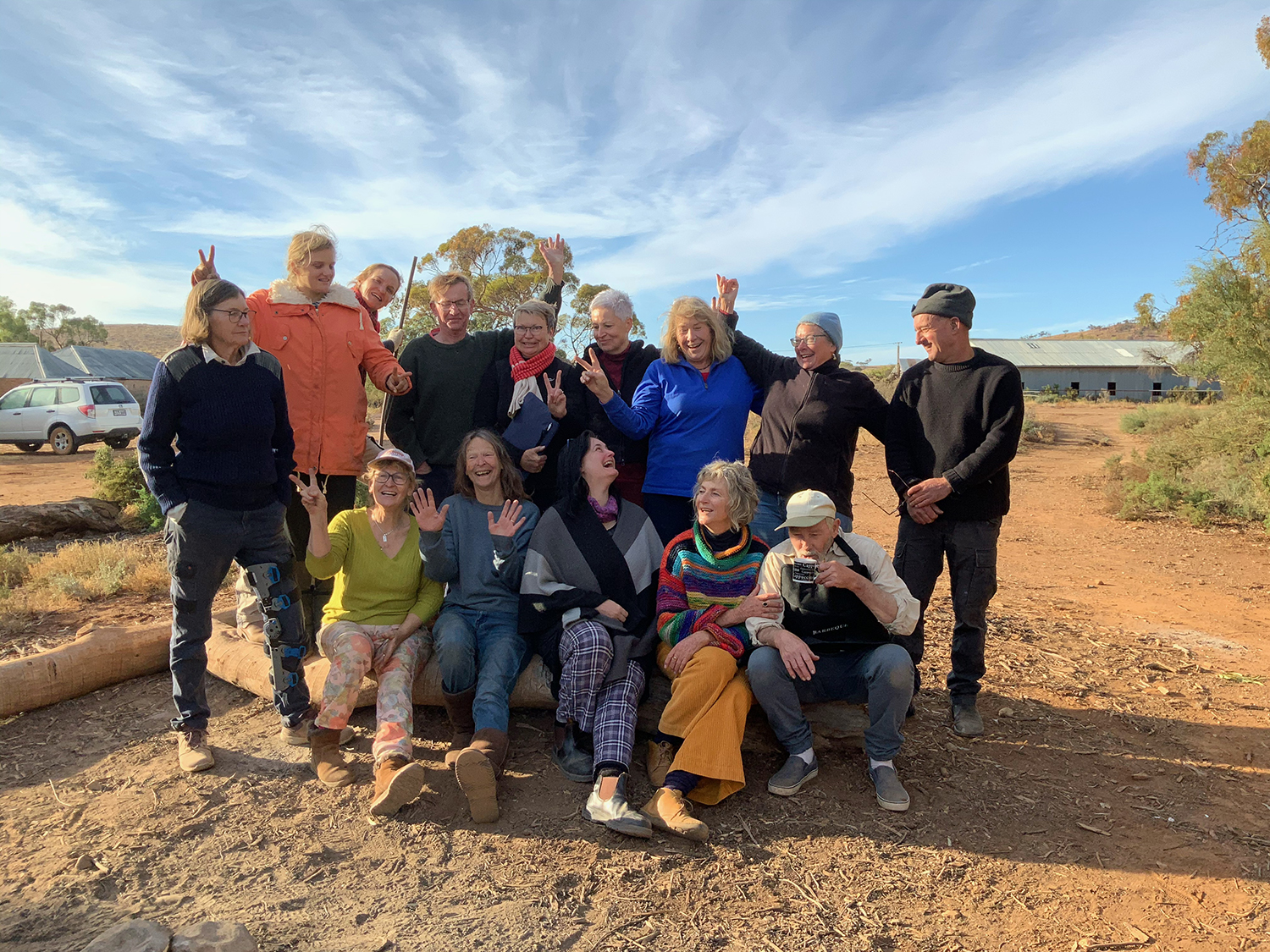
Group Photo – Photograph by Ross Sawers
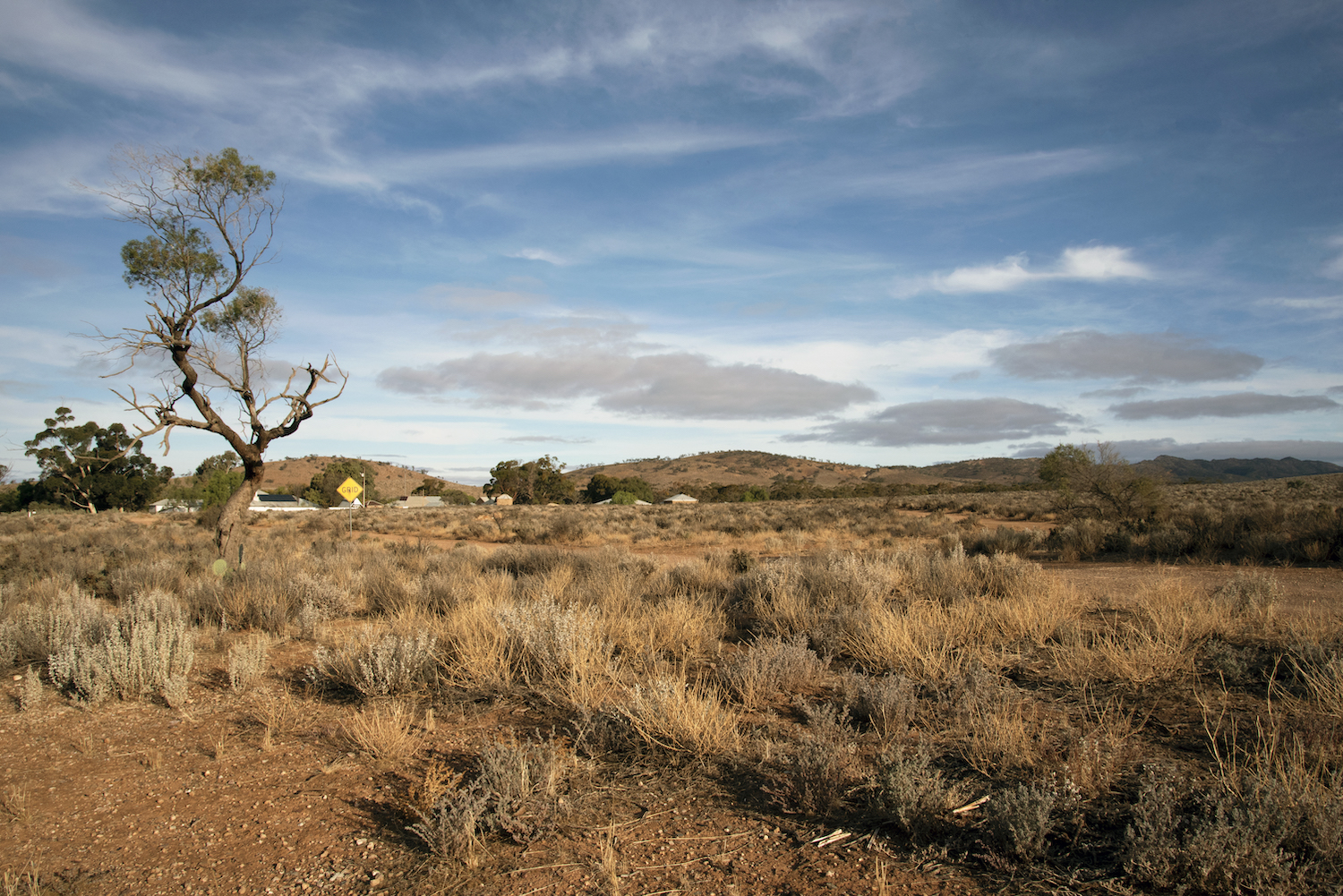
farewell to Pitcairn Station
Our cooks, sustainable food growing
Collective Noun: a champion of camp cooks
Award-winning local shearers’ cook, Justine Thomson and tapestry artist, professional chef and sustainable gardener Graeme Endean provisioned and cooked up a storm for the artist camp and residency. Locally grown or sourced produce and, assistance in returning the homestead garden to sustainable productivity, were key factors in their menu planning and project contribution.
Their prior research included a number of reconnaissance visits to Pitcairn, meeting the owners Ross and Gen and inspecting the shearers’ quarters kitchens, their domain for 9 days as they prepped, cut wood for the old stove and served up excellent, fresh, locally sourced food. This included local lamb and goat, home grown vegetables and fruit – including Justine’s homemade jams and Graeme’s brother’s caperberries, olives and Graeme’s homemade pickles – all from Burra. Support for Burra local businesses such as the IGA, Burra butcher and baker was an important consideration in the planning. As Justine triumphantly announced, nothing came out of a tin!
Running the kitchen on shearers’ quarters lines, meant we were graced with morning and afternoon teas and lunch delivered on site to wherever the artists were working. The warming homemade soups at lunch on cool windy days were greatly appreciated, as were the oven-warm cakes for tea.
Justine ran a tight kitchen, producing some wonderful desserts. We all remember the first night’s baked quince (from her garden) in a delicate custard and her delicious cakes (working wonders with the temperamental wood oven). Graeme’s delicious kasundi wraps and generous dinner menus would be hard to beat. However, it was Graeme’s assistance, working with Ross Sawers, to improve the productivity of the old homestead kitchen garden that is an on-going work-in-progress, including establishing a worm farm and functioning compost heap. They were long days, starting at sometimes 5.30am and finishing around 10pm and there were challenges as the kitchens were ‘rustic’ not having been used for years; no running hot water in the kitchen meant keeping water kettles constantly on the boil. However, their good humour prevailed.
Asked how their working relationship had survived, there was lots of jesting:
Graeme: She’s starting on me again, here we go…
Justine: It hasn’t changed a bit!
Graeme: Ha! The kitchen’s sent us a bit crazy
Justine: It’s still the same as the day we arrived
Graeme: She swears more…
Asked whether the camp had inspired his artistic side, Graeme replied:
“The landscape is inspiring. If I get a chance over the clean-up days to go and put pen to paper and maybe take some photos… I’ll just have to see how that goes but when you’ve got your cooking hat on its very hard to get the artist’s hat on.”
Our funding supporters
RAF Recovery grants administered by Country Arts SA are designed to meet the medium-term recovery needs of artists, organisations and communities and focus on activities that assist in recovery from the impacts of COVID-19. The combination of on-going drought and COVID 19 restrictions has severely impacted farming, town businesses and artists in regional South Australia. The support this project has received from RAF Recovery grant and the Regional Council of Goyder has enabled a group of regional artists to maintain their practice, providing exhibition opportunities and professional development as well as on-farm income generation for the Pitcairn landowners. As a pilot project, it has exceeded expectations, and validated the financial and in-kind support provided.
Dr Anne Sanders
